

From Rome to Tivoli: 5 Best Ways to Get There
Written by Barbara Radcliffe Rogers Updated Oct 21, 2021 We may earn a commission from affiliate links ( )
In the Sabine Hills, about 33 kilometers east of central Rome, Tivoli makes a perfect day trip from the city, especially in the summer, when its elevation brings cooling breezes. That's why in the time of the Roman Empire, the emperors and nobility chose Tivoli as a location for their magnificent summer villas. Two of these are the main reason for visiting; today Villa Adriana (Hadrian's Villa) and the gardens of Villa d'Este are both UNESCO World Heritage Sites .
There are several ways of getting from Rome to Tivoli. Taking a tour is one of the simplest options, but you can also use public transport or drive. Plan your visit with our list of the best ways to get from Rome to Tivoli.
On This Page:
- From Rome to Tivoli by Tour
- From Rome to Tivoli by Train
- From Rome to Tivoli by Bus
- From Rome to Tivoli by Car
- From Rome to Tivoli by Towncar or Taxi
1. From Rome to Tivoli by Tour
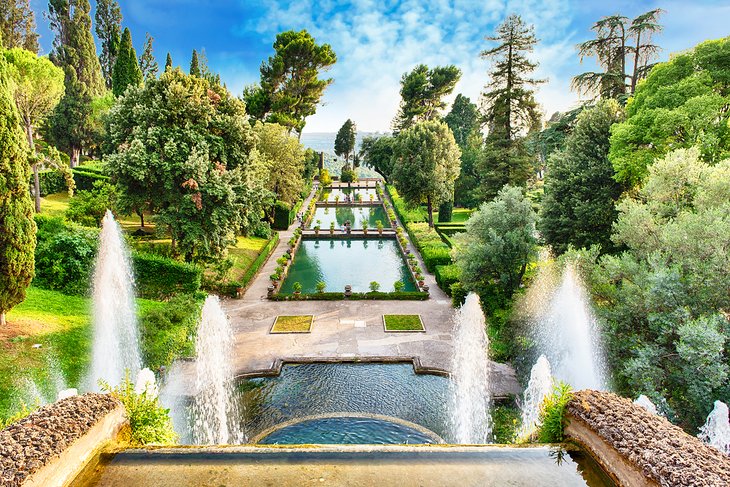
For a completely carefree day with someone else doing the driving and taking you to each of the attractions, a tour can be the best answer. The Tivoli Day Trip from Rome: Hadrian's Villa and Villa d'Este takes you seamlessly from Rome to each of the two UNESCO sites, adding guided walking tours of each to be sure you don't miss the highlights. The group tour lasts about seven hours, during which you will learn about the history of these grand estates as you explore them.
If you prefer to spend more time in Rome, but still see Tivoli's villas, consider the shorter version of that trip, with the four-hour Hadrian's Villa and Villa d'Este Half-Day Trip from Rome . You'll have round-trip transport by air-conditioned coach from Rome and visit each of the two outstanding villas with a guide to learn about the buildings, the gardens, and their owners.
For a more custom-tailored experience, the From Rome to Tivoli Gardens with Guide and Tickets tour includes door-to-door transport for your party by private vehicle. Once in Tivoli, your driver will introduce you to your professional art historian guide , who will accompany you throughout your two-hour visit to each of the villas.
2. From Rome to Tivoli by Train
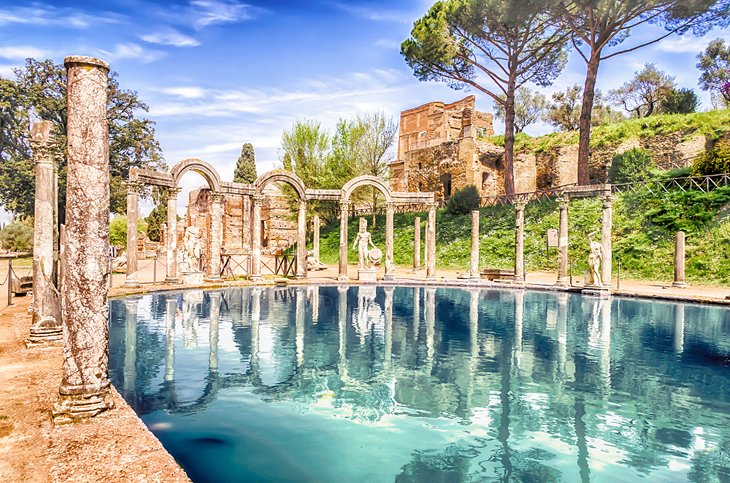
The Roma-Avezzano-Pescara regional (Regionale) line departs from Rome's Tiburtina rail station almost hourly (but with a curious gap between 9am and 11am). Check for trains marked for both Tivoli and Avezzano , as either will take you to Tivoli. You can get to Tiburtina station on Rome's Metro B (blue) line. It's a good idea to buy tickets in advance online. You can also get them in ticket machines or at a ticket counter in the station, but there might be lines at both during busy times.
The train takes between 45 and 75 minutes from Rome to Tivoli's Tiburtina Station , depending on the number of stops. The route by train is a very beautiful one as you climb into the wooded Sabine Hills. Once in Tivoli, you are about a 25-minute walk from the center of town and Villa d'Este, and about five minutes from Villa Gregoriana. The local C.A.T. bus line runs a regular route between the station, Villa D'Este, Villa Adriana, and Villa Gregoriana.
3. From Rome to Tivoli by Bus
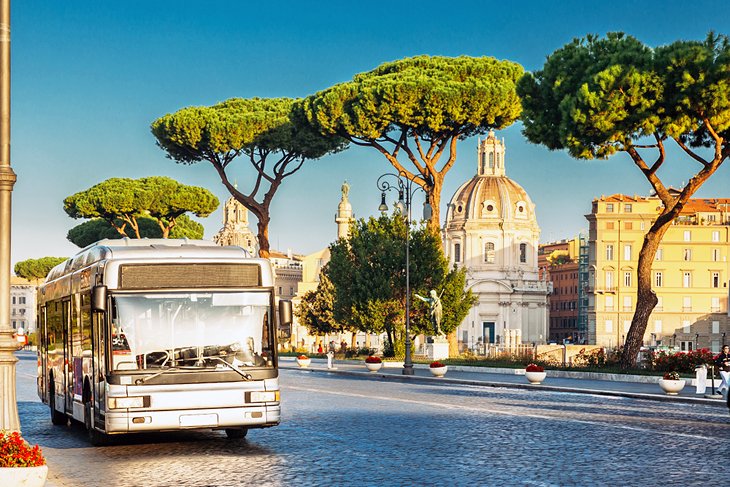
Blue COTRAL buses to Tivoli leave the terminal at Rome's Ponte Mammolo stop on Metro line B. It takes about an hour to get to Tivoli , depending on traffic. Departures are every 10 or 15 minutes, Monday through Saturday, less frequent on Sunday. Bus fares are quite cheap, but so are train fares, and the train makes fewer stops on the way. The bus takes you to the main square, where you can walk to Villa d'Este or catch the local shuttle to visit Villa Adriana.
4. From Rome to Tivoli by Car
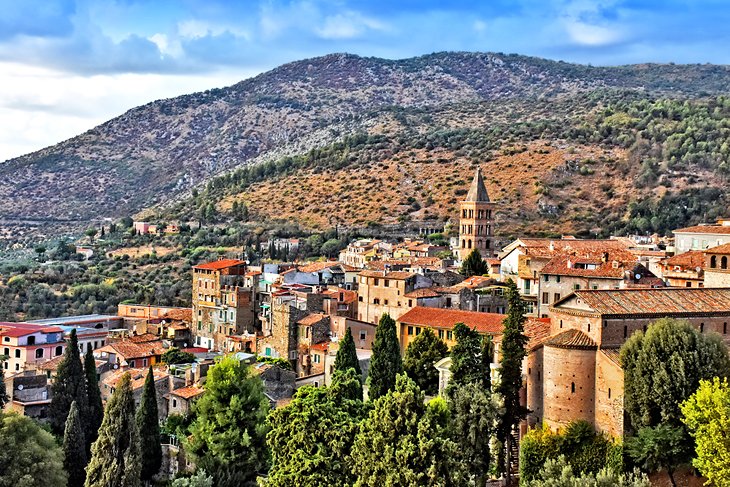
The short drive from Rome to Tivoli takes only about 35 minutes under the best of conditions but can take twice that when the traffic is heavy. The fastest route is on the A24 , which you can reach from the Tangenziale Est/Circonvallazione Tiburtina in Rome. Follow A24 to Via Maremmana Inferiore/SP51a in Tivoli, taking the exit toward Tivoli.
There are multi-level public parking garages within a couple of blocks of the entrance to Villa d'Este, but they fill fast in busy seasons, and on-street parking is hard to find. If you are coming from Rome on a day trip, especially at the height of tourist season, it may be easier to take public transportation, especially if you are not accustomed to driving in Italy, which can be nerve-wracking.
Prices of rental cars in Rome vary widely, from mini models like the four-passenger Fiat 500 to larger more luxurious models. But whatever car you choose, be sure to reserve it well ahead of your trip, as availability of rental cars is expected to remain tight. It is also usually a good idea to reserve through a company with offices in your home country, such as AutoEurope in the United States. This way, should there be any problem with the reservation, you have someone who speaks your language to sort it out.
If you are heading north by car from Rome to Orvieto and Perugia , Tivoli is a good side trip on your way. Leave Tivoli heading west on the SR5 and join the E45 autostrada at Tivoli Terme.
5. From Rome to Tivoli by Towncar or Taxi
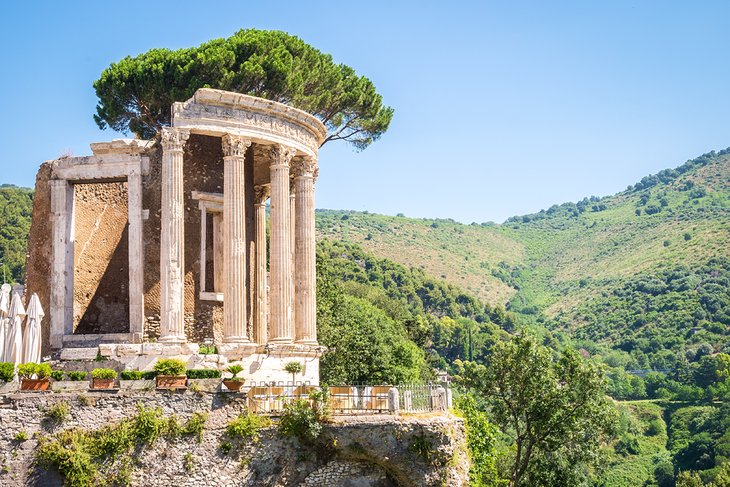
To arrive and return on your own schedule and in the comfort and privacy of a roomy air-conditioned car without the stress of driving–or parking, private transport or taxis may be the best choice. They cost more, but offer considerably more luxury and flexibility, with door-to-door pickup and a professional driver . And for families or groups sharing the cost among several people, the cost per person becomes less. The rates of a private transport service and taxi service are similar, and you can expect to pay about '70 each way for either.
More Related Articles on PlanetWare.com

Where to Go in Rome: PlanetWare has several articles to help you explore the tourist attractions of Rome , with guides to the Roman Forum , the Pantheon , the Colosseum, and Vatican City .
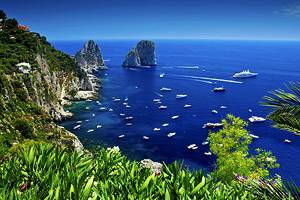
Where to Go from Rome: After visiting Tivoli, you may want to take more day trips from Rome. You can easily visit the tourist attractions in Naples , and the island of Capri is another possibility; our article From Rome to Capri: 5 Best Ways to Get There can help you plan your trip.

More on Italy

- TAXI FARES CALCULATOR
- BOOK PRIVATE TOUR
- Hotels with Best Views
- Hotels near Termini
- Hotels near the Colloseum
- 3 Star Hotels
- 4 Star Hotels
- 5 Star Hotels
- Apartments For Rent
- Best Hostels
- Fiumicino Airport
- Ciampino Airport
- Termini Railway Station
- To Florence
- To Ostia Antica
- Famous Roman Dishes
- Best Pizza Places
- Best Pasta Places
- Local Italian Food
- Best Gelato Places
- Best Rooftop Bars
- Sistine Chapel
- Vatican Museums
- Borghese Gallery
- Roman Forum
- Trevi Fountain
- Spanish Steps
- Castel Sant’Angelo
- Navona Square
- Ancient Sites and Ruins
- Galleries and Museums
- Parks and Gardens
- Squares and Fountains
- Beaches near Rome
- To Alberobello
- How to Choose a Hotel in Rome
- 2025 Pilgrims of Hope Jubilee
- Rainy Days in Rome
- What to See in 3 days
- Buying a Sim Card in Italy
- Tickets to Vatican museums
- Renting a Car in Rome
- Apps for Tourists
- Souvenirs from Rome
- Free Things to Do
- Unusual Things to do
- Public Transport
- Campo Marzio
- Jewish Ghetto Quarters
- Quartiere Coppedè
- Sant’Eustachio
- Marcus Aurelius
- Gaius Julius Caesar
- Octavian Augustus
- Italian food and wine
- Sightseeing Tour at Sunrise
- Sightseeing Tour by Car
- St Peter’s Basilica
- Colosseum & Roman Forum
One-day trip to Tivoli from Rome
Written by: Kate Zusmann
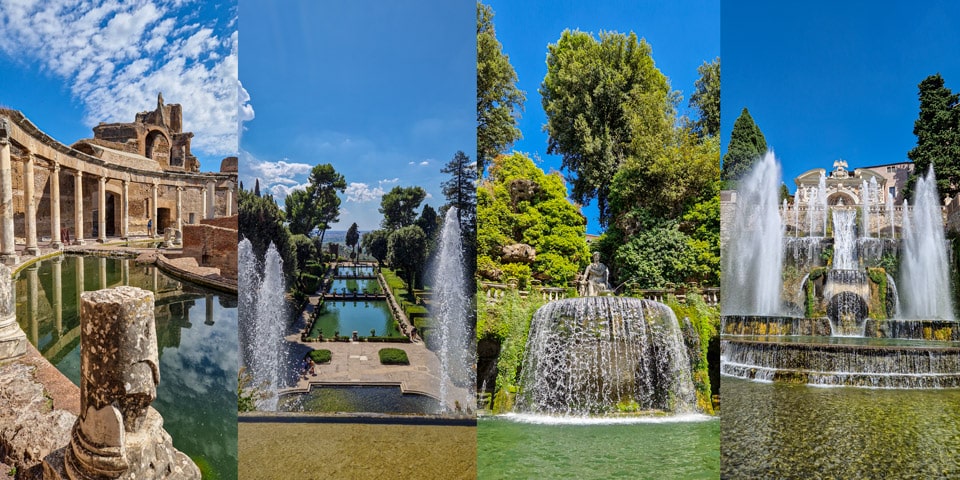
Tivoli is a town with a long history, including the famous Hadrian Villa (Villa Adriana), Villa d’Este, villa Grigoriana, remains of Roman aqueducts, a medieval castle, and several beautiful churches. It is one of the best options for a day trip from Rome that will not leave anyone indifferent.
What do You Need to Know before Traveling to Tivoli
What is tivoli in italy known for, how much time do you need in tivoli, italy, what is the best option to visit tivoli, how much time do you need at hadrian’s villa, what does tivoli mean in english, how much time do you need at villa d este, how many fountains does villa d’este have, who owns villa d’este in tivoli, what is the cheapest way to get from rome to tivoli, why did emperor hadrian decide to build a villa in tivoli, why was the dynasty of d’este so important, tivoli main sights – what to see.
Both Villa d’Este and Villa Adriana are full of beautiful places. One surprises with its charming fountains, impressive arts, and views of Rome, while another is the historical gem that initially consisted of 35 marble buildings on more than 200 hectares.
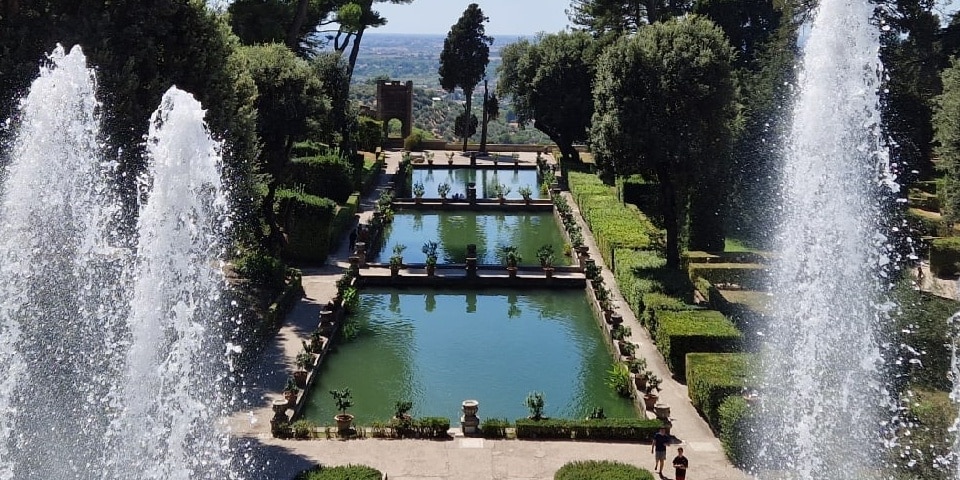
Villa d’Este
The Villa d’Este in Tivoli, with its palace and garden, is one of the most remarkable and comprehensive illustrations of Renaissance culture at its most refined. Its innovative design and architectural components (fountains, ornamental basins, etc.) make this a unique example of an Italian 16th-century garden. The Villa d’Este, one of the first “Giardini delle meraviglie,” was an early model for European gardens.
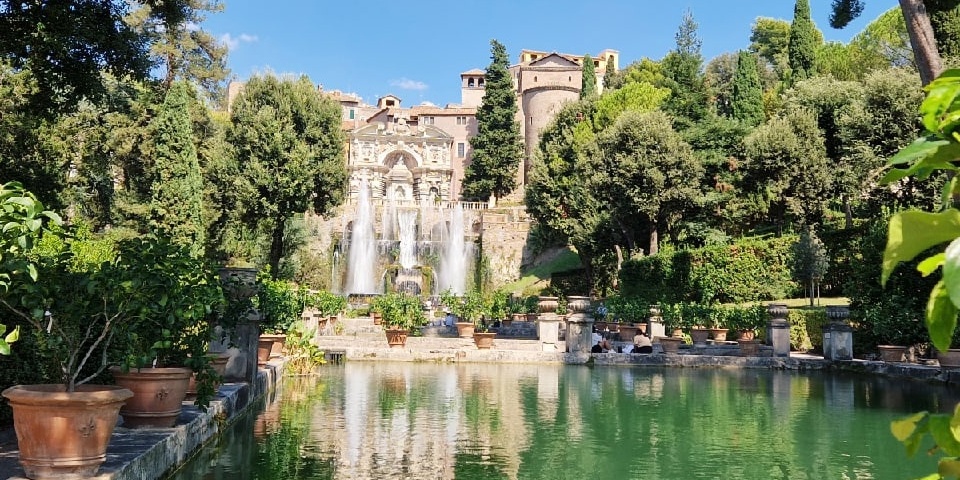
Villa d’Este belonged to Cardinal Ippolito II d’Este, who was a great connoisseur of art. The project’s development to reconstruct the Villa began in 1550; however, the cardinal approved the final version only 10 years later. The author of the project was Pirro Ligorio, an architect and expert in his field who had previously been in the service of the papal court and had worked on such masterpieces as Bomarzo’s Monster Garden (Parco dei Mostri) and the papal palace in the Vatican (Casino di Pio IV in the Vatican). His greatest masterpiece, however, was the Villa d’Este.
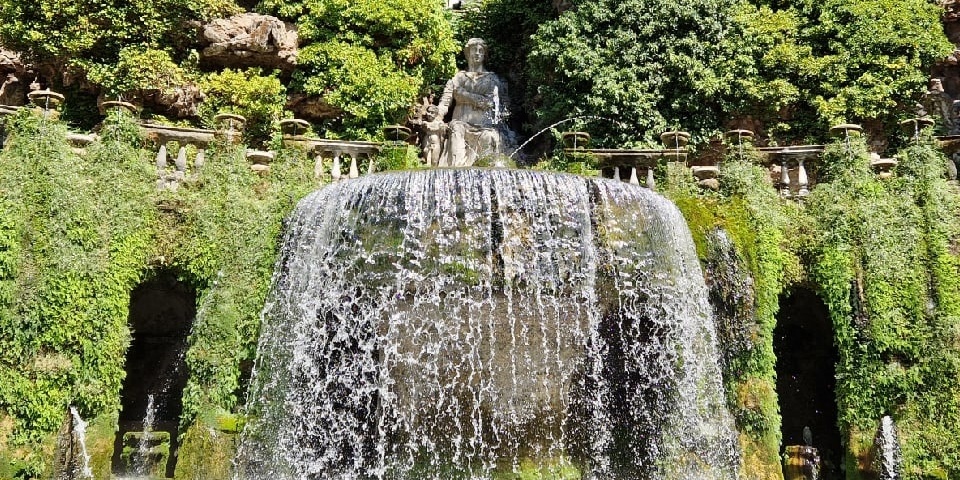
The villa’s luxurious design emphasized its status as a cultural center. The interior decoration of the castle began in 1563, and by the time of the death of the cardinal (1572) was almost completed.
The renovation of the park began in 1605 by Ippolito’s successor, Alessandro d’Este, who hired the great architect Gian Lorenzo Bernini for this purpose. Unfortunately, in the 18th century, due to the lack of proper care, the Villa fell into a deplorable state: the water supply that fed the numerous fountains was outdated, and the statues and decorative buildings began to crumble.
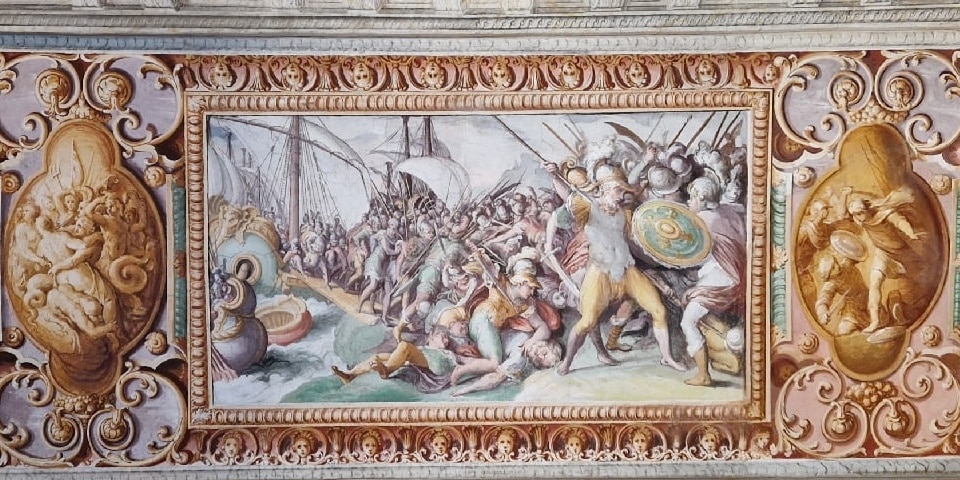
The estate passed into the possession of Franz Habsburger. Later, right before the First World War, the new owner of the Villa became Archduke Franz Ferdinand. Finally, at the end of hostilities, the state nationalized the Villa. The last restoration was carried out after the end of World War II.
How to get to villa d’Este on your own?
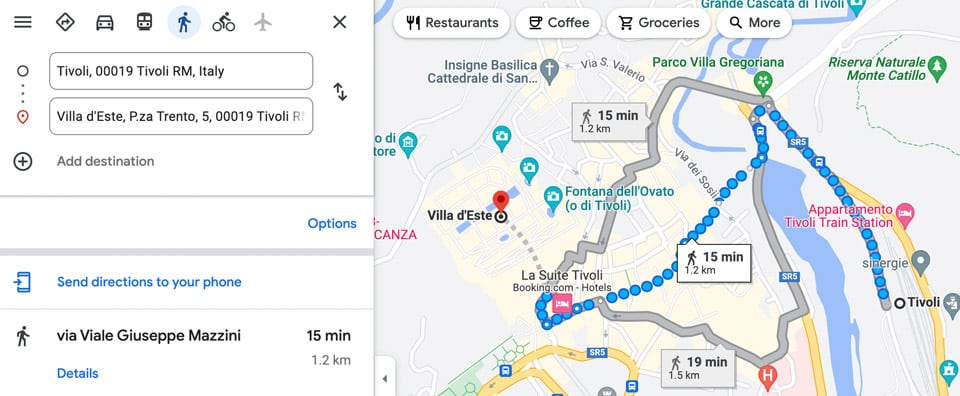
Entrance fees are:
- €13 for an adult €2 for a reduced ticket Children under 18 are free.

Explore Rome in the most comfortable way!
from €150.00
You can purchase tickets on the official website
Opening hours
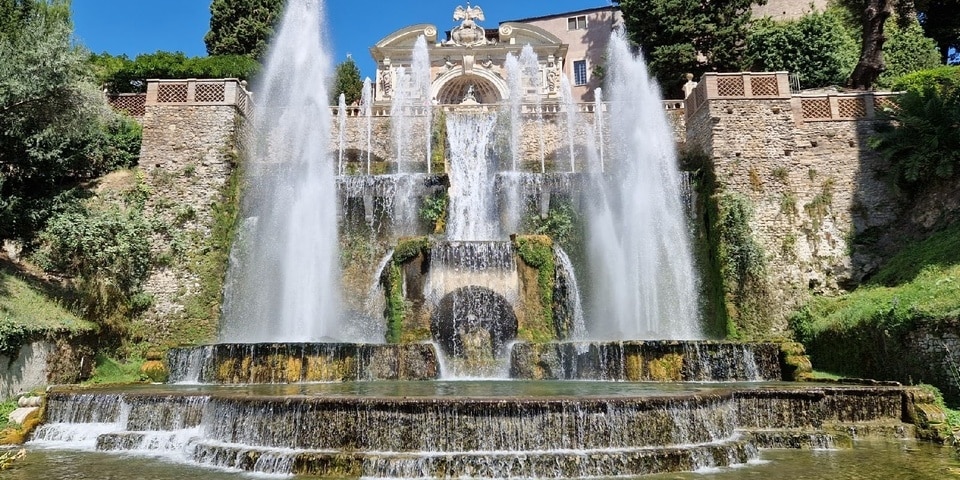
The main Villa d’Este building is open from 08:45 – 19:45 every day except Monday when it opens at 14:00. You can access Tivoli Gardens from 08:30, but the gardens close at different times during the year:
- January: 16:45 February: 17:15 March: 18:00 April: 19:15 May-August: 19:30 September: 19:00 October: 18:15 (or from 17:15 when winter-time begins) November and December: 16:45
Hadrian’s Villa
The Hadrian’s Villa (Villa Adriana) is a magnificent complex of ancient structures built in the second century AD in Tivoli by Hadrian , the Roman emperor. It unites the most acceptable characteristics of Egyptian, Greek, and classical Roman architecture.
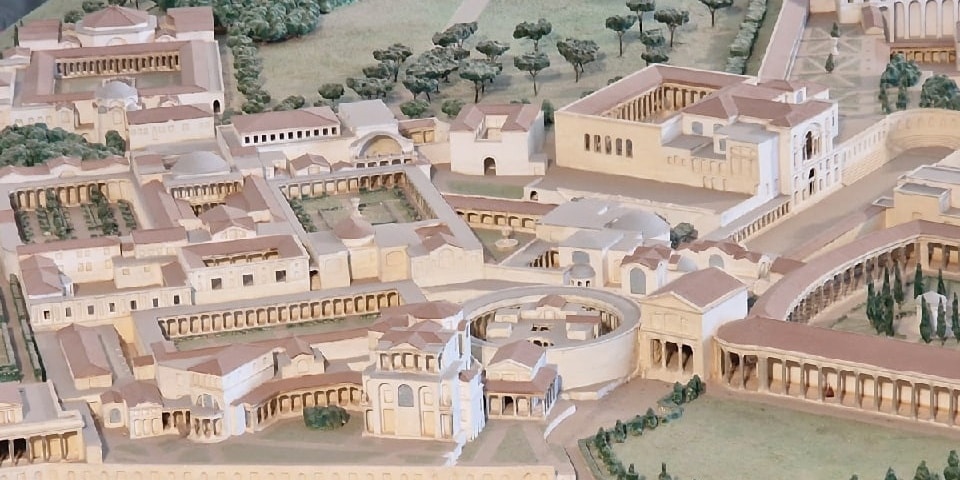
Villa Adriana was built because Hadrian, dissatisfied with the palace on Palatine Hill , wanted a place to escape. Several successors inhabited it after his death but finally fell out of use and were left in ruins, then stolen.
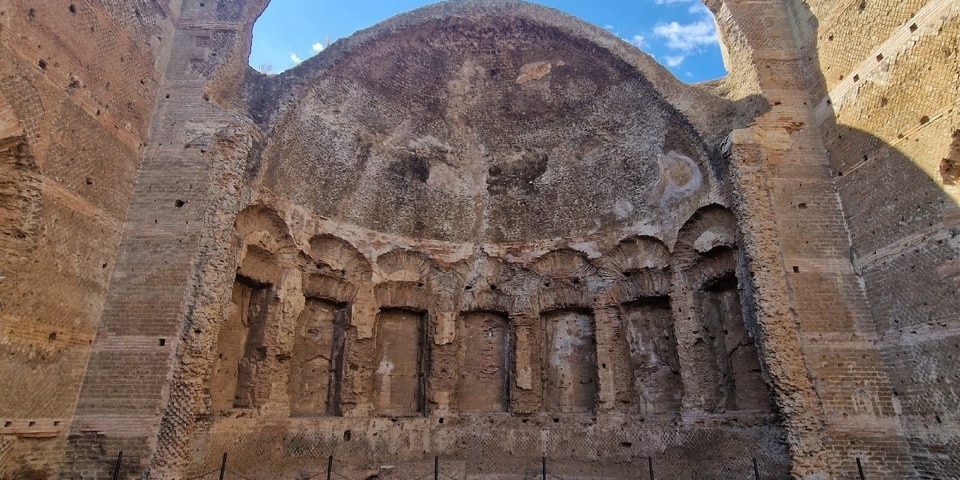
A copy of a sanctuary close to Alexandria is one of the Villa’s key highlights. It is a large pool surrounded by columns and adorned with caryatid statues.
Also, a building known as the Maritime Theatre, a circular pool surrounded by columns with an island in the middle, is situated among the libraries, restrooms, guest houses, gardens, fountains, and ponds. There is a small Roman villa on the island.
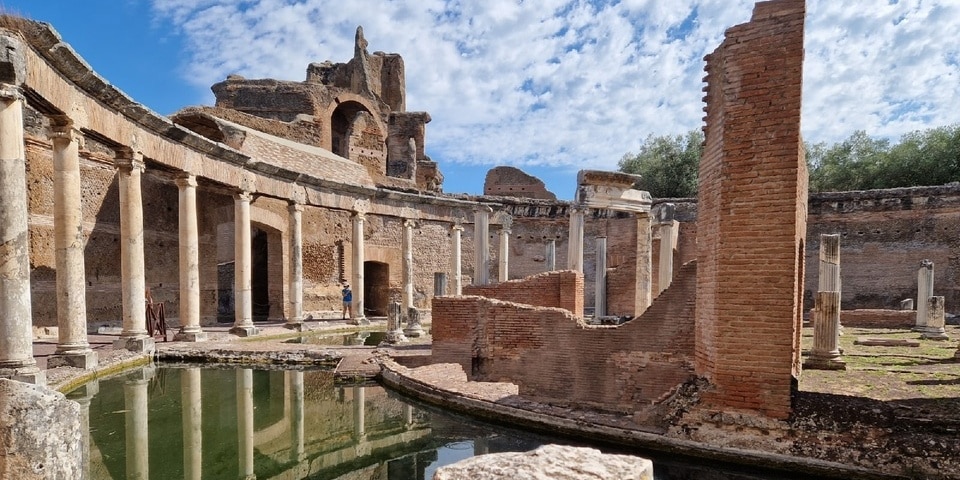
How to get to Hadrian’s Villa on your own?
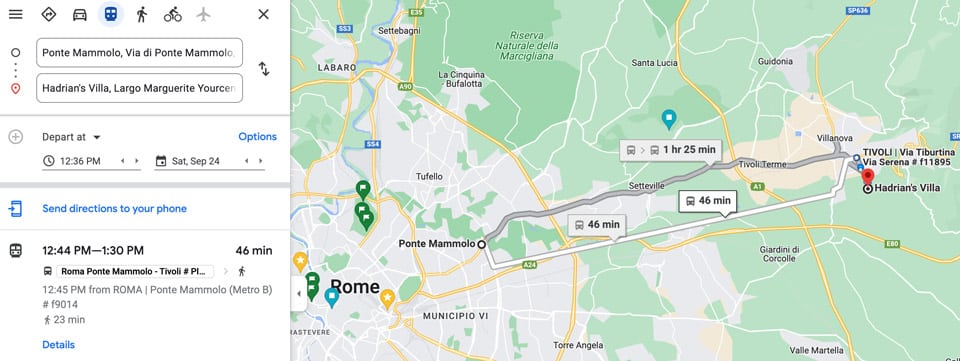
- €12 for an adult €2 for a reduced ticket Citizens of Tivoli and neighboring municipalities: €6 Children under 18 are free.
You can purchase tickets on the official website
- From February 28th to March 26th: From Monday to Sunday, Villa Adriana is open from 08.30 to 18.30
- Mouseia from 10.00 to 17.30
- The ticket office and the entrance close an hour and a half earlier
- From March 27th to September 18th: From Monday to Sunday, Villa Adriana is open from 08.15 to 19.30
- Mouseia from 10.00 to 18.30
- August 11th: Opening of the site with extended hours from 8:15 to 22:00 (villa exit 11:30 pm)
- CLOSING: January 1st and December 25th, except for extraordinary openings based on the MiC project
The Temple of Vesta
One of the most significant buildings in the old acropolis of Tivoli is the Temple of Vesta. It is close to the Sibyl Temple. The Ponte Gregoriano provides access to the temple through a gate (bridge). The most well-known structure in ancient Tibur dates to the first century BC.
It was likely dedicated to Tiburon, the hero who gave the city its name, or perhaps to Vesta, the goddess of the hearth whose cult was conducted by the Vestals. The temple, with its beautiful round shape, looks out over spectacular views. Italian and international artists and wealthy aristocrats who used their wealth to commission paintings have made the Temple of Vesta their most popular subject over the years.
How to get to the Temple of Vesta on your own?
Villa gregoriana.
Villa Gregoriana, a gorgeous natural park close to Rome, is a complex of wooded gardens, pathways, waterfalls, and flora that stretches to the foot of the ancient acropolis. When 19th-century artists and aristocrats visited the old city of Tibur as part of their “grand tour,” they had to see this magnificent, untouched location, which Pope Gregory XVI had commissioned sometime around 1834.
The Fondo Ambiente Italiano, often known as FAI (the Italian Environmental Fund), is in charge of protecting and managing the entire area surrounding the Villa. It is regarded as one of a kind in the world since it is a location where the remarkable beauty of the surrounding landscape coexists with the priceless marble and old villa ruins of Publius Manlius Vopisco.
Both the Grottoes of Neptune or Grottoes of the Sirens, river-eroded caves, and the Great Waterfall are world-famous highlights of Villa Gregoriana. The Gregorian Bridge, an extraordinary building, commissioned by Pope Gregory XVI and connects the park to Tivoli’s old town center, is located next to the remarkable Villa. The historic acropolis and the Aniene valley may be seen well from the bridge.
How to get to Villa Gregoriana on your own?
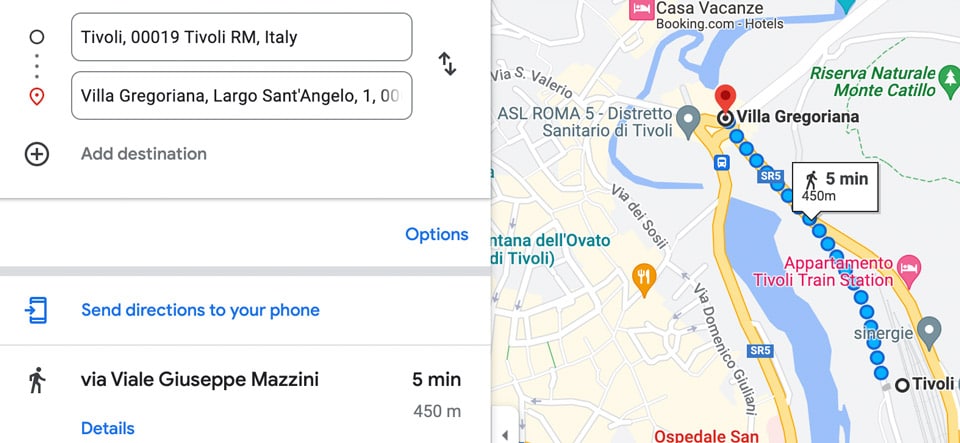
- €8 for an adult €3 for a reduced ticket Citizens of Tivoli and neighboring municipalities: €2.5 Children under 18 are free
- From Tuesday to Sunday (March, November, and December): 10 am to 4 pm; the last admission at 3 pm.
- From Tuesday to Sunday (April to October): 10 am to 6.30 pm; the last admission at 5.30 pm.
Our partners organize one-day group tours to Villa Adriana and Villa d’Este from Rome. The duration is about 7 hours, and you explore both villas with a professional tour guide.
Experience and review
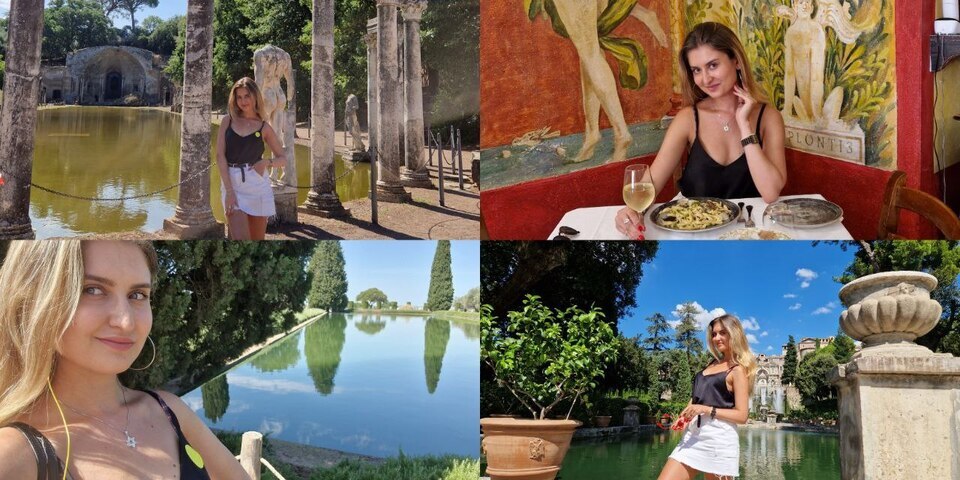
The tour starts from the area near the Colosseum, so it is very convenient to get there from any part of the city. First, you head to Villa Adriana from Rome, where you spend about 1.5-2 hours, and then, by lunchtime, you arrive at the historical center of Tivoli.
The feature I liked is that you have free time to explore Tivoli and have lunch in one of the local restaurants without being in a hurry. After the lunch break, the group meets near the entrance to Villa d’Este to start an adventure to one of the most worldwide known villas. Do not worry; you will have enough time to take beautiful photos and buy souvenirs .
Here’s the link to the group tour I’ve visited
Private tour to Tivoli from Rome
If you want to visit the main attractions of Tivoli in the most comfortable way, then the best choice is a private tour with a professional guide . You will be picked up directly from your hotel in Rome , taken to Tivoli, and told exciting stories and interesting facts.
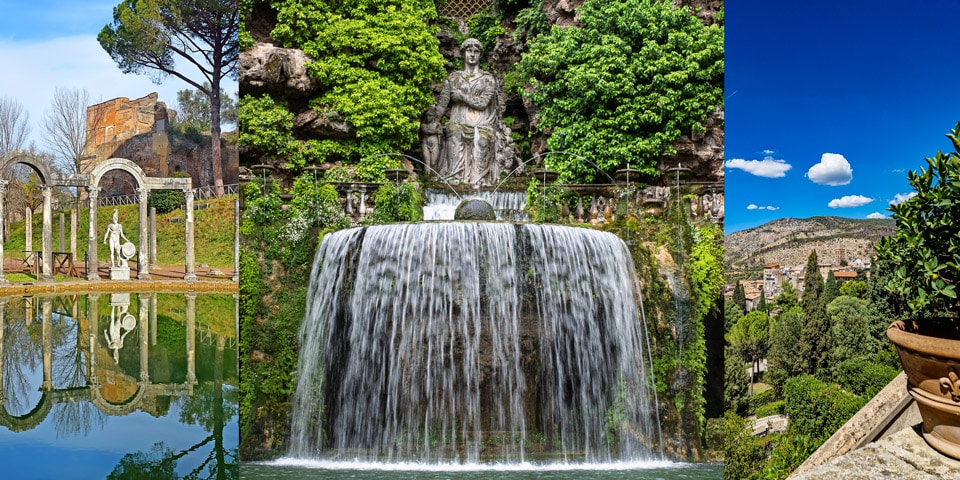
The tour costs 400 to 700 euros, depending on the duration and number of people. For details, please send an inquiry via this contact form .
How to get from Rome to Tivoli on your own?
There are several ways to get from Rome to Tivoli on your own. The fastest, cheapest, and easiest way to get to Tivoli is by train.
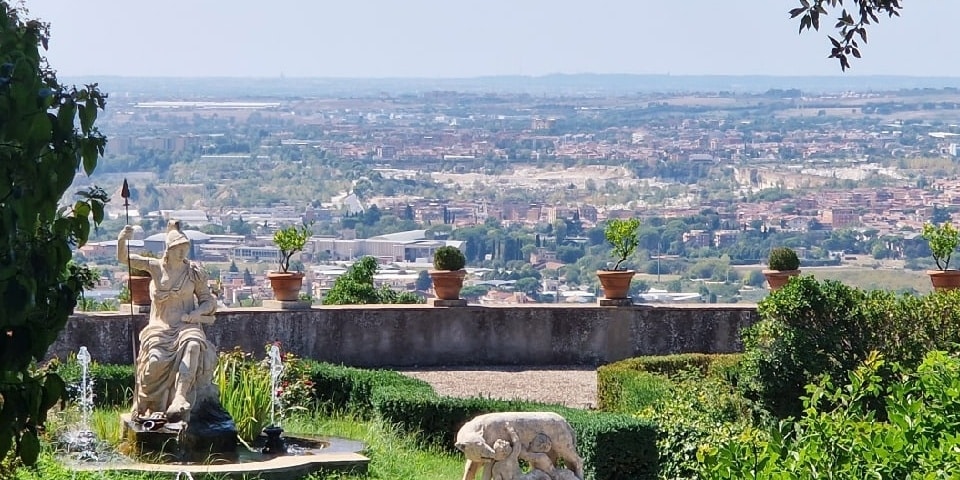
The FL2 Trenitalia regional trains to Tivoli depart approximately every hour from Roma Tiburtina and Roma Termini. You can also take any train headed to Avezzano. The average price per ticket is 2.60-3 euros one-way. This is the cheapest and most convenient way to reach Tivoli in 47-70 minutes (depending on the train).

Based on my experience, the most convenient time is 09:03 from Roma Termini; the journey time is 47 minutes.
- Read about how to buy tickets on Trenitalia trains in Italy .
At the Ponte Mammolo stop on Rome’s Metro line B, blue COTRAL buses depart for Tivoli. Depending on traffic, the trip to Tivoli takes around an hour. Monday through Saturday, departures are every 10 to 15 minutes; Sunday departures are less frequent.
By private transfer
A private transfer is the most comfortable and secure way to get to Tivoli. You can book a car on our website rome4.us .
Where to eat in Tivoli?
Tivoli has 3 of my favorite restaurants where you can find both traditional Italian dishes and typical dishes from the Lazio region:
- Adress: Via della Sibilla, 42, 00019 Tivoli
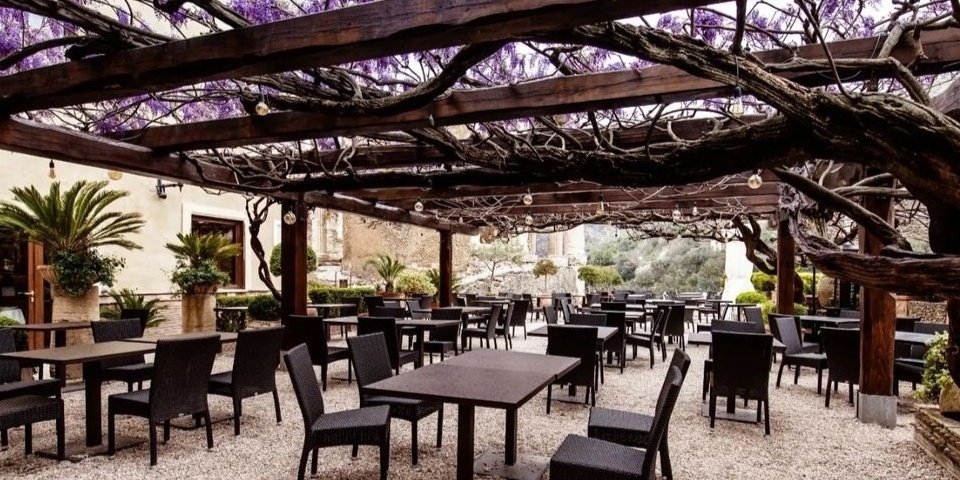
Sibilla restaurant is a unique gastronomical experience along with incredible views of Tivoli. This is a perfect place for a beautiful date, wedding celebration, family lunch or dinner, or just for a meeting with friends. There are vegetarian, vegan, and gluten-free options on the menu. Must visit!
Osteria La Briciola
- Adress: Via Scuole Rurali, 1, 00019 Tivoli

Osteria la Briciola is one of the top seafood restaurants in Tivoli. If you are looking for a combination of excellent service, high-quality food, and beautiful views – this place is for you. There are vegetarian, vegan, and gluten-free options on the menu. Also, don’t forget to try their desserts!
Ristorante Viva l’Oste
- Adress: Via Santa Sinferusa, 6, 00019 Tivoli

Viva l’Oste is a charming restaurant near the entrance to villa d’Este. It is a family-run place with “menu of the day” options, which make its dishes unique and fresh. Among dishes are local delicacies, traditional Roman dishes, homemade pasta and desserts, and sometimes unusual receipts worth a try.
I hope my tips help you plan your trip to Tivoli from Rome. Of course, you can always ask questions in the comments or ask for an individual consultation .
Author: Kate Zusmann
I have lived in the Eternal City for the past 12 years. They say every angle of Rome has its history, and I'm here to tell you about the most intriguing historical facts and city legends. :)
Dive Deeper into Rome's Stories

15607 views
Ostia Antica Ruins: Rome’s Ancient Harbor
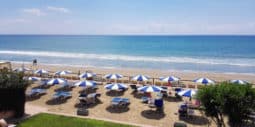
20980 views
Best Beaches near Rome

13367 views
Trip from Rome to Alberobello

Read more about Rome

How to Get From Rome to Venice

How to Visit Sistine Chapel?

Rome.us © 2024. Created with love by Roman experts and guides.
Privacy Policy
- Ferragosto - August 15
- Holidays in Rome
- Where to Stay
- Where to Eat
- Best Time to Visit Rome
- Top 10 Tips for Rome
- Bathrooms in Rome
- What to Pack & What to Wear
Money Matters
Getting Around
Getting to Rome
- Learn Italian
- Rome & Vatican Tours
- Italy Tours
- Transfers & Transport
- Sign up & get a FREE ebook Subscribe Today! Our New Italy Travel Website Is HERE Visit Napleswise Now!
- Romewise Home Page
- What to Do in Rome
- Tivoli Day Trip
Tivoli Day Trip from Rome – Visit Hadrian’s Villa & Villa d’Este

By Warren George
September 5, 2022
The town of Tivoli, just outside of Rome, is a must-do day trip for anyone interested in the history of Rome or looking to escape the crowds!
What is Tivoli?
Why visit tivoli, where is tivoli in relation to rome, how to get from rome to tivoli.
- Visiting Hadrian’s Villa (Villa Adriana) in Tivoli
Visiting Villa d’Este in Tivoli
- Other things to see in Tivoli
Where to eat and drink in Tivoli
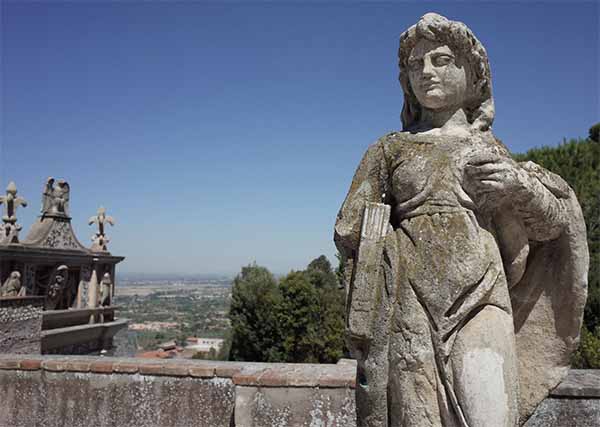
Tivoli is a small town in the Lazio region of Italy, home to around 55,000 people, and the area has been inhabited for over 3000 years.
Today it's a popular destination for tours and a great day trip from Rome for anyone interested in history. To find out everything you need to know about Tivoli day trips, keep reading!
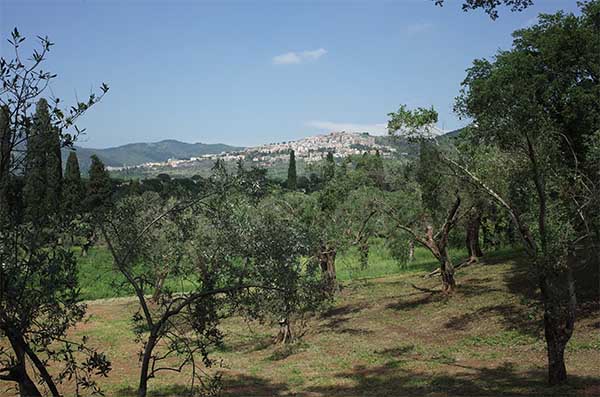
Is Tivoli worth visiting? Absolutely!
Tivoli is home to not one, but two Unesco World Heritage sites – Hadrian’s Villa ( Villa Adriana in Italian) and Villa d’Este .
It is possible to visit both villas in the same day – either by yourself or as part of a guided tour – keep reading to find out more!
Find out more about visiting these incredible sites:
- Visiting Villa d’Este
- Visiting Hadrian's Villa
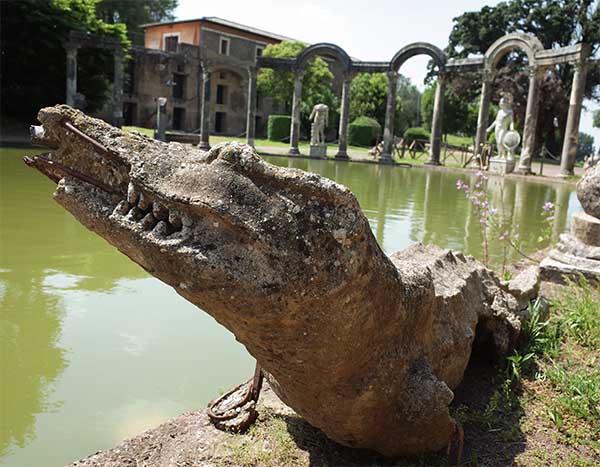
Tivoli sits on the side of a large hill, from which natural freshwater springs flow, creating a series of waterfalls which are visible from the historic center and the surrounding local area.
Throughout the historic center you’ll find numerous Roman ruins, and on the outskirts there are remains of ancient aqueducts, along with several hiking and cycling routes.
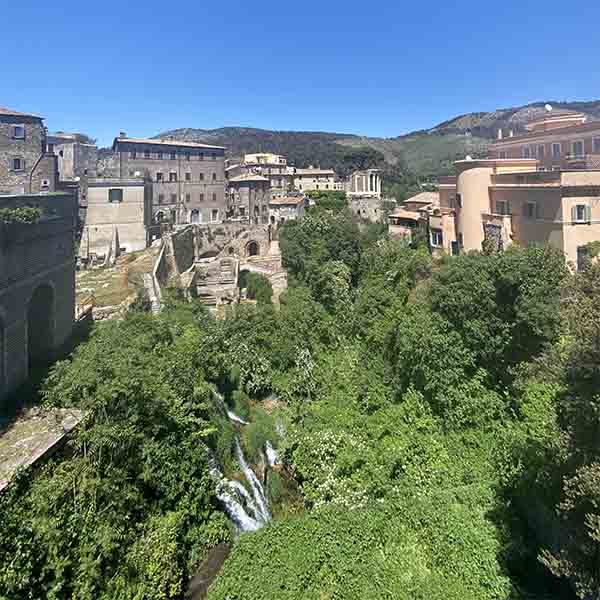
Tivoli is located 27km (as the crow flies) from the center of Rome.
Villa d'Este is in the center of the modern town, whereas Villa Adriana is located on the outskirts. For complete information about visiting these incredible sites, keep reading!
Getting to Tivoli from Rome couldn’t be easier – you have a couple of options for a self-guided day trip:
Public transportation
The most direct route to the main sights of Tivoli from the center of Rome is to take the Metro Line B (blue line) to the Ponte Mammolo station, and then a bus . When you step out of the Ponte Mammolo station, you will see a number of buses from a company called Cotral.
From here, you can take any of the buses marked as heading to Tivoli.
- One of the buses takes a more winding route, stopping around 300m from the entrance to Villa Adriana before heading into Tivoli. This bus runs much less frequently.
- The other bus routes are more direct - if you are visiting Hadrian's Villa you will need to get off at the stop on via Tiburtina and walk around 2km to reach the entrance.
There are also various trains that stop in Tivoli from the central Rome station of Termini , but the Tivoli train station is located at the bottom of the hill.
To reach the various sights, you will need to then take a local bus, or you can walk - it's around a 25 minute uphill walk. The local bus also goes to Hadrian's Villa.
🔐 Store your bags and luggage securely! 🧳
We're parterned with Radical Storage who have locations across Italy for you to keep your luggage safe before and after check-in, while on day trips and for everything else between 👌
Click here to book now and use code ROMEWISE to save 5%!
To drive to Tivoli from the center of Rome takes between 45 minutes and an hour, depending on where you set off from.
Hadrian’s Villa – there is plentiful and cheap parking on site – you need to pay for parking at the ticket office when you buy your tickets to the archaeological park, or redeem your pre-booked tickets if you booked on line tickets.
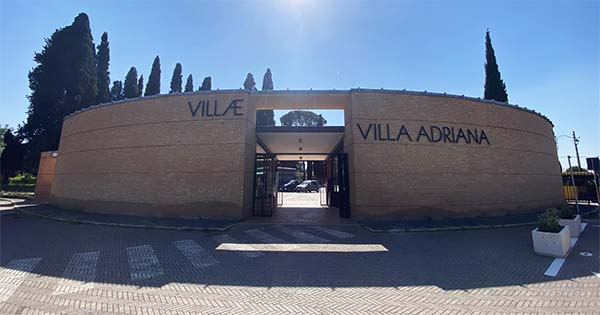
Villa d’Este – there is no official car park but there are several options nearby. You can park on one of the side streets nearby – you’ll need to pay at one of the machines along the sidewalks (pay close attention to the time frames and conditions) or in one of the official car parks – more on these below!
Historic center – if you’re wanting to see the waterfalls or other historical landmarks, I’d recommend parking in this carpark . If you find that’s full (possible during the busier summer months), try one of these:
- Parcheggio della Panomarica
- Parcheggio piazza Matteotti
- Parcheggio Lungo Aniene
The other option for your Tivoli day trip is to book a private tour – you can opt for half day guided tours which typically cover one of the area's main sites, or a joint experience that covers both Villa d’Este and Hadrian’s Villa , plus often other sites, with transfers included for a stress-free day trip from Rome .
When to visit Tivoli's Unesco World Heritage Sites, Hadrian’s Villa & Villa d’Este
Tivoli is a regular Italian town so can be visited at any point in the year.
If you are looking to visit Hadrian’s Villa, consider visiting in the spring or fall – during the summer the exposed nature of the site means the sun can be very hot, and during the winter the temperatures drop considerably and the chance of rain increases.
For Villa d’Este, you can visit from spring through autumn – the gardens and fountains ensure the environment always feels cool. I would not recommend visiting in the winter however as often the fountains are switched off for maintenance.
During the summer, Villa d'Este is also open later on certain days where you can experience this magic place with the sun setting over the Roman countryside.
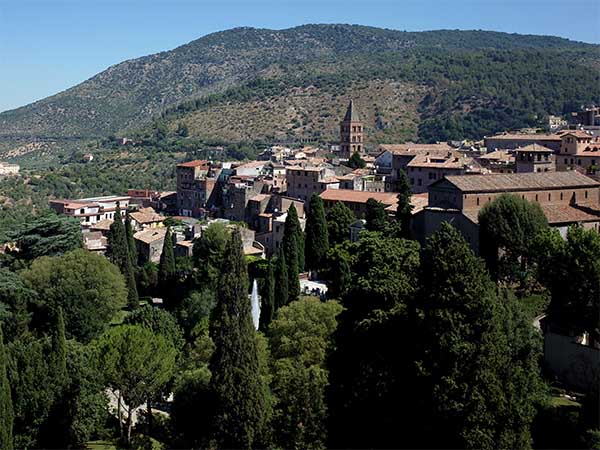
Visiting Hadrian’s Villa (Villa Adriana)
History & background.
Welcome to the private home of ancient Roman emperor Hadrian! This sprawling palace was one of the biggest constructed in the history of ancient Rome, and is considered now to be one of the most outstanding villas from the classical age.
Located in the Sabine Hills in the Roman countryside, Villa Adriana is approximately 25km from central Rome.
For Emperor Hadrian it was much more than just a home - it was a meeting point where he could run the Roman empire away from the hustle and bustle of the Eternal City.
After the fall of the western Roman empire in the fifth century AD the villa fell into disuse and was plundered for its valuable building materials and precious artworks.
While a lot of what was once here is lost forever, much also survives - both on site and in the collections of famous museums around the world including the Vatican Museums .
Some decorative elements were reused by Cardinal Ippolito d'Este to decorate Villa d'Este - keeping reading to find out more about this!
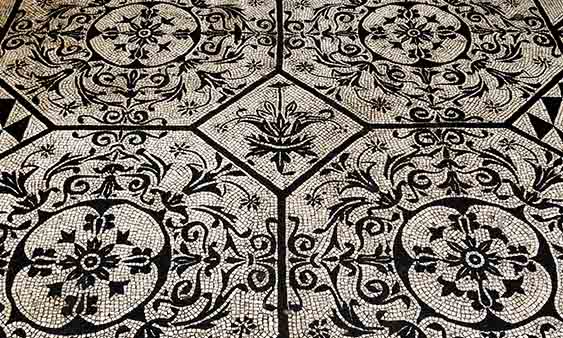
Getting there
Driving: Set Google Maps to the carpark at the site entrance
Public transport: Click here for full details
Private guide/tour: The easiest way to reach Hadrian's Villa is to take a tour including transport from Rome, like this one which also includes a visit to Villa d'Este and lunch !

Disclosure: If you make a purchase through a link on this page, I may receive a small commission - at no extra cost to you. Thank you for supporting my site!
Accessibility
Hadrian's Villa is a giant open-air archaeological site with modern paths and roads throughout.
These paths and roads are easily traversable for anyone, including those with accessibility challenges, and it is possible to see a large amount of the park this way.
Unfortunately, due to the nature of the ancient ruins, not all the areas within the site are accessible to visitors with mobility restrictions.
Before visiting, I'd recommend contacting Villa Adriana (yourself, or via your tour guide) to discuss any accessibility requirements in advance.
How long you need to visit:
Hadrian’s Villa covers a HUGE area – 200 acres to be exact – making the whole site 130 times the size of the White House!
Many of the key areas to visit are spaced out, so be prepared to walk! To see the main sites you should allow 3 hours minimum during your day trip from Rome .
To see absolutely everything, you should anticipate spending at least 6 hours here.
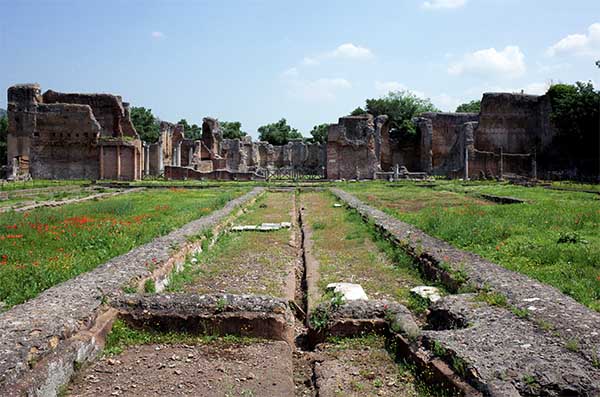
Tickets & Hours
Tickets can be purchased online or at the ticket office on site. Coop Culture is the organization that manages Villa Adriana so you can check opening hours and other information in advance.
Visitor welcome center - before you start exploring, I recommended stepping into this little museum to view the to-scale model of the whole villa site - not only does it help orientate you, but it also helps to show the original grandeur and scale of Hadrian's Villa.
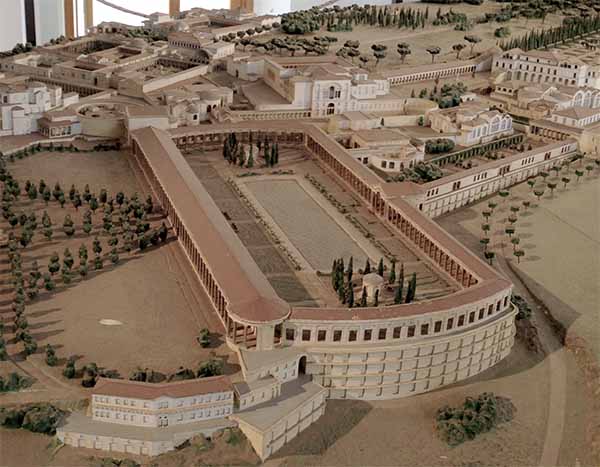
Canopus - This is maybe the most iconic feature of Hadrian's Villa. It was designed to replicate the river Nile in Egypt (hence the crocodile statues) which is where Hadrian's lover Antoninus died in a tragic accident. This was Hadrian's personal and private space where he would come to remember his beloved.
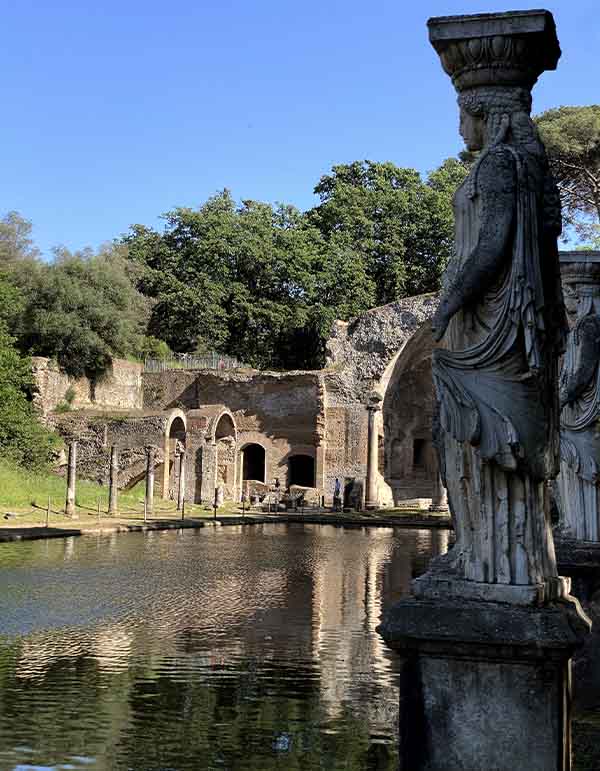
Maritime Theater - So called because of its circular shape and the presence of flowing water, this complex structure was another space thought to be used personally by Hadrian - it comprised over thirty rooms, all of which would have been intricately decorated.
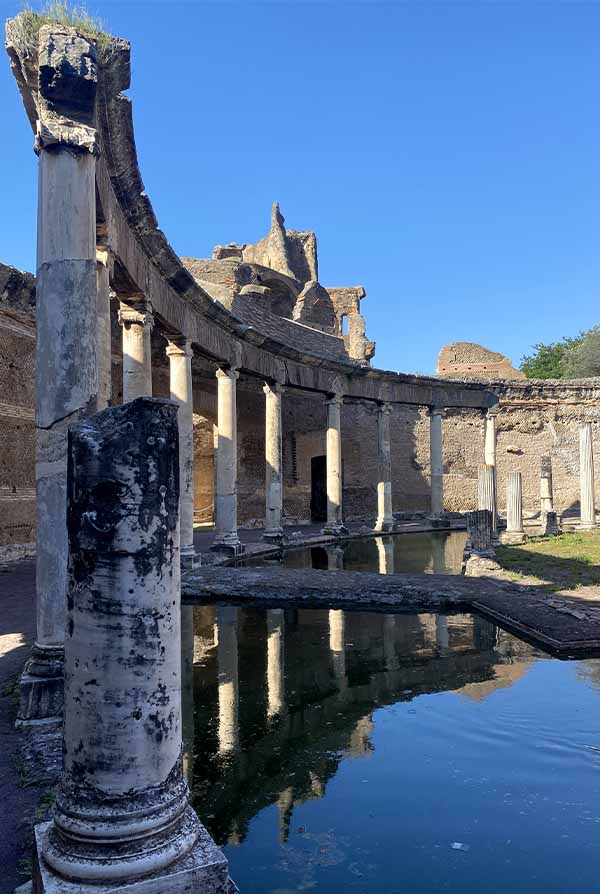
Museum - located next to the Canopus, this museum houses a lot of the original statuary that was found at the site which hasn't been relocated to other museums around the world - when visiting on a hot day it provides a welcome break from the sun, and you'll also find bathrooms here.
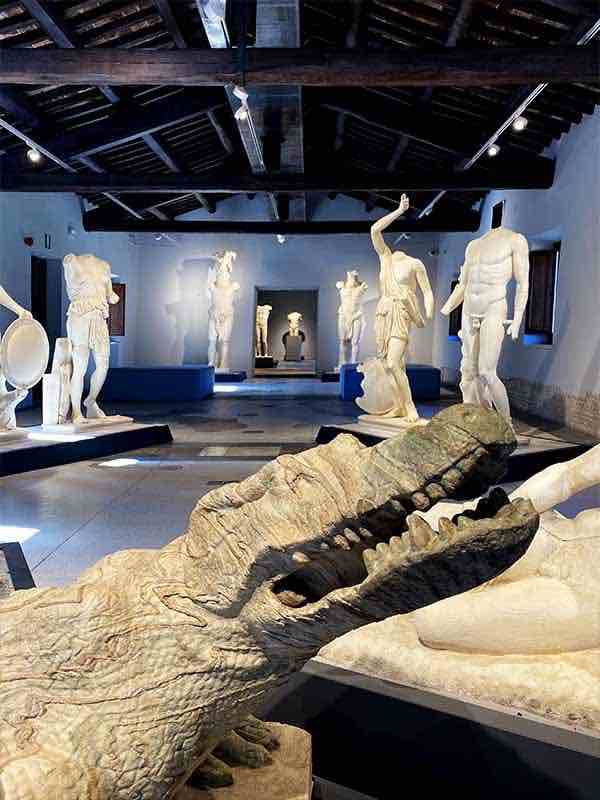
Temple of Venus - While not much remains of this temple, its outlying location makes it worth visiting as it helps to put the size of the site into context. I also find the location on the edges of the park and the surrounding views evocative and peaceful.
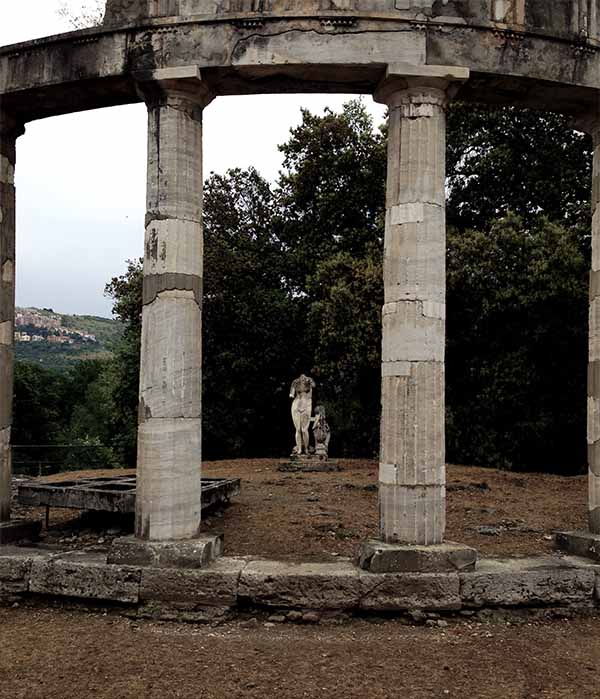
Recommendations
- If visiting in the summer, be sure to bring protection from the sun – a hat and sun block are a must! Consider also visiting in early morning before the sun gets too hot.
- If visiting at any other time of the year, bring a waterproof jacket and umbrella - the weather in this area of Lazio is very changeable and the site very exposed to the elements.
- Always bring plenty of water and something to eat for lunch as on-site refreshment options are limited (there is a small café/kiosk but the opening hours are inconsistent). You'll find endless green spaces with benches where you can rest and recharge. Water fountains are dotted around the park.
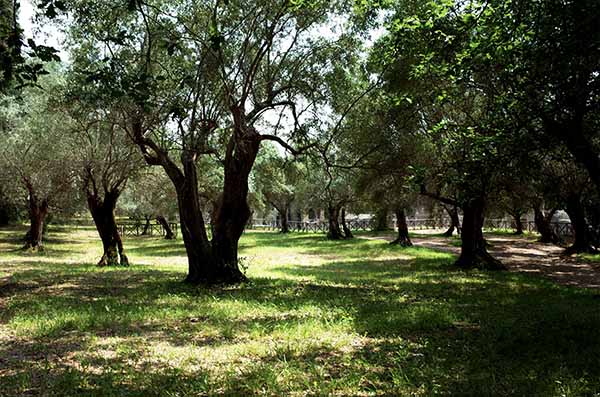
Want to hone your photography skills? Why not take this special full day trip to Villa d'Este and Villa Adriana including a photo tour and workshop?
Welcome to the private villa and its beautiful gardens (and now resting place) of Cardinal Ippolito d'Este.
Cardinal d'Este began work in 1560, 11 years after he was appointed as governor of Tivoli in 1549, following an unsuccessful attempt to become Pope . He would go on to make five bids for the papacy, none of which were successful!
Following his passion for antiquity, the cardinal removed a lot of the remaining statuary, ancient artworks and marble from Villa Adriana in order to construct and decorate his new home.
The primary construction took place over 9 years, during which time a lot of the terraced gardens, grottoes and fountains you see today were created.
In the subsequent centuries further elements were added by his descendants, and older parts renovated but for long periods the villa and gardens were abandoned.
After WW1 the Italian state took control of the site and initiated a program of restoration, meaning this incredible place can be enjoyed today.
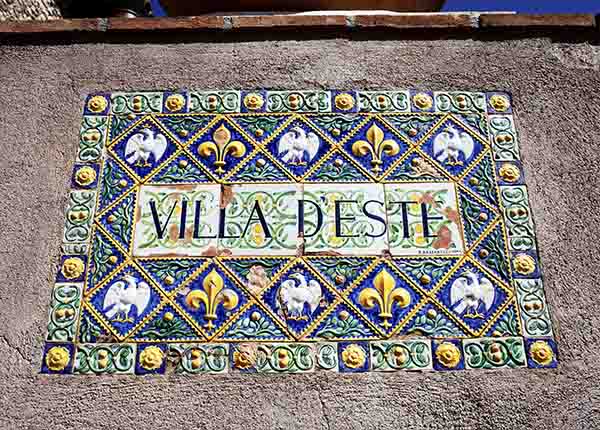
Driving: Set Google Maps to Parcheggio della Panomarica
Private guide/tour: The easiest way to reach Villa d'Este is to take a tour including transport from Rome, like this one which also includes a visit to Hadrian's Villa !
Ready to plan your trip?
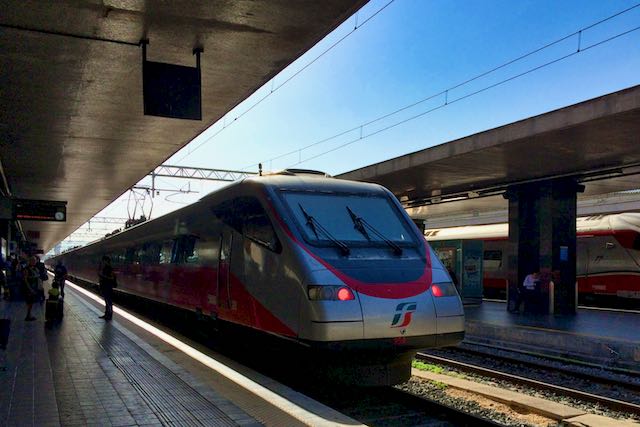
Villa d'Este features a vast open-air garden constructed on the side of a large hill.
Navigating the gardens is done via ramps and slopes, or stone staircases. At the time of writing, there are no mechanized methods for visitors to descend or ascend the gardens.
Before visiting, I'd recommend contacting Villa d'Este directly (yourself, or via your tour guide) to discuss any accessibility requirements in advance.
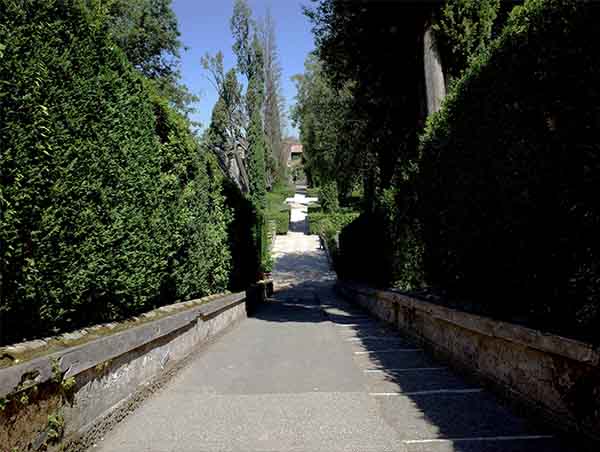
Visitors should allow at a minimum two to three hours to fully explore the gardens and fountains.
Tickets can be purchased online or at the entrance along with audio guides.
What to see
Villa d'Este is an enclosed site, meaning it's easy to navigate and see everything here if you follow the signs and recommended itinerary. My personal highlights of any visit include:
Villa - You'll enter contrary to how Cardinal d'Este designed - originally visitors would come to the base of the gardens and slowly make their way up the hill to his home, demonstrating to them his power and wealth. When you enter now you have the opportunity to explore the Cardinal's private residence where you'll find ornately decorated rooms.
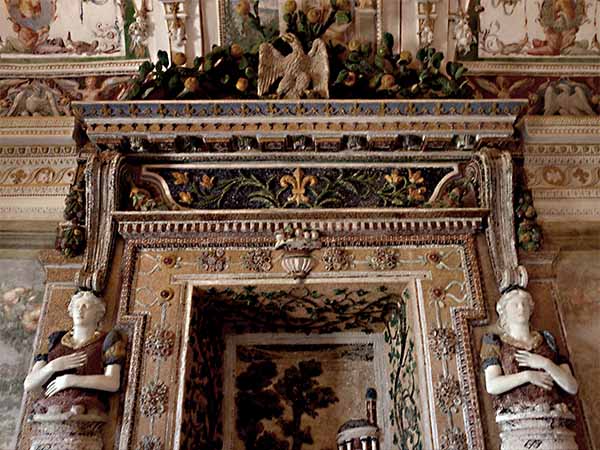
🤙 Roaming in Rome? 📱
Get yourself an Italian eSIM for calls, messages and data when traveling here.
Save on data charges with plans from just 19€ from Holafly - our recommended eSIM provider!
Click here to get yours now and use code ROMEWISE to save 5%!
The Fountain of the Organ - This fountain is probably the most famous in the garden, as it is the oldest example of a hydraulic organ. Via a complex and delicate system, water and air is piped through a hidden network and used to create musical notes and sounds. Over the course of its life it has been repaired and upgraded several times, with the most recent renovation being in 2003, meaning its magical sounds could be heard once again after a long period of silence.
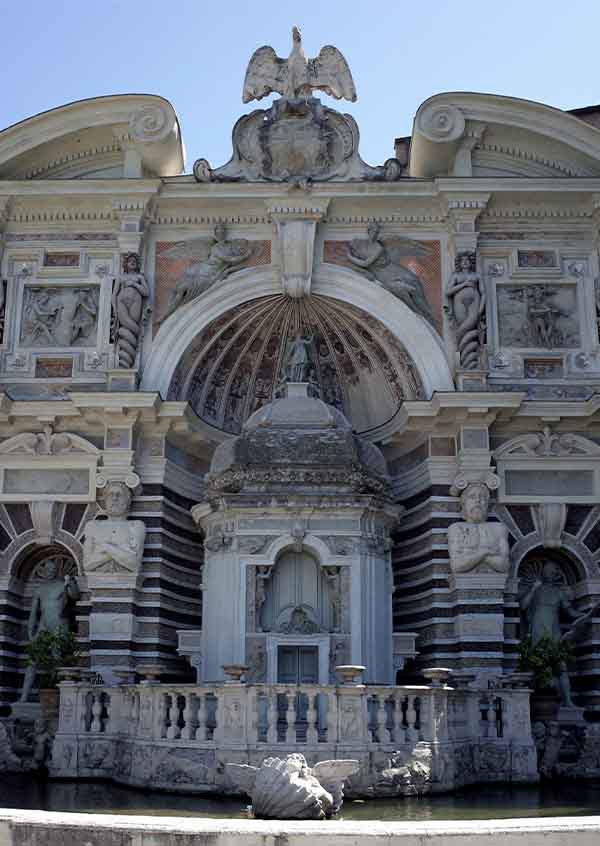
The Fountain of Neptune & Fish Ponds - This fountain is one of the more modern features of the garden, created in the 20th century to replace elements that had fallen in to disrepair. The fish ponds you can see here once served a practical purpose, providing the villas residents and staff with fish and other animals for food.
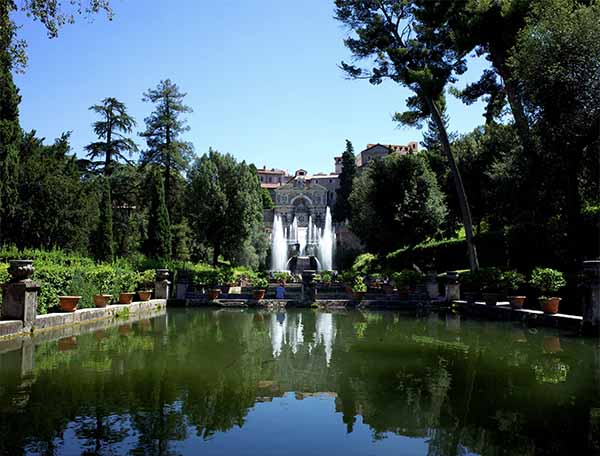
- The best time of day to visit Villa d'Este is in the afternoon - particularly in the summer as the shade from the gardens and moisture from the fountains ensure a cool environment.
- Bring water and snacks as there are very limited food options on site. The site is very central however so there are plenty of places nearby to have a coffee , gelato or lunch before or after your visit.
What else to see in Tivoli
If you find yourself with free time when in Tivoli, or are looking to explore to further, considering visiting these sites and monuments - these are just a selection of my favorites, as there is much more to be found:
- Villa Gregoriana , a large park where you can get close to Tivoli's famous waterfalls and explore ancient grottoes. It was commissioned by pope Gregory XVI in and today the Villa Gregoriana is looked after by the Fondo Ambiente Italiano, the National Trust of Italy.
- Sanctuary of Hercules Victor , a vast ancient Roman temple complex dedicated to Hercules with a theatre built in to the slope of the hills.
- Temple of Vesta and Temple of the Sybil (find out how to see these for free - continue reading!) on Tivoli's ancient acropolis - you can get a great view of these from Villa Gregoriana.
- Rocca Pia - this imposing castle in the centre of Tivoli was built by pope Pius II in 1461 to control the local area.
If you are visiting with a tour guide or private guide that provides transport from Rome, be sure to ask them to ask them to take you past the ruined ancient aqueducts on the outskirts of Tivoli.
For me, there is one place which is a must-visit for food and drinks in Tivoli; Ristorante Sibilla.
Perfect for a traditional Italian lunch and/or dinner and located only 10 minutes walk from Tivoli's main square (Piazza Garibaldi), this restaurant is renowned for its high quality, seasonal menu and having been the choice dining location for many of history's most famous figures, including Neil Armstrong, Yoko Ono and Princess Margaret of Great Britain.
When you arrive you'll see what else also makes this restaurant special; from its outdoor terrace you can marvel up-close at the ancient ruins of the Temple of Vesta and Temple of the Sybil. If that wasn't enough, looking the other way you'll be treated to incredible views of Tivoli's famous waterfalls and a special view of this beautiful town.
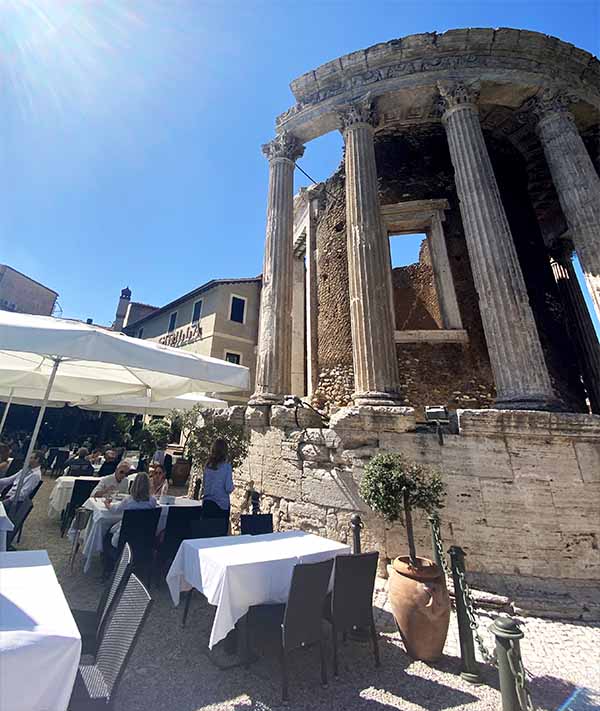
If you are on a guided tour of Tivoli and don't have time to visit Ristorante Sibilla, I'd recommend making a separate day trip from Rome to Tivoli just to eat here and take in the views!
Want to save this to Pinterest? Pin it here!
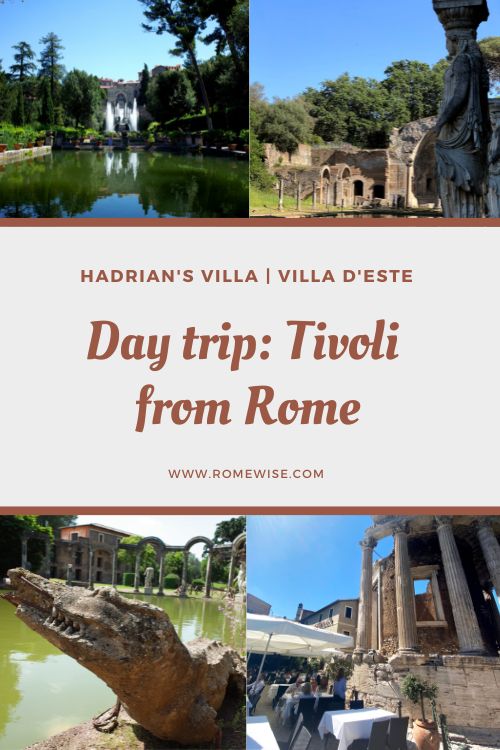
Get your 100% free Rome trip planner now!
Simply sign-up today for our free newsletter and get the Romewise Quick Start guide to Rome:
We are committed to respecting your data. Click for our Privacy Policy .
Comments? Questions? Suggestions?
Please come over to the private Romewise Facebook group and join in the conversation.
You will often find me there, happy to answer your questions / comments!
You will also meet other Rome lovers and experts, too.
What are you waiting for?
Come join in the fun !

Read here about our sponsorship policy
Top attractions and tours

- Colosseum - Don't miss visiting Rome's most iconic monument
- Vatican Museums - This is where the Sistine Chapel is
- Pantheon - Book ahead and skip the line
- Galleria Borghese - You'll need to book ahead for one of Rome's best museums
- Castel Sant'Angelo - See Rome's history through its architecture
- Rome City Pass - A great way to make your Rome visits easier
Disclosure : If you make a purchase through a link on this page, I may receive a small commission - at no extra cost to you. Thank you for supporting my site!
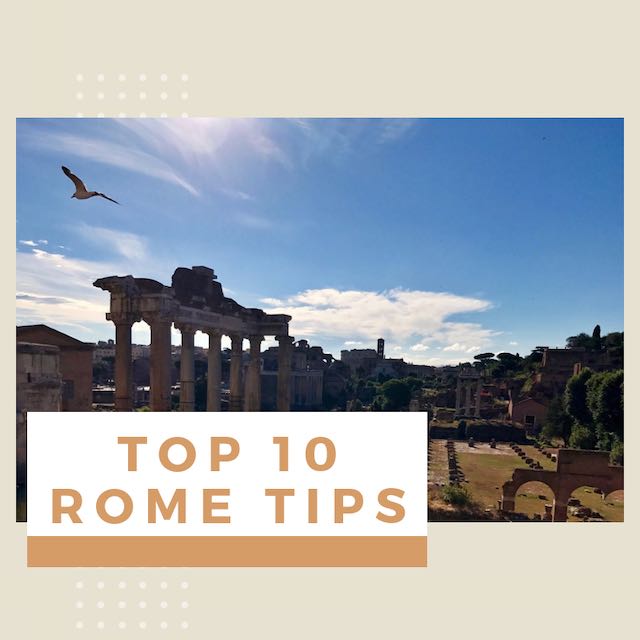
New to Romewise? Start Here
Get the most out of Romewise
Coming To Rome?
Weather in Rome
Accommodation
Already in Rome?
Things to Do
MORE CITYWISE WEBSITES:
Florencewise
Atlantawise
Citywise LLC
Home | About Me | STORE | Privacy Policy | Legal Disclaimer | Affiliate Disclosure | Contact Me
Copyright © 2009-2024 by Elyssa Bernard, Romewise.com | All Rights Reserved.
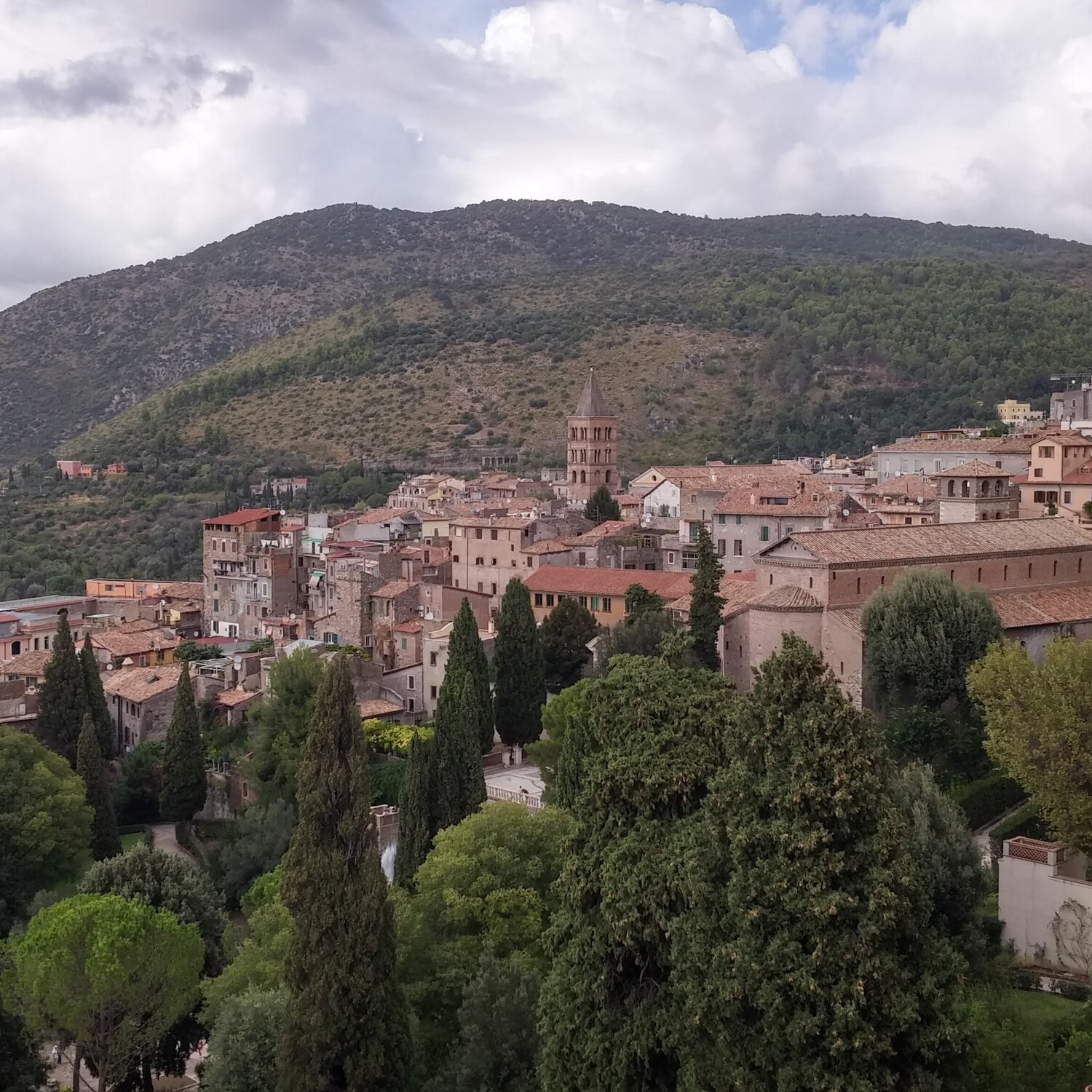
- Travel Guides
- May 13, 2024
- City in a Day
One day trip to Tivoli from Rome. How to get there and what to see.
- What to see in Tivoli
- How to get from Rome to Tivoli on your own
Surprisingly, even though Tivoli is at the top of the «where to go from Rome for a day» lists in almost all guidebooks, there is very little information about the city itself. The scant information is limited to the fact that:
- Tivoli used to be called Tibur and is older than Rome — it was founded in the 13th century BC.
- In Latin times, Tibur competed with Rome for influence in the region, but was nevertheless conquered by the Romans in the 1st century BC, and subsequently came under Papal rule.
- The breathtaking scenery and mild climate have always attracted the nobility and bohemians: Horace, Maecenas, Catullus lived here, the Roman Emperor Augustus turned the town into a fashionable vacation spot for the Roman aristocracy, and the Emperor Hadrian built a huge villa, the largest of the surviving ones, which Unesco calls the best example of an imperial country villa of the Roman era.
- Over time, the name Tibur was transformed into Tibori, Tiboli and finally Tivoli, but the inhabitants of the town are more often referred to today as Tiburtians.
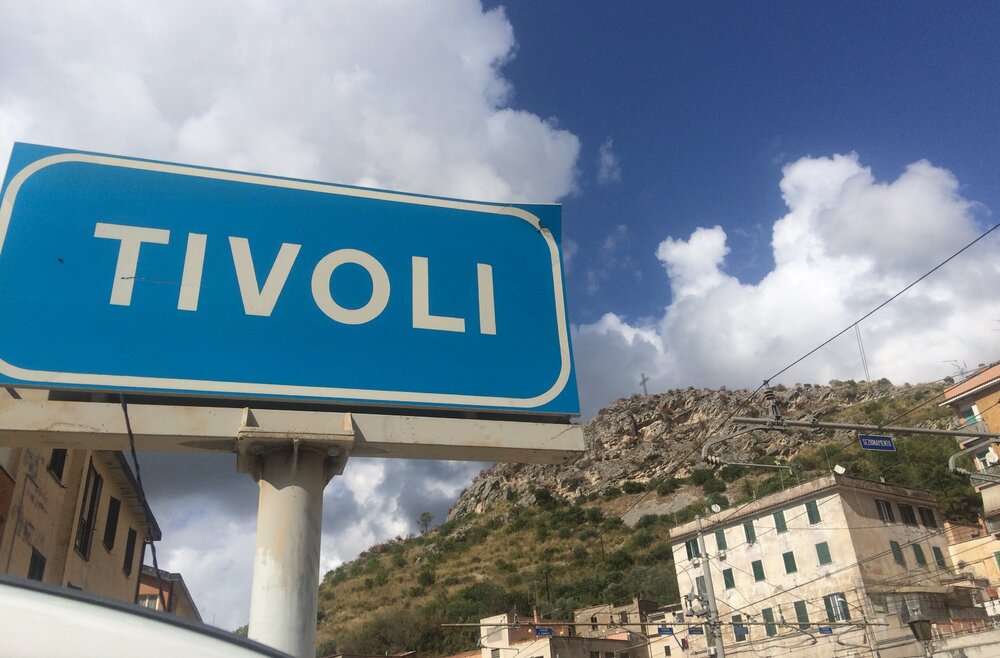
The list of attractions in Tivoli also goes from one guidebook to another: Hadrian’s Villa, the castle of Pope Pius II (1458—1461), Villa d’Este (XVI century) and Gregorian Villa (XIX century). To see the 3 villas and the historical center of Tivoli, it is recommended to book 2 full days or a comprehensive tour : all villas are quite large, and they are scattered far from each other. We didn’t have so much time, and we came to Tivoli only for the sake of Villa d’Este, as the most spectacular urban object, a masterpiece of Renaissance garden architecture, a forerunner and prototype of Versailles, Peterhof and many other European gardens.
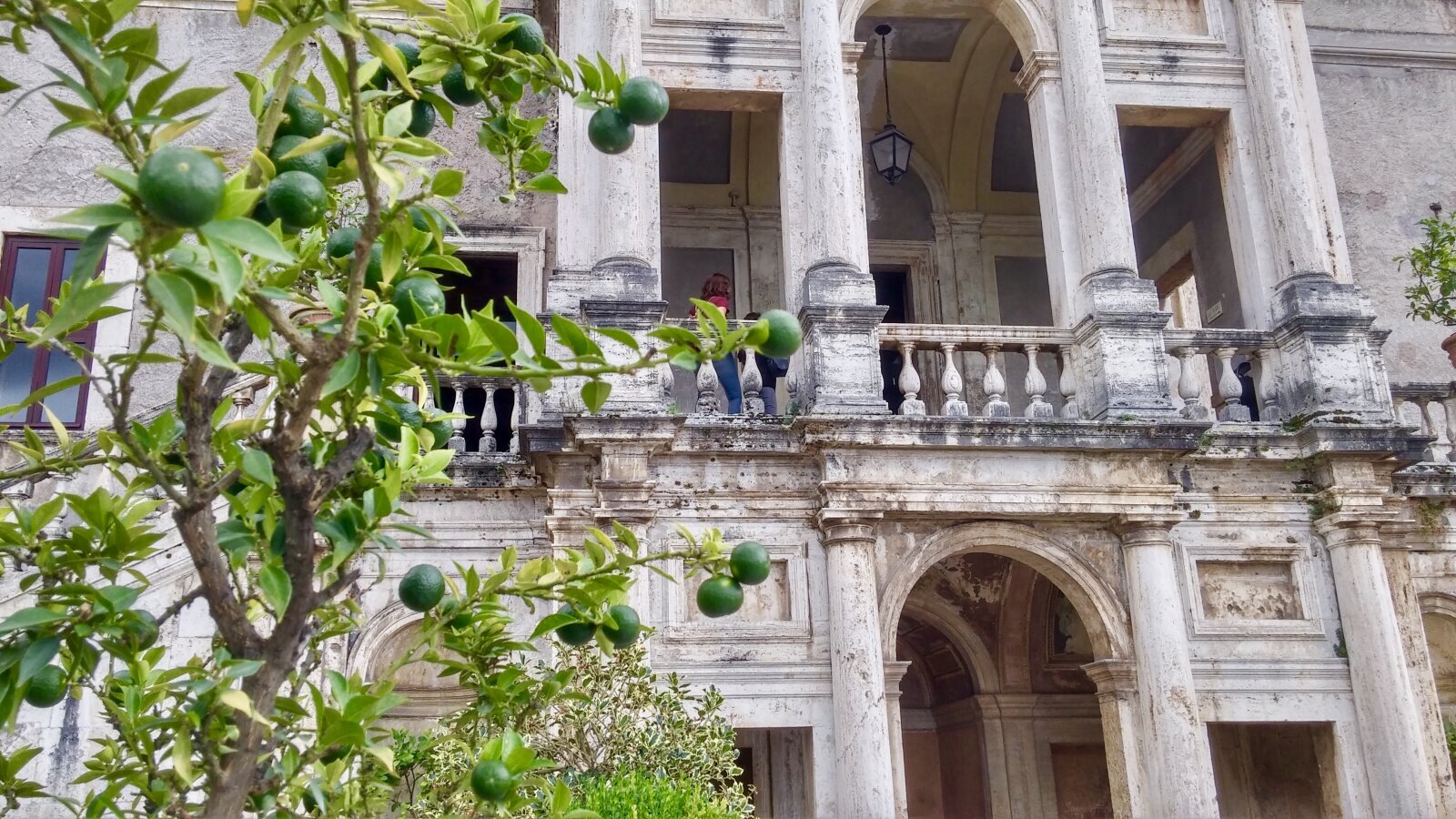
Tivoli stands on the river Aniene (Aniene or Anio, in Italian Aniene). This mountainous river with its verdant banks forms waterfalls that can be seen 5 minutes from the train station. And there are many waterfalls here. Today, the river is curbed, its course has been changed, the river is quite calm within the city limits, and the waterfalls, which once destroyed the banks and grottoes, are now taken outside the city. But back in the XIX century, the temper of the turbulent mountain river killed many Tiburtians in a devastating flood.
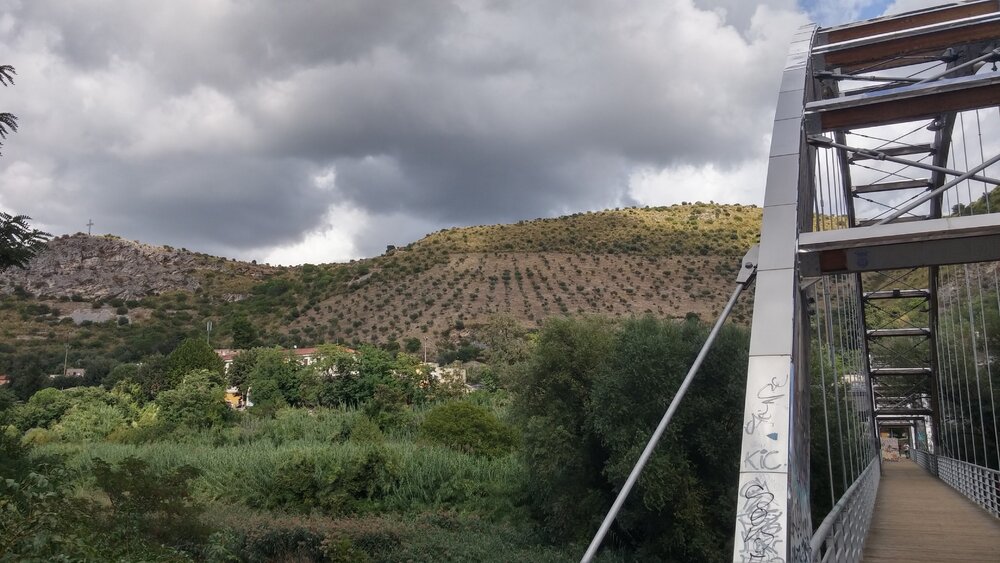
What has made Tivoli so attractive to prominent people throughout the ages is clear as soon as you approach the town: such picturesque scenery, clean air and so close to the center of Italian political life of all times, there is probably no other place like it. This magnificent scenery opens up almost everywhere from the city. Probably the best view of the campagna di Roma is from the terrace at piazza Garibaldi.
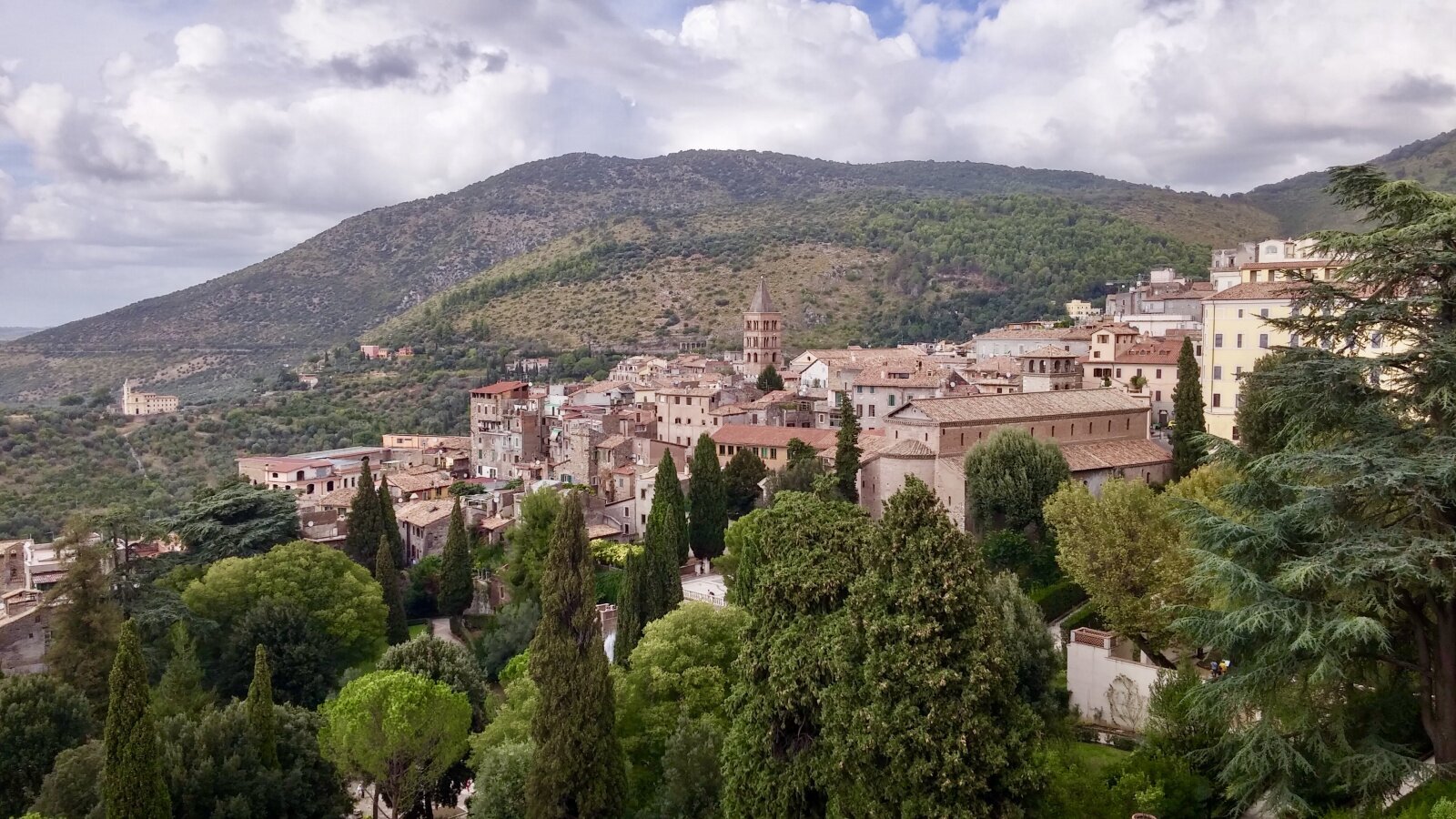
What to see in Tivoli
September Tivoli greeted us with a heavy, cloudy sky. However, already on the approaches to the town, when the train took us past a waterfall that was completely unexpected and perhaps that is why it was so amazing for us, it became clear that it is not only Villa d’Este that is worthy of attention here. This waterfall it is at the Villa Grigoriana, which we had not planned to visit.
Judging from the map, to pass close to the Villa Gregoriana and the Temple of Vesta, we had to turn right from the railroad station and walk to a bridge with inspiring views of the waterfall, but we didn’t get to town until around 3pm and didn’t have time to experiment.
When we arrived at the train station, we turned left and went straight into the city. The historical center of the town is typical Italian: old houses, flowers at the doors and on the walls, cobbled narrow streets. Even the unkept walls do not spoil the impression of the «playfulness» of the town. Incredibly cozy, quiet, peaceful. Even if you have only a half-hour walk at your disposal.
Tivoli was heavily damaged during World War II, and now the town bears the marks of many different times. There are antique columns built into the houses of the Middle Ages and Renaissance, with 18th- and 19th-century superstructures rising above them; there’s a perfectly preserved Gothic house, a dozen Catholic churches from different periods, and a cute, playful historic center.
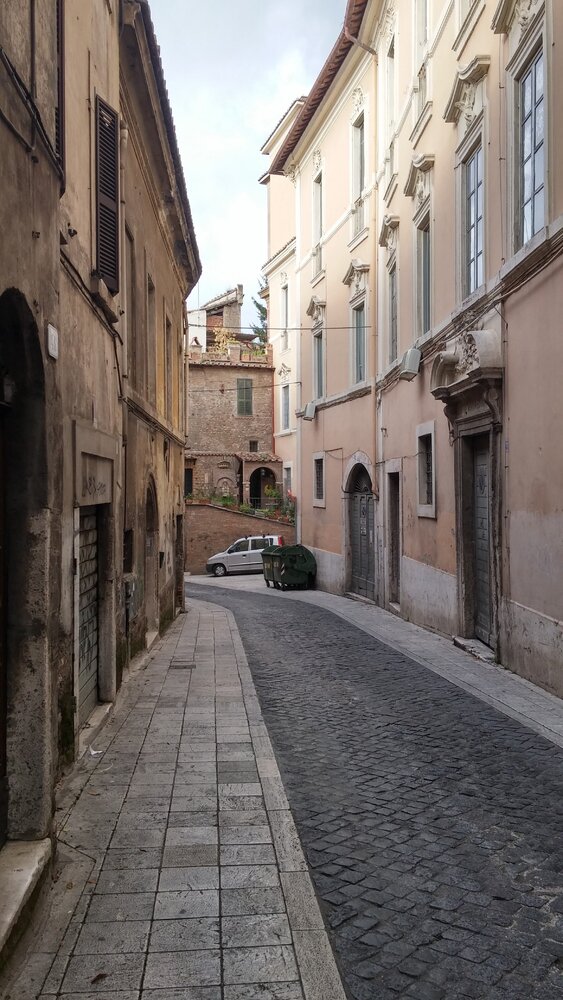
All of this is mixed with modern art. Right opposite the exit from the Villa d’Este there is an ugly bust in a puddle, which was supposed to be a fountain, and on Piazza Garibaldi in 2007 they erected the Arco dei Padri Costituenti (Arch of the Founding Fathers). Its author is the famous Italian sculptor Arnaldo Pomodoro, the author of the balloon in the Vatican Gardens. Behind the arch the massive towers of the castle of Pope Pius II, more often called Rocca Pia, are visible. You can walk there too, if time permits.
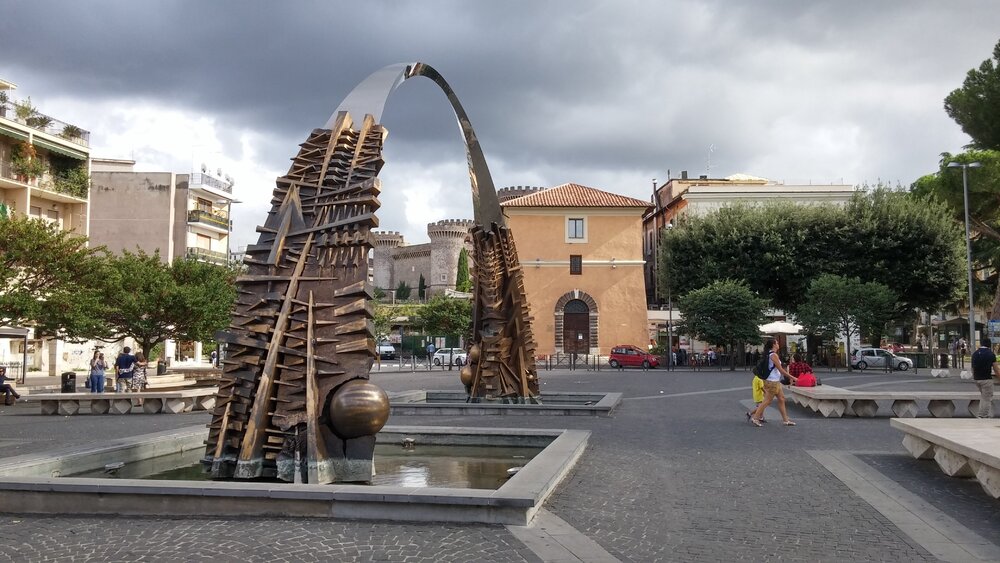
Villa d’Este
The villa was built by Cardinal Ippolito II d’Este, son of Lucrezia Borgia and grandson of Pope Alexander VI. The wealthy cardinal patronized artists and collected antiquities, and he retired to Tivoli after his defeat at the papal conclave, when the papal tiara went to his rival.
The entrance to the villa is from the side of the church of Santa Maria Maggiore. During the Cardinal’s time, this entrance was the emergency entrance, and guests entered the park at the bottom and climbed up, looking at the villa from below.
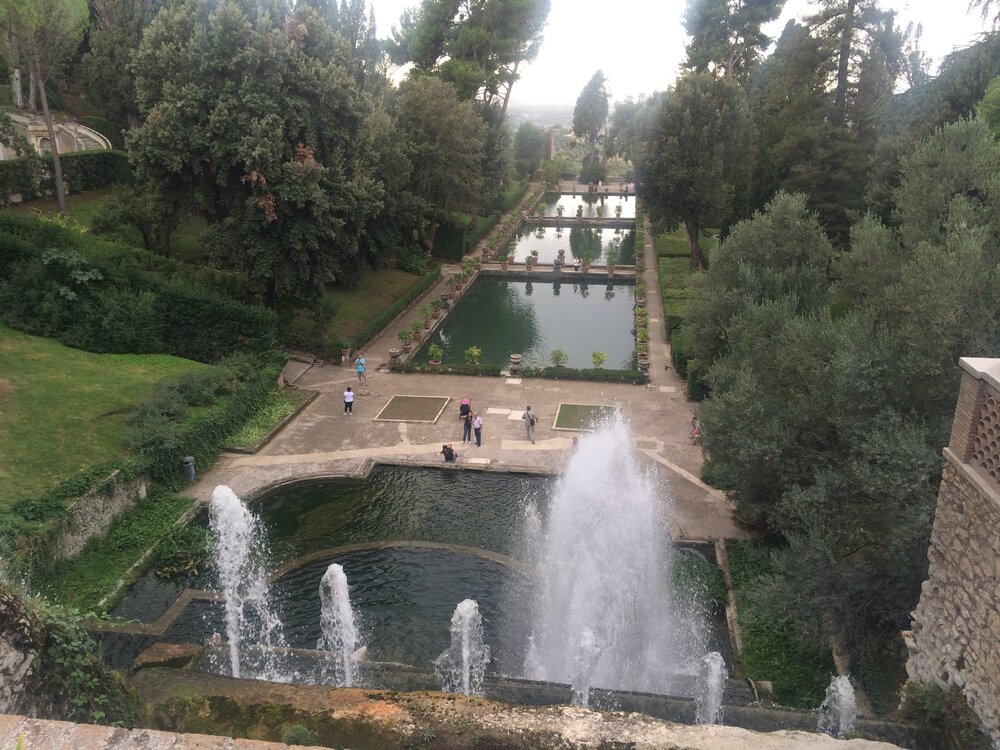
The villa is a former monastery building, which the Cardinal enlarged with loggias and decorated with frescoes. The villa is now almost empty, but the original frescoes have been preserved in good condition.
The most interesting, the main treasure of the villa is its park. As art historians say, the peculiarity of this park for that time is the involvement and participation of the viewer: all the beauty and harmony of 51 fountains with hundreds of cascades and pools could not be covered in one glance, the garden opened to the visitor gradually, from the lower terraces to the upper ones, where they crowned the villa itself. The villa and its park were built on the model of the Villa Hadrian’s Villa, which had been discovered shortly before — the excavations were carried out by the same architect Pirro Ligorio, who built the Villa d’Este, and he also transferred from the imperial villa statues and decorations to the Cardinal’s Villa. The scale and plan of the complex can be seen in an engraving from the late 16th century.
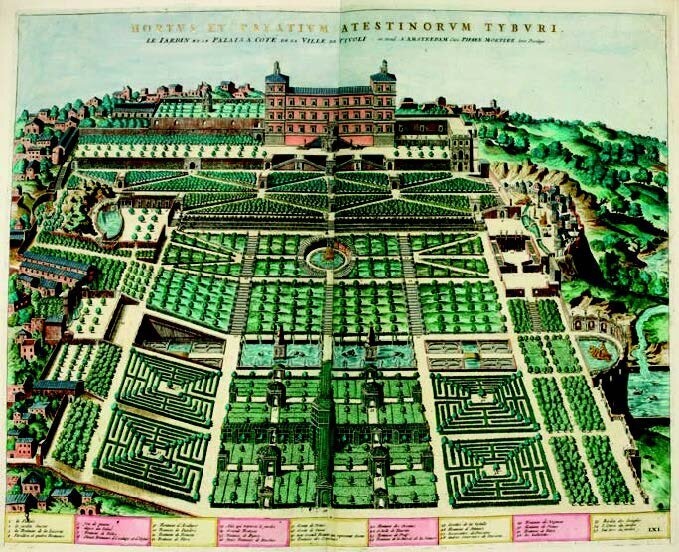
Everything in the gardens obeys the idea of metamorphosis: plants are stones and stones are plants, and at the center of everything is water transformed into sound. A musical fountain that works without pumps, solely by gravity, is a masterpiece of hydraulic engineering. Such constructions are rare even now, and in Renaissance times no one had ever seen such a thing.
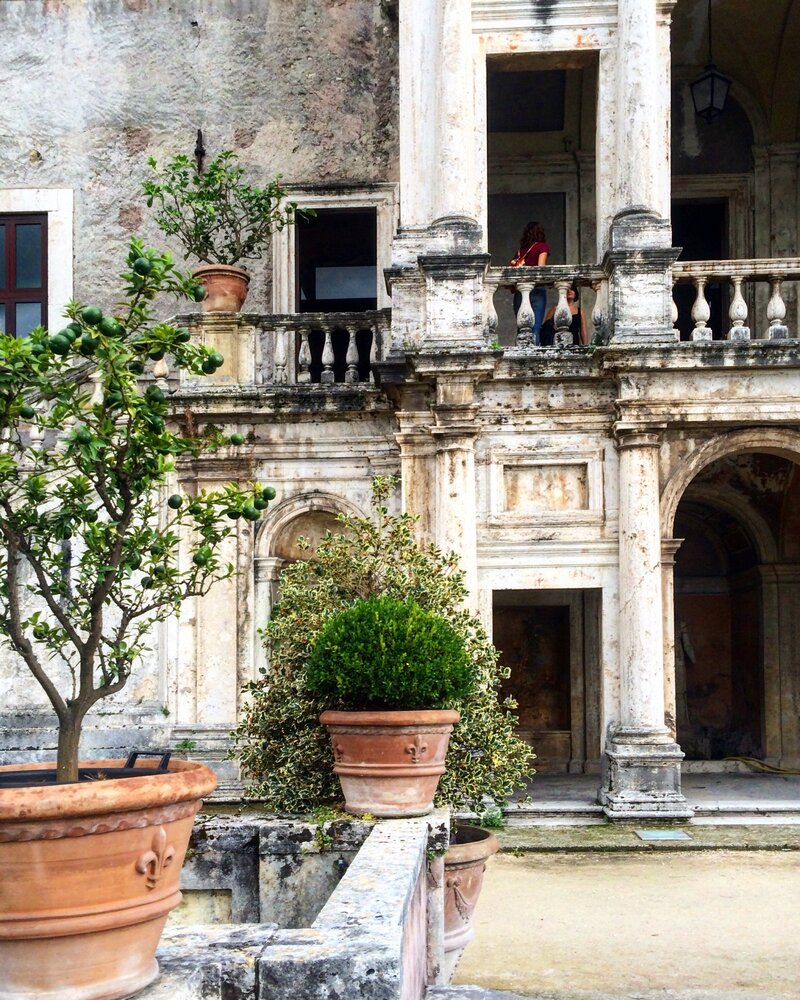
How to get from Rome to Tivoli on your own
Tivoli is a small town 24 km northeast of Rome, with a population of about 60,000. The road connecting it to Rome is still called Via Tiburtina. It is also the name of the second most important train station in Rome: it is from Roma Tiburtina that most trains to Tivoli depart.
From Rome to Tivoli by train
The electric train, or treno regionale, is the most comfortable way to get to and from Tivoli. It runs about once an hour, most departing from Roma Tiburtina, but the cars are comfortable, spacious and there is no risk of traffic jams. There are a few flights a day from Roma Termini station as well, but the number is constantly changing, and on the day of our trip the morning train left too early for us.
Be careful: the trains to Tivoli leave from the outermost platforms Est 1 — Est 3, the signs to them are not clear enough.
You can buy tickets for the train at the Trenitalia ticket machines at the station. Pay attention to the train number on the timetable: Tivoli is not the final station for all trains, some trains go to Pescara and they leave from a neighboring platform.
- Schedule and ticket price of Trenitalia regional trains
- Ticket for the train: from 2.6 €. Don’t forget to stamp your ticket at the station before boarding the train, otherwise you will be fined .
- Travel time: 36—70 minutes
The electric train comes to the station, which is on the outskirts of the city. It takes about 20 minutes to walk to the historical center. Don’t get the stations mixed up: the Bagni Di Tivoli station is a bit earlier on the way. You should go there only if your goal is Tivoli thermal springs and SPA-hotels standing on them. There are no attractions here.
From Rome to Tivoli by bus
Another option to get to Tivoli is the bus. It leaves every 20 minutes from Ponte Mammolo station, which can be reached by metro: blue line towards Rebibbia, get off at Ponte Mammolo station. Ask for bus tickets at the nearest pizzeria and at the newspaper and tobacco kiosk. The journey takes between 30 minutes and 1.5 hours depending on the day of the week and time of day. According to reviews, the bus can cause traffic jams on the busy Via Tiburtina highway, and buses are used by locals, so there is a chance of standing and elbowing.
- Check the schedule on the Cotral website
- The ticket must be validated on the bus next to the driver.
The bus will take you directly to piazza Garibaldi. This is not the final stop, but it is the closest to both Pope Pius II’s castle and Villa d’Este.
To prepare for a trip to Tivoli:
- Tivoli’s main tourist site
- The commune’s website
- Villa Gregoriana
- Villa Adriana
- Online ticket booking for Villas d’Este, Grigorian and Hadrian’s Villas
- Trenitalia regional train schedule and ticket prices
- Cotral bus timetable
- All options to get to Tivoli
How To Spend A Perfect Day In Tivoli
- March 4, 2021

Tivoli is one of the most popular day trips from Rome thanks to its proximity to the capital and its two UNESCO World Heritage sites: Villa d’Este and Villa Adriana. Nestled in the Sabine Hills and famed for its healing springs, the town became a popular residential and resort area when wealthy ancient Romans like Hadrian, Maecenas, and Augustus began building villas in the countryside. Popes and cardinals followed suit during the Renaissance and Tivoli became an essential stop for intellectuals traveling throughout Italy on the Grand Tour in the 18th century.
Today, Tivoli is recognized for its rich cultural heritage, numerous garden villas, and beautiful scenery. Here’s what to see, do and eat in a day.
The Villas of Tivoli
Villa adriana.
Villa Adriana was built during the 2nd century AD by the Roman emperor Hadrian. Designed as an “ideal city,” the villa incorporates elements from across the Mediterranean region. This includes a mix of ancient Greek, Roman, and Egyptian architecture. The archeological park is a large palatial complex with reflective pools, ancient theaters, and residential buildings. The impressive vaulted bath structures are interspersed by gardens, lawns, and luscious fountains.
Together with Villa d’Este, Villa Adriana is considered to be a remarkable feat of engineering. This is due to its abundant use of water and its integration of manmade elements. Villa Adriana is an evocative setting that influenced many artists of the 19th and 20th centuries. It is definitely worth visiting with a guide to fully appreciate the significance of this important site.

Villa d’Este
Villa d’Este was considered remarkably innovative during the 16th century due to its network of fountains, pools, and basins. It still astounds visitors to this day, as it is one of the best examples of Italian Renaissance garden architecture. The villa includes an impressive network of “51 fountains and nymphaeums, 398 spouts, 364 water jets, 64 waterfalls, and 220 basins fed by 875 meters of canals, channels, and cascades working entirely by the force of gravity, without pumps” ( source ).
Cardinal Ippolito II d’Este of Ferrara commissioned the gardens of Villa d’Este after he became governor of Tivoli. Pirro Ligorio, the leading classical scholar of the time, carried out the designs. Ligorio carefully studied the nearby Villa Adriana and sought to create something that would exceed the fame of its predecessor. Cardinal Ippolito even went as far as removing marble statues from Emperor Hadrian’s villa to decorate Villa d’Este.
The villa features panoramic gardens set upon two levels, a long alley with a canal and 100 fountains. You can even visit the cardinal’s apartment with its richly-decorated halls, frescoed ceilings and gorgeous views of the countryside.

Villa Gregoriana
Although Villa Gregoriana has not achieved UNESCO status like its neighbors, this park is a true verdant oasis in the heart of Tivoli. Villa Gregoriana was established by Pope Gregory XVI in the early 19th century and is home to the Cascata Grande (Italy’s second-highest waterfall). The park is located along the transumanza path which saw shepherds migrate from southern Italy to the north during the changing seasons. It’s also home to the 1st century Roman Temple of Vesta which sits atop the acropolis overlooking the waterfall. Today, Villa Gregoriana is managed by the Fondo Ambiente Italiano, the National Trust of Italy.

The Best Restaurants In Tivoli
Ristorante sibilla.
While you’re in Tivoli, you can’t miss the chance to dine at the 300-year-old Ristorante Sibilla. This picturesque dining spot is located at the foot of the Acropolis of Tivoli near Villa Gregoriana. The restaurant has attracted notable personalities throughout the years, including King Frederick William III of Prussia, Princess Margaret, Yoko Ono, and Lance Armstrong. The dishes consist of seasonal Italian recipes with a contemporary spin, as well as excellent seafood. Sibilla serves delicious risotto, cacio e pepe, and ravioli stuffed with buffalo mozzarella. Their delicious sea bass carpaccio is served with fresh passionfruit and grilled lamb served atop an artichoke cream.

La Fornarina
Located inside a medieval palazzo in Tivoli’s Piazza delle Erbe, La Fornarina is a trendy restaurant and pizzeria beloved by locals. Acclaimed pizzaiolo Duilio Girotto consults on the pizza menu, which includes classic and gourmet varieties — and leavened for 72 hours! Here you can also find calzoni and “I Fornaretti” pizza sandwiches stuffed with local ingredients like porchetta di Ariccia. The rest of the menu is tantalizing as well. Look out for tagliatelle with porcini mushrooms and gorgonzola, or seafood ravioli with clams and crispy zucchini blossoms.

Tivoli spelled backward — and a play on “I love it”– Ilovit is an artisanal cafe and bakery founded by two women. Ilovit serves coffee, cakes, and smoothies, and is a great place for breakfast. As well as a taste of their signature tiramisu, which is perfect for any time of the day. Here you’ll find the classic coffee and chocolate combo, along with creative varieties like passionfruit, pistachio, strawberry, and more. Ilovit’s special occasion and birthday cakes are delicious as well if you happen to stay in town for a while.
The Best Hotels In Tivoli

Residenze Gregoriane
Residenze Gregoriane is a plush hotel set in a 15th-century mansion decorated with beautiful mosaics, frescoes, and courtyards. This hotel boasts 3 opulent suites located right near Villa Gregoriana. While you’re here, treat yourself to a spa treatment in the property’s ancient Roman baths, and enjoy a drink on its atmospheric outdoor terrace.

Torre Sant’Antonio
Torre Sant’Antonio is a charming bed & breakfast set within an ancient tower. The tower has two bright, contemporary bedrooms outfitted with thoughtful, historic furnishings. This gorgeous site is located in a quiet piazza in the center of town, guaranteeing peace and privacy to guests.
In this article:
Post written by: Livia Hengel
Leave a reply.
Your email address will not be published. Required fields are marked *
You May Also Like

A Local’s Guide To Ponza: Italy’s Secret Island

Where To Go Wine Tasting On The Amalfi Coast

A Local’s Guide To Lake Maggiore: 7 Places You Can’t Miss
Privacy overview.
- Search Please fill out this field.
- Manage Your Subscription
- Give a Gift Subscription
- Newsletters
- Sweepstakes
- Destinations
This Mountain Town in Italy Has Beautiful Views, Charming Piazzas, and Tasty Food — and It's Just Outside Rome
Tivoli makes for a perfect day trip from Rome.
Just about 20 miles from the center of Rome , the small mountaintop town of Tivoli overlooks the whole of the Roman basin. From the promenade at Giardini Garibaldi, near the entrance to the center of town, you can take in a view of Rome in its entirety, with the famous St. Peter's Basilica poking out of the horizon like a small cake topper, the Tyrrhenian beach town of Ostia, and the small port city of Civitavecchia deeper in the distance.
Barely 40 minutes by train from Rome's Termini station and just a few minutes longer by bus, Tivoli — home to 55,000 year-round residents — has long attracted day trippers who come to see its manicured gardens at Villa d'Este , the rough-hewn remnants of Villa Gregoriana , the stoic castle of Rocca Pia , and the ancient Hadrian's Villa.
The mini metropolis is something of a hot spot for these villas as, for centuries, Tivoli offered a respite from Rome's stultifying summertime heat. It was here, up in the mountains that surround the Eternal City, that the Roman elite sought cooler climates.
Of course, Tivoli can still get brutally hot on a midsummer's day, which is when the streets empty, the shops mostly shutter, and the town enjoys a slumber for a few hours. Some shops and cafes remain open to cater to the tourists up from Rome, and thanks to them, you can enjoy an afternoon Aperol spritz . One-part Aperol, one-part prosecco, with a dash of club soda and a slice of orange, this refreshing cocktail is a staple of an Italian summer.
Beyond its few well-known attractions, Tivoli is a homey, working-class city full of friendly locals (who are known as Tiburtini, due to Via Tiburtina, the arterial road that has connected Tivoli to Rome for centuries), delicious restaurants, and, of course, more than its fair share of gelaterias.
Whether it's at the daily farmers market at Piazza Plebiscito, where area farmers serve up their hauls of the freshest produce, or the local playground at Giardini Garibaldi, Tivoli offers travelers a chance to experience life in Italy at a more relaxed pace, far from the hustle and bustle of downtown Rome's touristy destinations .
But like many Italian towns and cities, Tivoli bursts to life once the sun goes down. It's after dark that the town's ancient, labyrinth streets come alive, with its myriad restaurants, cafes, and coffee shops packed with locals, and its piazzas buzzing with an evening energy that the daytime doesn't capture. It's a vibe that's amplified in the summer, long after the blazing Roman sun has sunk below the horizon and the heat has dissipated for the evening.
It's impossible to find a meal that's less than breathtaking, but the seafood risotto at La Fornarina is especially spectacular. Be sure to wait for an outdoor table, which is tucked into one of Tivoli's seemingly endless piazzas. With walls rising high on all sides of the square, an alfresco evening meal at La Fornarina feels like a secret hidden from the rest of the world, a million miles away from Rome, which is really just down the mountainside, eternally waiting for your return.
Related Articles

Rome to Tivoli Day Trip: Your Ultimate Guide
Disclaimer: This post may contain affiliate links, but all content is based off our own opinions and experiences. We may receive a commission from purchases made through the links enclosed at no additional cost to you!
If you are looking for a quick escape from the city to experience a small, historic town, look no further than Tivoli. This town is a hidden gem and the perfect getaway from the hustle and bustle of Rome. With options for nature, gardens, architecture, and history, it’s not one to miss. Here is everything you need to know to plan the ultimate Rome to Tivoli day trip!
History of Tivoli
Like Rome, the city of Tivoli has a rich history. Settlement in the Tivoli area dates back to 13th century BC when the city went by its previous name, Tibur.
In the Roman age, Tibur allied with the Gauls, a group of Celtic people, but the Romans defeated and absorbed Tibur. In 90 BC, the city acquired Roman citizenship. It became embellished with Roman Villas belonging to emperors, poets, and other notable figures. In that same era, the city also acquired its modern name, Tivoli, and got destroyed as a result of the Gothic War.
In the Middle Ages, Tivoli rivaled Rome for control over central Lazio but fell under papal control. The Renaissance era brought popes and cardinals to the city to erect buildings and further construction of villas. Tivoli acted as a summer retreat for the wealthy and was positioned on a major trading route making it an important settlement throughout history
How to get from Rome to Tivoli
Tivoli is located only 30 kilometers (19 miles) from Rome, making it the perfect day trip. Unless you have your own vehicle, the best way to get from Rome to Tivoli is either by train or bus. A train departs from Rome’s Tiburtina rail station almost hourly for about an hour-long journey.
You can expect a similar journey length when taking the Blue COTRAL bus. The bus departs from Rome’s Ponte Mammolo stop on Metro line B. You can get tickets for less than €5 with either of these options. My preference is the train for the beautiful scenery, and I find it more comfortable!
What to do in Tivoli
Upon arriving in Tivoli, you have several options of activities to choose from, but I would select a couple if you are only there for a day. I visited Tivoli on two separate occasions and discovered these three attractions as the best options and well-worth the visit:
Villa Gregoriana
If you are looking for nature, check out Villa Gregoriana. Villa Gregoriana is a hidden gem of nature with lush landscapes and waterfalls. Get your walking shoes ready for this unpaved trail that makes your forget you are right outside a huge metropolitan city.
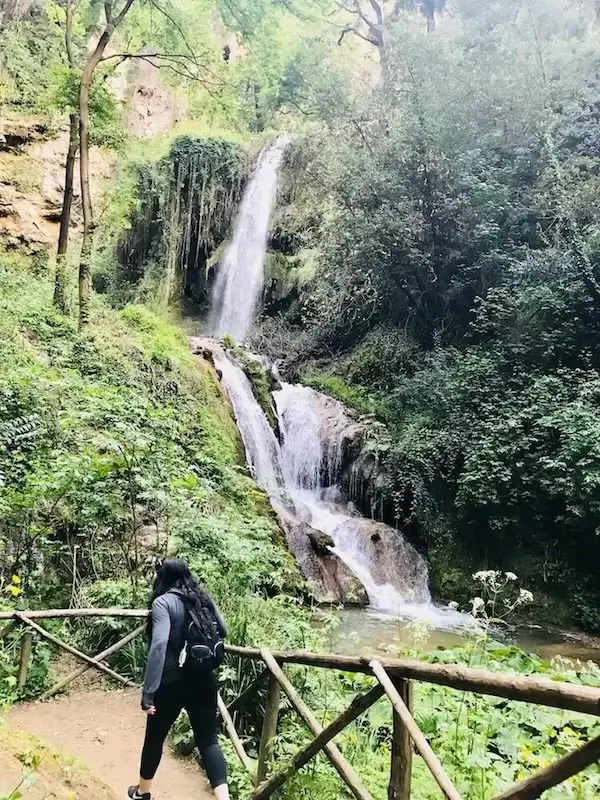
History: Pope Gregory XVI commissioned Villa Gregoriana around 1834. How to get there from the bus/train station: 5 minute walk Hours: From Tuesday to Sunday; (March, November and December: 10 am to 4 pm); (April to October: 10 am to 6.30 pm) Ticket prices: Adults €8.00 Children €3.00 Website: https://www.fondoambiente.it/luoghi/parco-villa-gregoriana
Villa D’Este
If you are looking for beautiful gardens, visit Villa D’Este. This landmark is part of the UNESCO World Heritage Site list and for good reason! This villa is richly decorated with fresco paintings but is known for the extravagant gardens and ancient fountains.
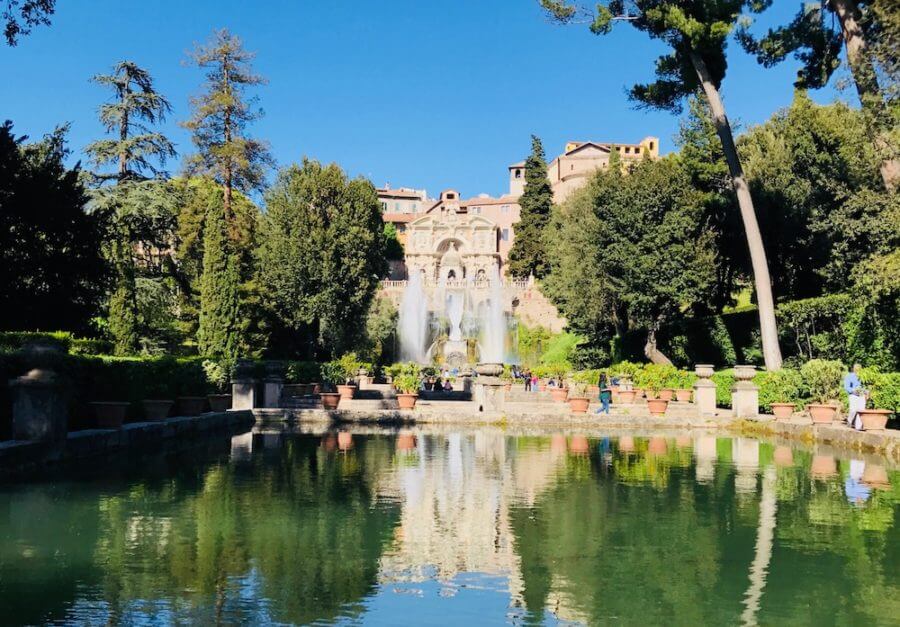
History: Cardinal Ippolito II D’Este, a former governor of Tivoli, commissioned Villa D’Este. The work started in 1550 but lasted for about 20 years. How to get there from the bus/train station: 13 minute walk towards the center of the city Hours: Monday to Friday: 8:30 AM – 7:45 PM; closing time of the gardens varies depending on the month (ranges from 4:45 PM – 7:30 PM) Ticket prices: standard ticket €12.00 Website: https://www.levillae.com/en/the-locations/villa-deste/
Villa Adriana
If you are looking for historic ruins, visit Villa Adriana (or Hadrian’s Villa). This landmark is also listed as a UNESCO World Heritage Site and is one of the best kept, most visited archaeological sites in Italy.
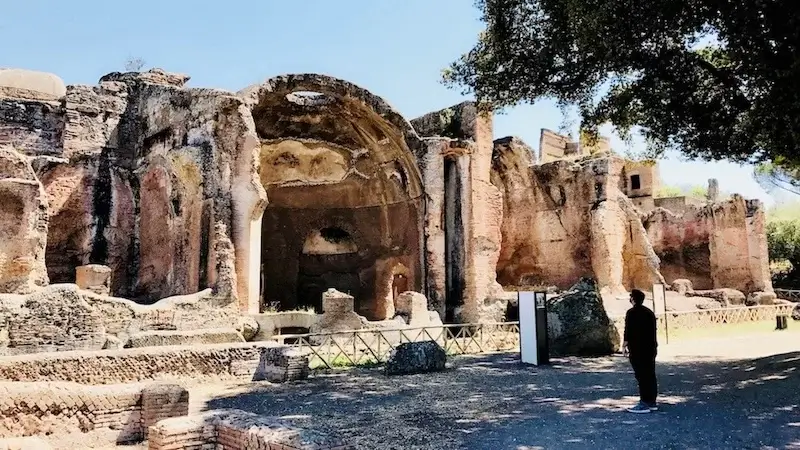
History: Roman Emperor Hadrian built Villa Adriana at the foot of the Tiburtine Hills between 118 and 138 AD. How to get there from the bus/train station: From the Tivoli station take the CAT bus n.4 for 11 stops, getting off at the Villa Adriana stop. The bus stop is 300 meters from the villa entrance. Hours: Monday to Sunday: opening time 8:30 AM; closing time is dependent on the month (ranges from 5:00pm – 7:30pm) Ticket prices: standard ticket €10.00 Website: https://www.levillae.com/en/the-locations/villa-adriana/
Where to eat in Tivoli
Take a break between any of these activities to grab a bite! For a great atmosphere and delicious food, my recommendation is the popular Ristorante Sibilla . It is the oldest restaurant in Tivoli. Located next to Villa Gregoriana, it’s ideal to grab lunch after visiting the villa or dinner right before catching the bus/train back to Rome.
Other dining options include Restaurant and Pizzeria Il Ciocco, Ristorante “La Quercia”, Taverna Quintilia, Parco dei Laghi Reali, Ristorante Il Borghetto, or Ristorante 5 Statue.
Where to stay in Tivoli
While this is an easy day trip from Rome, there are some accommodations available if you want to experience Tivoli for multiple days. There aren’t many hotels in the center of the city, but B&Bs provide a great alternative!
Tivoli acts as the perfect escape from the city. I was stunned at the beauty of it and the fact that I never heard about it before doing in-depth research. If you have the time, don’t miss this destination!
Related posts
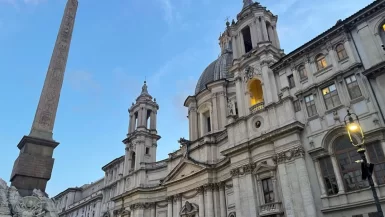
2-Week Europe Itinerary: Ultimate Guide for an Unforgettable Trip

The Perfect 1-Day Anchorage Itinerary You Need

The Best 3-Day Denver Itinerary
Leave a reply cancel reply.
Your email address will not be published. Required fields are marked *
Save my name, email, and website in this browser for the next time I comment.
Privacy Overview
- Shop Now! 🚚 Free Shipping on all orders in Europe, UK, Canada & US!
- 🇮🇹 Explore Italy on Foot
Day Trip from Rome to Tivoli
Are you planning a trip to rome.
Just add another couple of days to your itinerary and enjoy a visit to the picturesque area surrounding the Italian capital! You’ll find plenty of beautiful historic places just a few kilometres away from Rome. Among the not-to-be-missed destinations, there’s one place that really stands out: the town of Tivoli with its amazing Villas!
How to get to Tivoli from Rome?
By car If you have already planned to rent a car to drive around the entire Lazio Region, that’s the perfect way to reach Tivoli quickly and easily. You’ll get there in about 40 minutes from Rome’s city centre. Just take the motorway A24 or choose Tiburtina or Prenestina road. Pay attention to rush hours, especially during weekdays: you might find yourself in a big traffic jam! In Tivoli, you can leave your car in a free parking in Lunganiene Giuseppe Impastato or in Viale Cassiano.
By bus Cotral Company has a direct line connecting Rome to Tivoli. Buses leave from the metro station Ponte Mammolo (blue line B). There are frequent rides and the journey takes about 50 minutes. Tickets are really cheap too (about 2 euro). This option has the same disadvantage of the previous solution: a lot of traffic during rush hours.
By train To avoid traffic jams you can choose to travel by train. The journey takes 1 hour and the ticket costs about 3 euro. Trains to Tivoli leave from Roma Tiburtina station, but there are frequent delays on this line.
What to see in Tivoli?
Tivoli is a nice town located on the Tiburtini mountains, just 30 Km away from Rome. Its foundation dates back to 1215 B.C. and its fame is due to local sulphurous waters and to its amazing Villas, which are part of the UNESCO’s World Heritage List.
Tivoli has always been an international tourist destination: it was even part of the so-called Grand Tour. It was a trip to Europe lasting several months that young noblemen used to take during the XVIIth and the XVIIIth centuries. Its aim was letting young men see the most important historic monuments and the most beautiful places around Europe. Several stops of the Grand Tour included Italian destinations, as evidence of the great importance and prestige of Italian art and culture throughout the centuries.
Villa D’Este
A place full of history and a garden with a magical and timeless atmosphere
If you love architecture and you’re especially into Renaissance art, this is the right place for you. Together with Villa Adriana, this palace is part of UNESCO’s World Heritage List. This magnificent building, which looks more like a royal palace than like a proper villa, was conceived by Cardinal Ippolito II d’Este around the half of the XVI century.
The huge Italian-style garden is an integral part of the complex and it is a real masterpiece, which inspired several European architects in subsequent years. Its beauty is largely due both to its great variety of plants and its many fountains, terraces, artificial caves and statues scattered everywhere. This garden offers many panoramic views and it is one of the most popular tourist attractions in Central Italy. One of the most popular spots of the garden is the avenue with the so-called “One-Hundred Fountains”: several marble masks and statues pouring water along a 100m long tree-lined path. If you like fountains, search for the Ovato Fountain, the Organ Fountain and the Neptune Fountain too.
Unfortunately, Cardinal Ippolito didn’t enjoy his mansion for a long time, since he died a few months after the end of the construction works.
Address P.za Trento, 5, 00019 Tivoli RM, Italy
Opening hours Tuesday-Sunday from 8.45 a.m. to 7.45 p.m. and Monday from 2 p.m. to 6.45 p.m. Please note that opening times may vary depending on the season ( more info here )
Website h ttps://villae.cultura.gov.it/en/opening-time-and-tickets/
Cost 13 euro – free for kids under 18 y.o. Online Tickets
Villa Adriana
Majestic ruins reminding of the splendor of the Imperial period
Villa Adriana is another symbol of Tivoli and it is much older than Villa D’Este. It was built by the Emperor Adriano between 118 and 138 A.C. It has an area of 1 square kilometre and it could fit in well in the Fori Imperiali area in the centre of Rome.
Adriano chose this place because of its closeness to the natural spring of sulphurous water called Acque Albule. The entire complex is an evidence of the wealth and prestige of the Emperor and the outdoor parts are the most impressive ones. Don’t miss the garden with a central pool, the Canopo (that is a water basin adorned with statues and the reconstruction of the Serapide temple of the Egyptian city of Canopo) and the private thermal baths of the royal family and its guests.
During your visit, you’ll probably bump into the so-called Maritime Theatre: it was Adriano’s favourite place to meditate or simply relax surrounded by peace and silence. It is a nice building located in the middle of a canal that could only be reached by a hand-actioned drawbridge.
Address Largo Marguerite Yourcenar, 1, 00010 Tivoli RM, Italy
Opening hours Every day: 8.15am – 7.30pm Please note that opening times may vary depending on the season ( more info here )
Cost 12 euro – free for kids under 18 y.o. Online Tickets
🚩 If you are planning to stay overnight, don’t miss the chance to visit these two Villas late in the evening: special openings are scheduled during the summer months (until 11.30 p.m.) and several cultural events and shows are hosted inside the parks. .wp-block-gutenbee-testimonial.block-3b5423-c85f-43 .gutenbee-testimonial-avatar img { width: 150px; } .wp-block-gutenbee-testimonial.block-3b5423-c85f-43 .wp-block-testimonial-content-wrapper { font-size: 17px; } .wp-block-gutenbee-testimonial.block-3b5423-c85f-43 .gutenbee-block-testimonial__citation { font-size: 17px; } .wp-block-gutenbee-testimonial.block-3b5423-c85f-43 .gutenbee-block-testimonial__info { font-size: 15px; }
If you still have some time for your visit to Tivoli, you can also visit these historic sites:
Villa gregoriana park.
Immerse yourself in a relaxing natural environment
If you feel like spending some time surrounded by a beautiful natural landscape, come here and enjoy a sunny day strolling in the park and taking pictures. You’ll find waterfalls, caves and nice shady paths.
Address Largo Sant’Angelo, 1, 00019 Tivoli RM, Italy
Opening hours Every day: 10.00am – 5.30pm Please note that opening times may vary depending on the season ( more info here )
Website https://fondoambiente.it/parco-villa-gregoriana-eng/
Cost 10 euro – free for kids under 18 y.o. Online Tickets
A real castle in the heart of the town
Just a few steps from the modern part of Tivoli, you’ll find a Renaissance castle with its 4 majestic towers. Take a guided tour to discover its history and hidden secrets.
Address Vicolo Barchetto, 00019 Tivoli RM, Italy
Opening hours Only on Saturday and Sunday (just for guided tours)
Website https://www.visittivoli.eu/edifici-storici/rocca-pia
Acropolis of Tivoli
A legendary archaeological site
Here you’ll have the chance to visit the ruins of Vesta Temple and Sybille Temple. This spot is also perfect to admire Villa Gregoriana Park from above.
Address Via della Sibilla
Your itinerary for the perfect one-day trip to Tivoli
- Departure from Rome by bus towards 9 a.m. Buses are the best option in terms of price and duration of the journey. For more information about timetables and stops read here https://servizi.cotralspa.it/Orari
- Arrival in Tivoli towards 10 a.m. Get off at Villa Adriana stop (just 300 m from the main entrance).
- Spend a couple of hours visiting Villa Adriana.
- Lunch nearby (ex: Pizzeria La Pergola in via Rosolina 2 or Bonadea restaurant in via Rosolina 100).
- To reach Villa D’Este, you can catch Cotral bus again in the opposite direction and get off at Piazza Garibaldi stop (about 200 m from the main entrance).
- Spend a couple of hours visiting Villa D’Este.
- Before heading back to Rome, you can also make a short stop at Villa Gregoriana Park and rest surrounded by nature. To reach the park you just need to take a 10minutes’ walk from Villa D’Este.
Best period for your trip to Tivoli?
May and June to enjoy warm and sunny weather and avoid summer’s hot days and crowds of tourists. Late Spring is also the ideal period to enjoy the gardens at their best.

Visitor’s Guide to Villa d’Este in Tivoli, a Magical Day Trip From Rome
Here’s my complete guide to visiting the UNESCO-listed site of Villa d’Este in Tivoli Italy.
Villa d’Este is the lush and watery country estate and gardens of a Catholic cardinal. It makes the perfect day trip escape from Rome, just a half hour away.
The sumptuous late Renaissance estate is reconfigured into a mountainside. It’s a dramatic fusion of architecture and landscape. It’s a playground of whimsy, topped with a frescoed villa.
Built into a cliff, Villa d’Este’s terraced gardens are one of Europe’s most beautiful green spaces.

There are waterfall fountains, ornate staircases, spiky cypress trees. The gentle murmur of water iseverywhere. Statues of ancient deities complete the enchanting tableaux.
If you’ve had your fill of Rome’s urban intensity and adoring tourists, pretty and playful Tivoli is a delicious escape. No other garden has such spectacular waterworks and theatrics.
You can trade the cacophony of Rome for mossy grottos and water lilies. If you have a soft spot for sparkling fountains, Villa d’Este is a must visit town in Italy .
Cardinal Ippolito d’Este
Villa d’Este was the passion project of a cardinal whose papal ambitions were thwarted, Cardinal Ippolito d’Este. Ippolito was born to a wealthy family. As was the case with the Doria Pamphilj family, nepotism was an immense help on the road to success.
Ippolito’s parents were the notorious Lucrezia Borgia (the daughter of the equally notorious Pope Alexander VI) and Alfonso d’Este. He had a fast-tracked ecclesiastic career and became cardinal at age 30.
In 1550, however, the ambitious cardinal’s greatest hopes were dashed when he failed to become pope. As a consolation prize, the conclave winner, Julius III, appointed Ippolito governor of Tivoli. He gifted him a small villa that was a former convent to soothe the cardinal’s disappointment.
But the spartan governor’s palace didn’t suit a man used to luxury who lived like a secular prince.
So Ippolito decided to build a grandiose pleasure palace. He wanted a garden villa worthy of “one of the wealthiest ecclesiastics of the sixteenth century.”
History of Villa d’Este
Ippolito hired the famous architect Pirro Ligorio and a raft of craftsman and painters.
His builders expropriated and tore down part of the former Franciscan monastery to clear the site. They diverted the Aniene River to provide water for the lavish gardens and fountains.
Ippolito decorated the villa with stunning frescos, with religious, mythological, and historical themes.
He created fountains galore — tiny drinking fountains, reflecting pools, and a fountain that played organ music. The stunning result was the world’s most beautiful and most imitated Italian Renaissance garden.
Ippolito’s guests arrive in small carriages, gazing at the magnificent villa from below. They would proceed through the gardens, each terrace revealing a different jardins des merveilles , or garden of miracles. The gardens were used to stage lavish parties.
But part of Villa D’Este’s beauty came at the expense of the nearby Hadrian’s Villa , just 5 minutes away. Ligorio was conveniently excavating Hadrian’s Villa while he worked on Villa d’Este. Ippolito had his architect carry off marble, mosaics, and statuary from the abandoned 1st century villa.
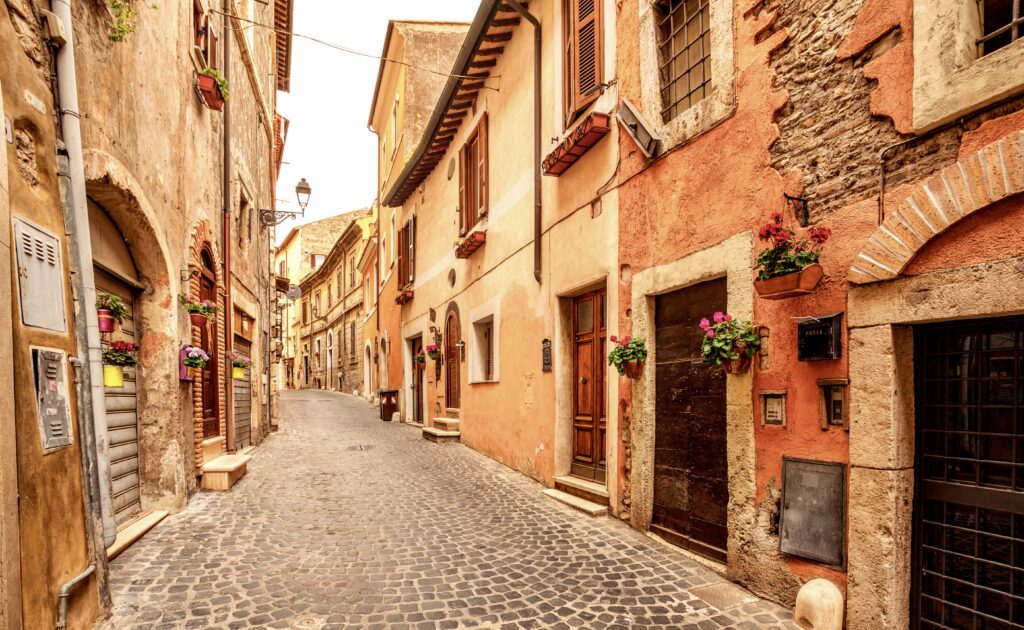
Cardinal Ippolito died in 1572, after being expelled from the church by Pope Paul IV. He was convicted of simony, the white collar sin of lining one’s pockets by selling church roles and sacred relics.
Villa d’Este was bequeathed to the d’Este family. Ippolito’s successors enriched the villa with new fountains, including one by the famous Baroque sculptor, Gianlorenzo Bernini .
It eventually passed into the Hapsburgs’ greedy hands. After the peace treaty of WWI, Villa d’Este became the property of the Italian state.
With enormous upkeep expenses, the villa fell into disrepair. Eventually, it was fully restored, beginning in 1851. In the 1920s, Villa d’Este was opened to the public. In 2001, it became a designated UNESCO site.
Guide To Villa D’Este: What To See
There are so many things to see at Villa d’Este on the palace and garden grounds.
The villa itself is a bit of an empty shell, with the furnishings and decor long gone. But most of the vibrant frescos and painted ceilings remain. (Some were destroyed during WWII.)
The frescos are superb, depicting scenes from Roman history, mythology, and religion. They were painted by the best artists of the late Renaissance and Mannerist period, including Duranti Alberti, Girolamo Muziano, Flaminio Bollinger, Emilio Moretti, and Frederico Zuccari among others.
1. The Upper Palace
You enter the villa via a side entrance. A double stairway leads you to the upper floor. This floor served as the private apartments of Cardinal Ippolito.
The most interesting rooms are the Throne Room, the bedroom, the private study, and the chapel. Another five rooms off to the right complete the upper palace.
2. The Lower Level | Noble Apartment
The lower level served as the guest quarters. The highly decorated rooms are connected by a corridor called the Manica Lunga.
It’s topped with a barrel vault covered with beautiful 16th century 3D mosaics, making it feel like you’re in a rose garden. The rooms on this level are each decorated with a specific theme, connected to nature, mythology, and water.
You enter directly into the most distinguished room, the Central Room, also known as the Hall of the Fountain. The entire vault is decorated with frescos and boasts a beautiful mosaic fountain.
The mosaic fountain is encrusted with pieces of glass, seashells and precious stones, and crowned by the omnipresent white eagle of the d’Este family.
The central painting is based on a Raphael fresco from the Villa Farnesina in Rome’s Trastevere neighborhood. This was the room where Cardinal Ippolito entertained guests or held concerts.
The First Hall is dedicated to the founding of Tivoli, depicting the legendary origins of the town. The Hall of Hercules depicts the labors of Hercules, who was considered the founder of the d’Este family.
The Hall of Moses features a fresco depicting Moses striking a rock to create water for the people of Israel. This was an allusion to the cardinal, who had brought water to the Villa gardens by making channels through the rock.
There are many other rooms. It would take forever to describe them. And the most fabulous part of the tour awaits outside.
3. The Garden and Fountains
Off the Central Room a small loggia offer the first dramatic views of the main event — one of the world’s most beautiful landscaped gardens. They were designed and built by Pirro Ligorio over 17 years.
A double stairway leads you down to this bucolic retreat. Set over 35,000 square meters, it will blow you away.
Try to allot sufficient time so that your visit isn’t rushed. Ideally, you’ll have a leisurely revel amidst the thundering fountains, placid pools, grottos, waterfalls, and natural beauty.
The 50 large fountains and 250 water jets are all gravity powered, a miracle of Renaissance plumbing.
The garden is a combination of terraces and slopes. There’s one central longitudinal axis and five transverse axes.
Paths link the fountains together. The total effect is reminiscent of the beautiful gardens of the Royal Alcazar in Seville .
The central axis leads down to the Bicchierone Fountain. Bicchierone means large drinking glass.
Built in 1661, the monumental stone fountain was designed by legendary Baroque sculptor Gian Lorenzo Bernini . The fine lines of the fountain dramatically represent a chalice held up by a giant seashell.
From the Bicchierone Fountain, turn left and you’ll see the Rometta Fountain. This fountain is a fantastical miniature recreation of important Roman buildings and symbols.
It was designed by architect Ligorio, possibly with assistance from Ippolito. It’s reached by a small bridge spanning a curving canal.
There’s a small scale model of Tiber Island in Rome in the shape of a boat in the basin. At the center of the island is a statue of Victorious Rome , sculpted by Pietro Lamotte, and the Roman She Wolf nursing the twins Romulus and Remus. (The original She Wolf sculpture is in Rome’s Capitoline Museums .)
Some original parts of the Rometta ensemble — including the Colosseum, Pantheon, and Arch of Titus — were demolished by the passage of time.
At the center of the Villa d’Este gardens lies the beautiful Fountain of the Dragons. It’s a true gem incorporating the best of art, architecture, and sculpture.
This fountain was also designed by Ligorio, who created two harmonious staircases to embrace the vivacious fountain. Four moss covered dragons, meant to be frightening, spout rockets of water though open mouths.
The fountain is also known as the Fountain of the Girandola, which means rotating waterworks. Recently restored, the fountain spouts mighty jets of water skyward in a complicated pattern.
Then, stroll along the enchanting Avenue of the Hundred Fountains, which leads from the Rometta Fountain to the Fountain of Ovato. Allegorically, the avenue represents the Aniene River, which runs from Tivoli to Rome.
The path is lined with sculptures gushing and gurgling water. Above them, you’ll see other sculptures of lilies, obelisks, boats, and eagles.
As mentioned above, the eagles belong to the coat of arms of the d’Este family. The marble wall, now corroded by time, was originally carved with episodes from Ovid’s Metamorphoses .
The Fountain of Ovato, or Oval Fountain, is also known as the Fountain of Tivoli. It’s perhaps the loveliest and most elegant fountain at the villa.
This magnificent Baroque fountain takes its name from its oval shape. At the back, a semi circle of pilasters hold bases from which water flows. The statue of Pegasus appears about to soar. You’ll also see the Sibyl of Tibur holding the hand of her son.
The fountain is bordered by a grotto like half moon terrace with a marble balustrade. The water basin below is lined with a semi circulate nymphaeum.
In the niches are statues of nymphs holding vases with flowing water. The bottom of the basin is covered in colorful ceramic lilies and the d’Este coat of arms.
At the end of the lane bordering the fish pond is the Fountain of Neptune, right under the Fountain of the Organ. In terms of impressive water displays, this fountain is likely the grandest in the villa.
And it’s the newest. It was built in the 1920s by Attillio Rossi, then curator of the Villa d’Este.
Twelve strong jets hurl water skyward at different heights, some reaching 45 feet. The lower basin calms the frothy waters to suit the adjacent fish ponds.
In the middle, there’s a bust of Neptune. But it’s hard to actually see the bust with the veils of water and mist.
Then, walk up the stairs to inspect the amazing Fountain of the Organ, a stunning engineering achievement created by Frenchmen Claude Venard. The fountain has a hydraulic system consisting of 144 pipes controlled by a water powered pin roller.
This water driven mechanism recreated the sounds of an organ. Legend holds that, when Pope Gregory XII visited the villa, he couldn’t believe his ears. He insisted on a tour of the fountain interior to ensure there weren’t musicians inside.
As befitting its Baroque era creation, the facade is extravagantly decorated. You’ll see seashells, coats of arms, stucco panels depicting mythological themes, winged victories, etc. A d’Este eagle with outstretched wings is perched at the top of the tympanum.
In 2003, the fountain was repaired and its ability to play “music” restored. Now, it plays for four minutes every two hours.
As you stroll through the rest of bucolic gardens, you’ll come on other interesting fountains, gargoyles, and grottos. There are plenty of nooks and crannies to explore.
I was quite taken with the Fountain of Diana of Ephesus. Diana is the goddess of wood and wildlife and protector of women. The many breasts are a symbol of fertility and childbirth.
The Grotto of Diana is also quite lovely. Four statues once adorned the cave — 2 amazons, Minerva, and Diana. They were subsequently acquired by Pope Gregory XIII, who then donated them to the Capitoline Museums in Rome.
The Mete fountains are also in the lower garden, in the middle of two flower beds. They are large circular boulders one atop another covered with moss. They are a symbol of the sweating cone fountain in Rome, which sweated rather than jetted water.
Practical Guide & Tips for Visiting Villa d’Este
Address : Piazza Trento 5, Tivoli, Italy
How to get to Villa d’Este:
It’s an easy 30 minute drive by car. By train, catch a direct train on the Roma-Pescara Line from Rome’s Tiburtina station to Tivoli. It takes about a half hour.
Then, you take a shuttle bus to the town center. Signs point you to the entrance on Piazza Trento. There’s a local bus that shuttles between Villa d’Este and Hadian’s Villa. If you don’t want to arrange your own transport, the easiest thing to do is book a guided day tour .
Hours : Open Tues through Sun 9:00 am to 1 hour before sunset. Since hours vary by season, be sure to check the website when planning your day trip.
Enty fee : 13 euros. Click here to book a skip the line ticket.
When Is the Best Time To Go : Spring is the prettiest time to visit Villa d’Este. You’ll be wowed by the wisteria and jacaranda blooming. But fall is pretty too, with showy yellow and red colors.
Pro tip : Be forewarned, there’s a lot of steep stairs to climb up and down. Plan on spending half a day here, taking in all the delights without rushing.
I hope you’ve enjoyed my guide to Villa d’Este. If you’re planning a trip top Rome, you may enjoy these other Rome travel guides:
- 8 ways to spend 1 day in Rome
- 3 day itinerary for Rome
- 5 day itinerary for Rome
- Hidden gems in Rome
- Best museums in Rome
- Archaeological sites in Rome
- Guide to the Borghese Gallery
- Guide to Palatine Hill
- Guide to the Roman Forum
- Guide to the Colosseum
- Walking tour of central Rome
If you’d like to visit Villa d’Este in Tivoli, pin it for later.
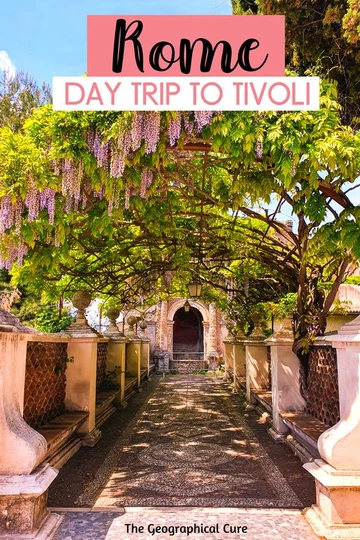
Leave a Comment Cancel reply
Save my name, email, and website in this browser for the next time I comment.
Last Updated on January 25, 2023 by Leslie Livingston
- Skip to right header navigation
- Skip to main content
- Skip to primary sidebar
MY WANDERLUSTY LIFE
#TimeBudgetTravel
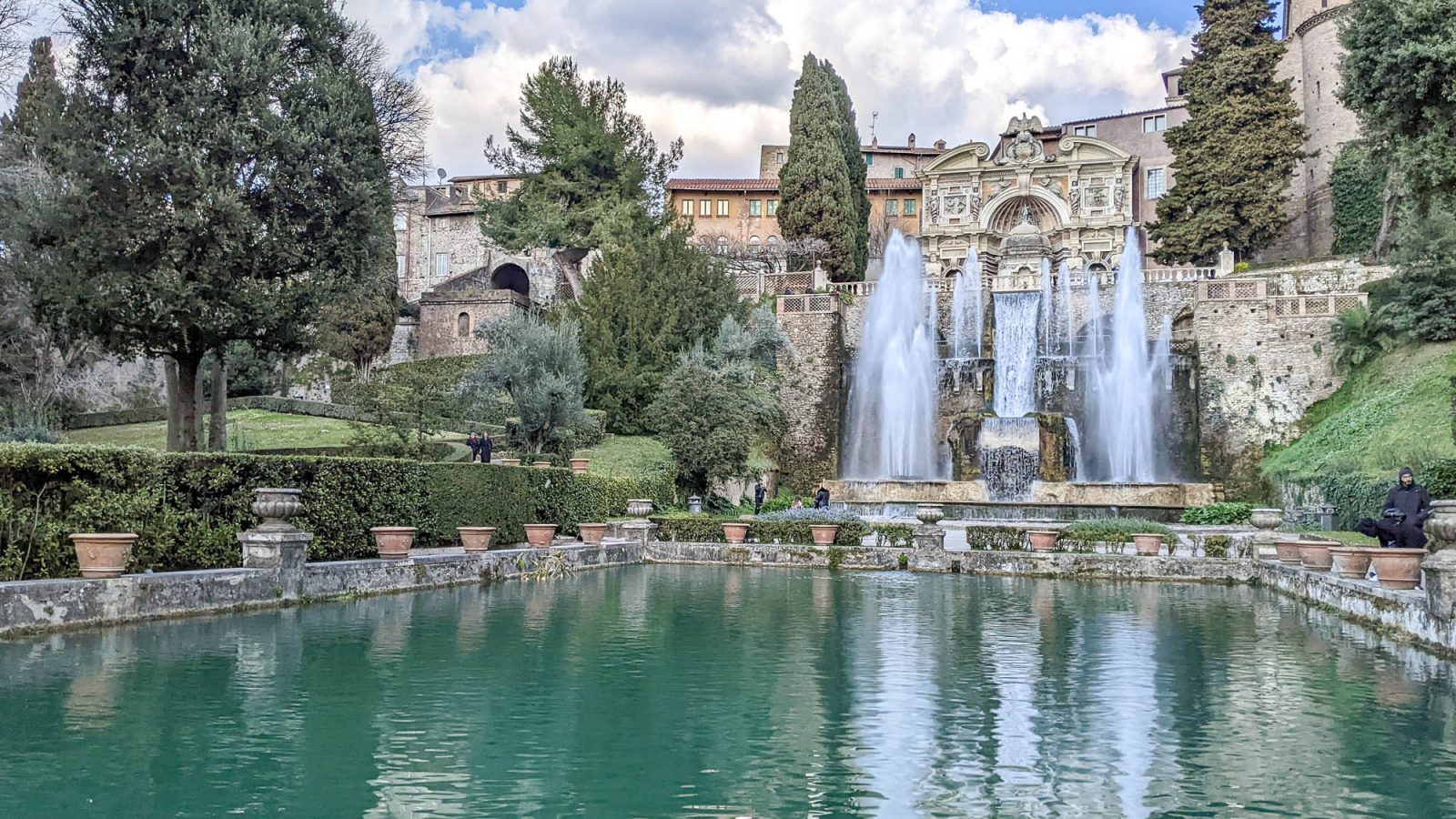
How to Spend 2 Days in Tivoli, Italy: Exploring the Gardens of Tivoli and Beyond
Last Updated: June 27, 2023 // by Ashley Smith 2 Comments
The day before I decided to go there, I also was wondering, “Is spending 2 days in Tivoli worth it?” I had only vaguely heard of this place but knew nothing about it. On my recent trip to Italy (March 2022), winging it was the theme. After our two days in Montepulciano, we wanted to head south and to a bigger city.
While trying to decide where to go after breakfast the next morning, my husband asked if there was a big city that’s right outside of Rome or something like that where we could go. And given that Tivoli has a bigger font on the map than others, that’s where we chose! (Yes, I often choose destinations based on their font size on the map. I did this for my adventure in Aosta, Italy and my two days in Turin, Italy as well!)
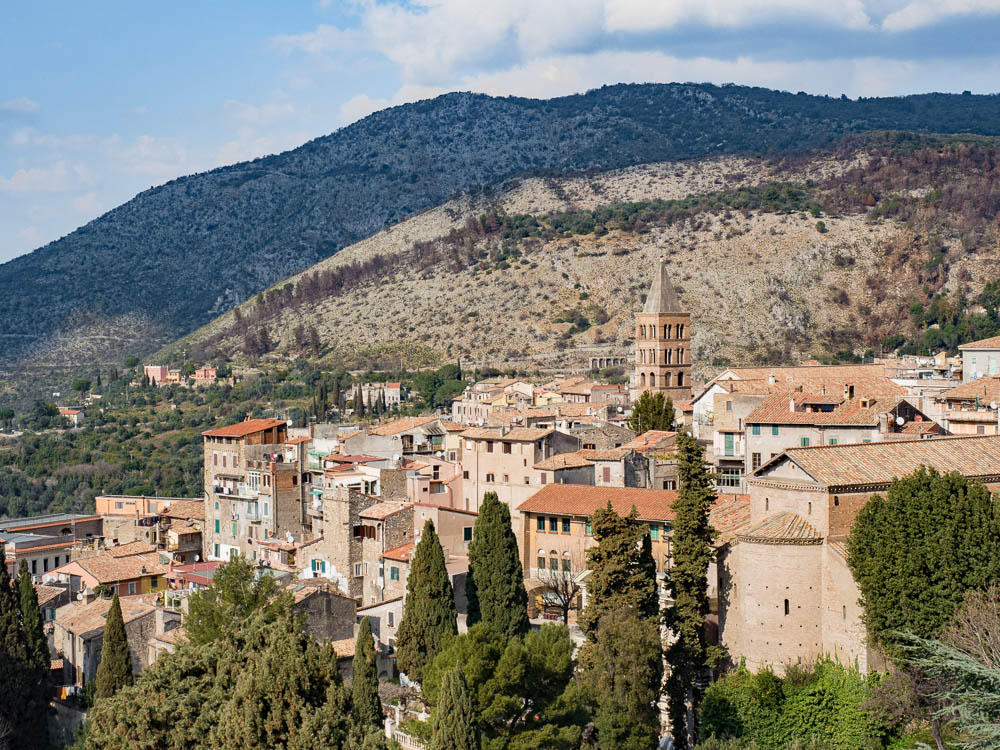
And guess what? Tivoli is AWESOME. I’m sad I only had two days there and I’ve definitely put this very cool city on my list of places to return to. So, don’t miss out on this totally under-the-radar destination on your next trip to Italy. Here’s what you need to know about visiting and your guide to spending 2 days in Tivoli.
Table of Contents
So, why visit Tivoli, Italy?
Tivoli, Italy is an ancient hill-top city about 45-minutes east of Rome. Back in the day, it was seen as a “retreat” from the busy city life of Rome and every emperor and his brother had a sprawling and elaborate villa here. It’s where they ruled Rome from when they didn’t want to rule Rome from Rome. You can think of it like: Tivoli is to Rome what Versailles is to Paris. King Louis XIV was the new Emperor Hadrian.
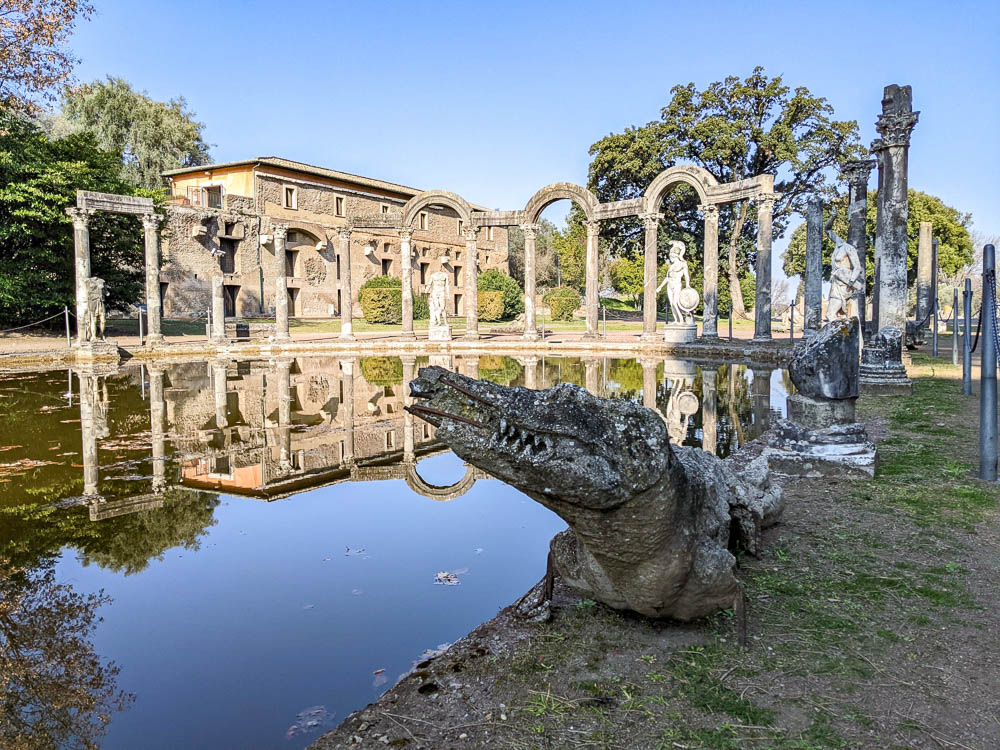
Fortunately for us in the 21 st century, much of these ancient villas still stand and are now the biggest draw to the city of Tivoli. While Tivoli is very much a bustling city now and a welcome change from the off-season isolation of Montepulciano in Tuscany, Tivoli is certainly not as big and bustling as Rome. It is still very much a “retreat” from Italy’s capital.
Subscribe to MWL!
How long to spend in tivoli, italy.
Because of its proximity to Rome, most travelers visit Tivoli on day trips. There are many day trip options that include transportation and are easy to take and will show you a sampling of what this cool city offers.
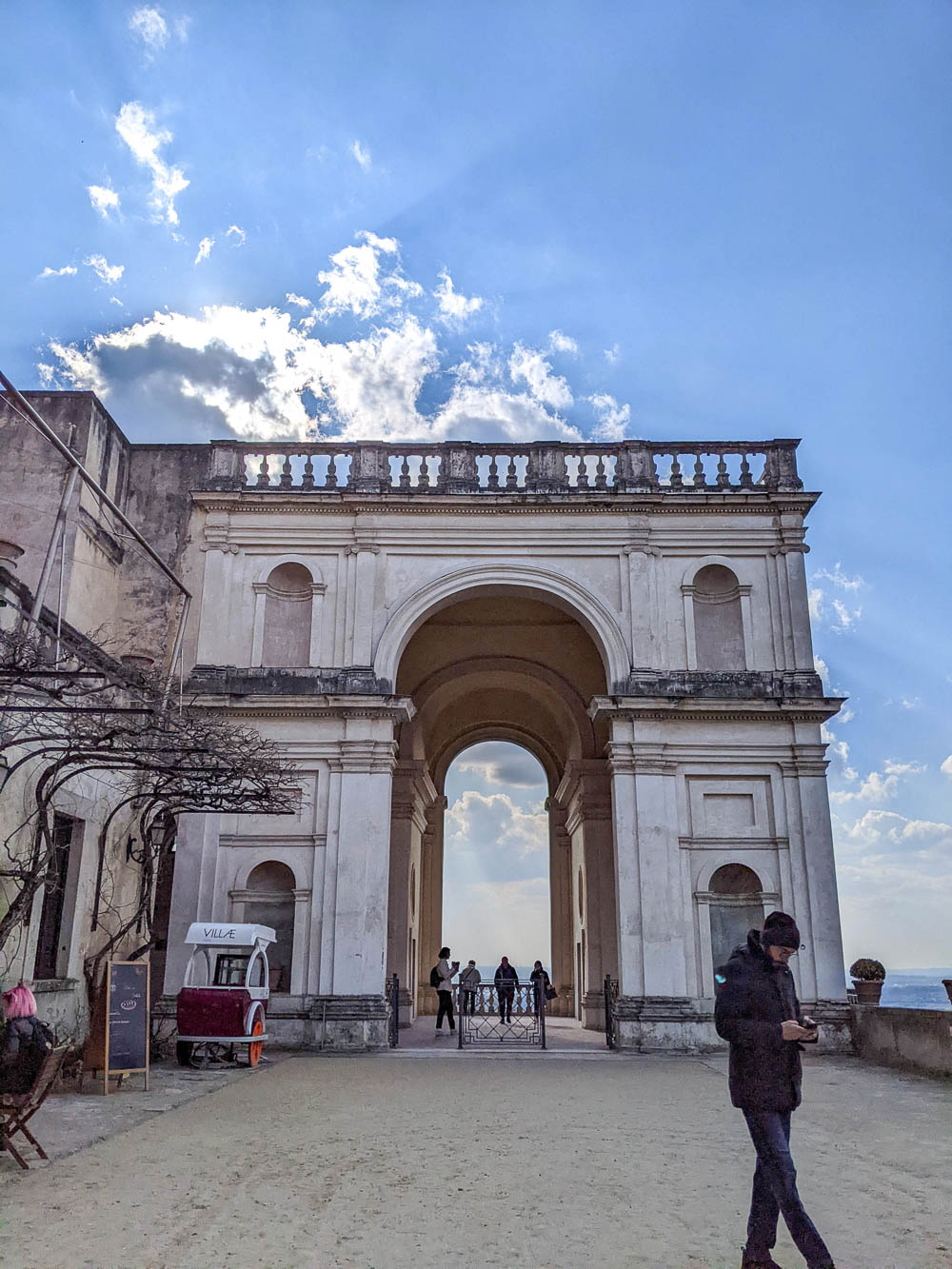
However, to see even just the three most popular sites in Tivoli (and you’ll want to see all 3!) you need at least two days. This is because:
- The opening days/times of each site + how long you’ll need to spend at each + traveling between them makes visiting more than two in one day just impossible.
- If you don’t have your own car and will be relying on public transportation, getting between the sites will take a bit longer. (Do yourself a favor, check out rental car deals here so you can travel around Italy at your own pace!)
That said, I spent 2 days in Tivoli concentrating on the top three sites and I definitely wish I had planned more time there. There are so many cool ancient sites to see, the city itself is worth more exploration, and this place just has the best vibe. But, if you’re short on time like I was, aim for at least two days.
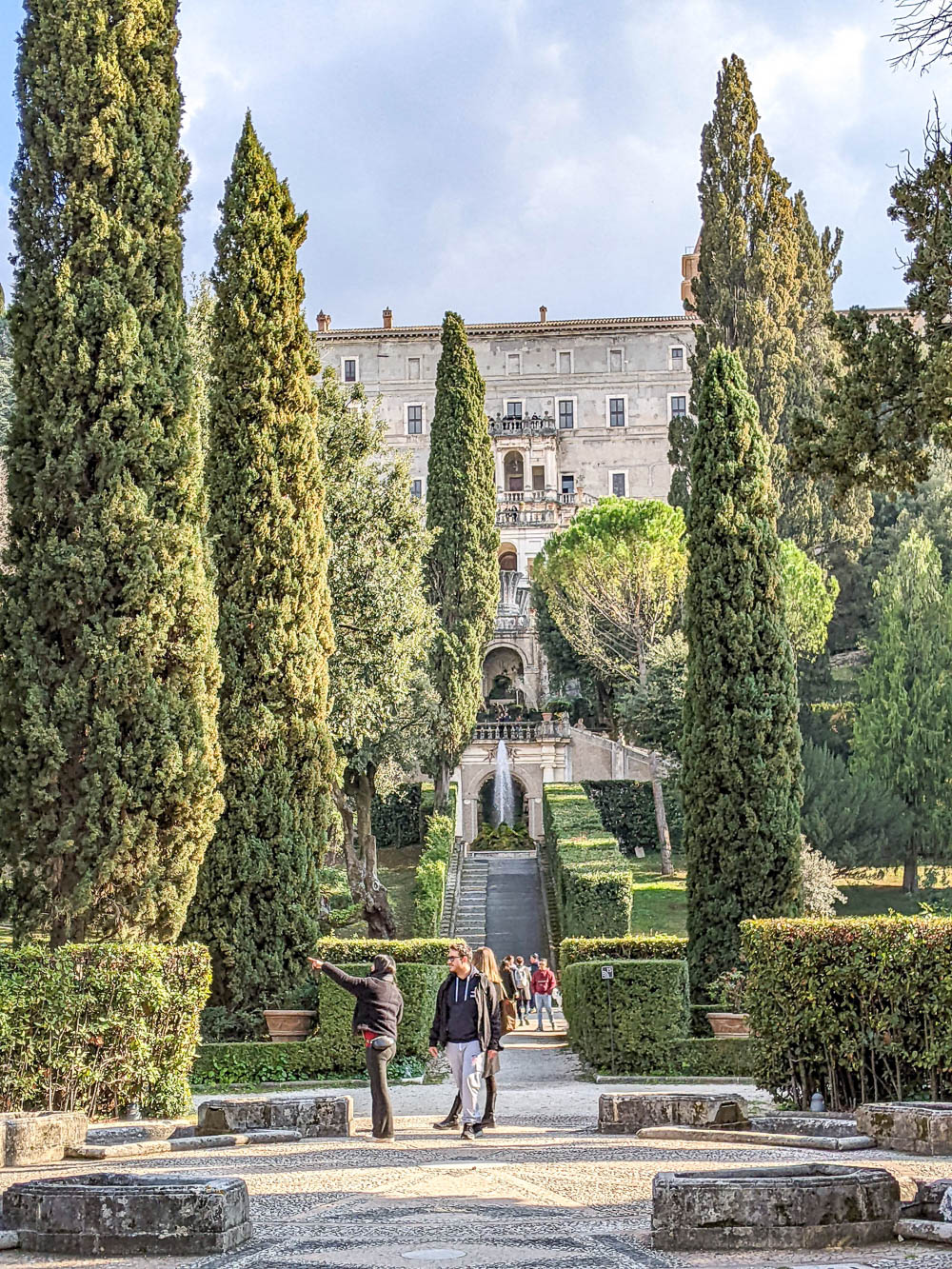
Day trip to Tivoli from Rome
It’s totally understandable if you don’t have more than a day to devote to visiting Tivoli. After all, we’re all time budget travelers around here. If this is you, know that even a day trip to Tivoli is worth it if that’s all you can squeeze in. And if that’s the case, the easiest and most stress-free way to do this is via an organized tour.
On a day trip to Tivoli from Rome you’ll at least be able to visit the city’s two most popular sites: Villa Adriana and Villa d’Este. The trip each way is about 45 minutes via your own air-conditioned bus and you’ll have a knowledgeable local guide explaining what’s what. (But you’ll still have plenty of free time to explore on your own.)

If this sounds like the way to go for you, check out this highly-rated Tivoli Day Trip from Rome . It includes everything I just mentioned: a dedicated guide, air conditioned transportation, and a visit to Tivoli’s top two sites. (And cost-wise it’s the best deal out there!)
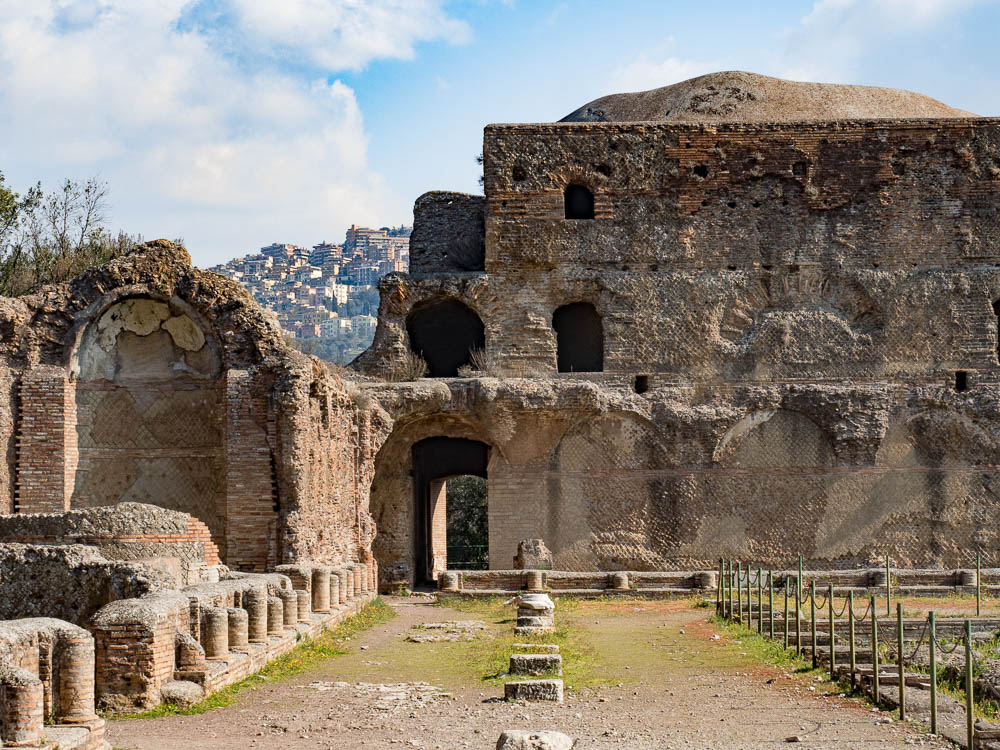
What to do in Tivoli in 2 days
But, if you have more than a day to dedicate to this ancient and beautiful town, here’s what you can see and do with 2 days in Tivoli. For starters, you’ll want to check out Tivoli’s three main sites: Villa Adriana (Hadrian’s Villa), Villa d’Este (the Gardens of Tivoli), and Villa Gregoriana (my favorite).
Villa Adriana – Hadrian’s Villa
One of the most ancient sites in Tivoli is Villa Adriana, more commonly known as Hadrian’s Villa. It was built in the 2 nd century A.D. at the behest of Roman Emperor Hadrian and served as his home-away-from-Rome.
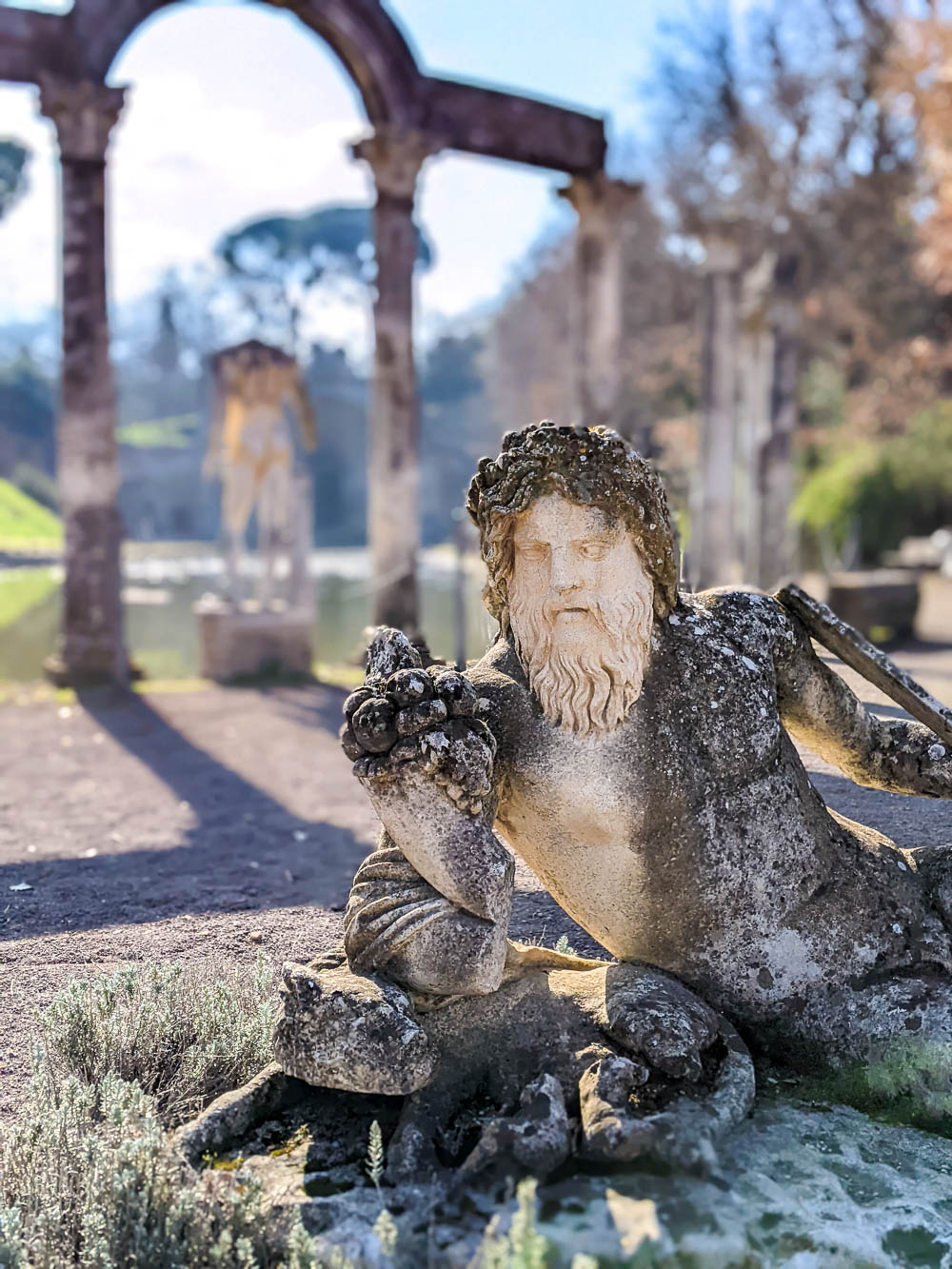
And it. is. huge. Hadrian’s Villa encompasses almost 300 acres and contains tons of buildings and other structures, ancient Roman art, pools, flora and fauna, and tons more. Basically, it was like a small Roman city of its own during its time. However, given its age and the fact that it was voraciously pillaged after the fall of the Roman Empire, this massive complex is essentially all ruins at this point.
However, that does not make it less interesting at all! There is still tons of interesting art and architecture to see here. You should plan on at least 2 hours here, but maybe more like 3 simply because of its size.
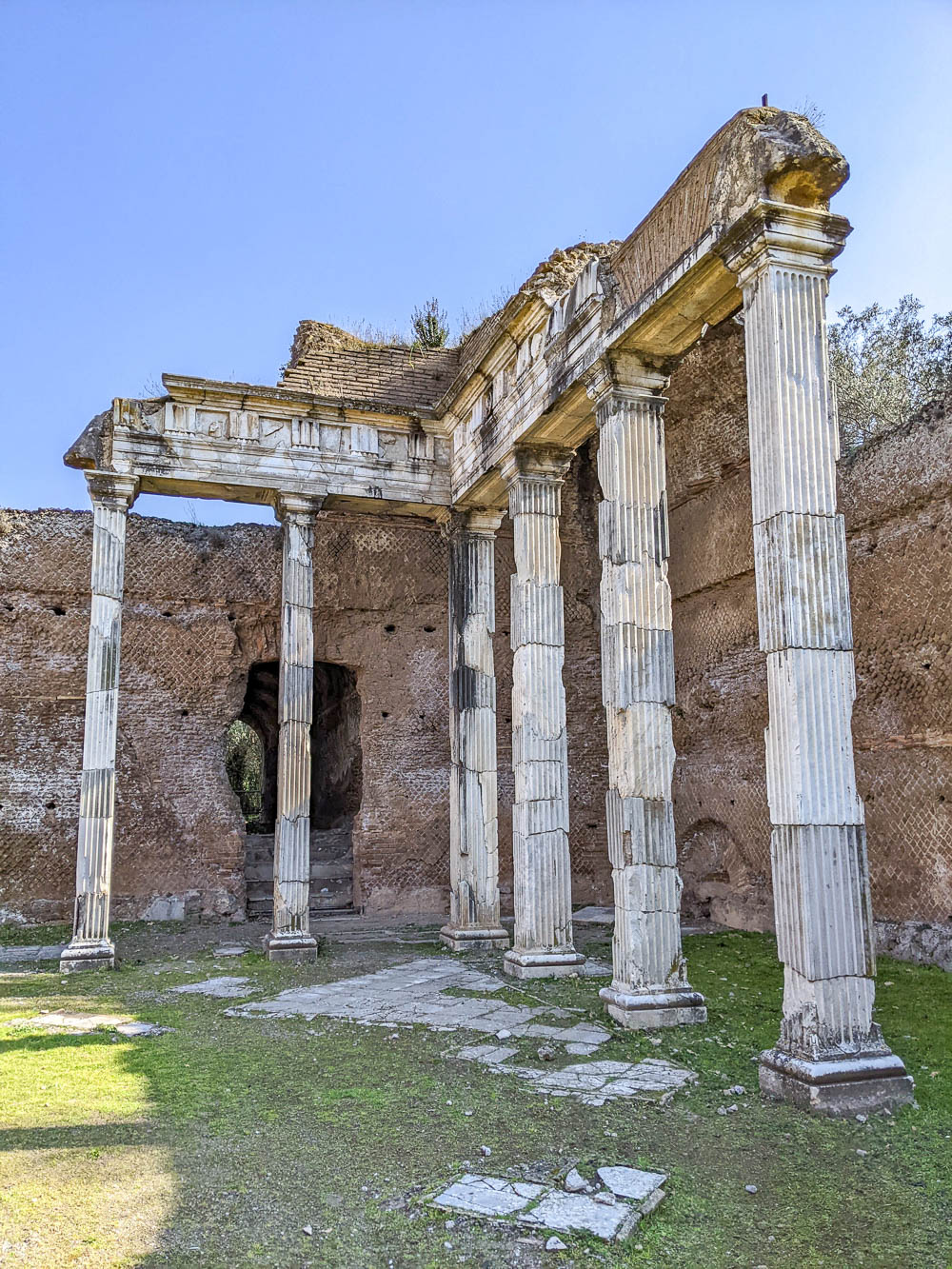
When you arrive, take a look at the informational signs inside the park. Besides a giant map of the complex, it tells you which areas to concentrate on if you’re in a hurry (basically, the highlights), which to see if you have a little bit more time, and all the places to check out if you have an entire day to spend. Base your time at Hadrian’s Villa around this plan for an easy itinerary.
Check out Villa Adriana’s historical UNESCO info here, and get visiting information here.
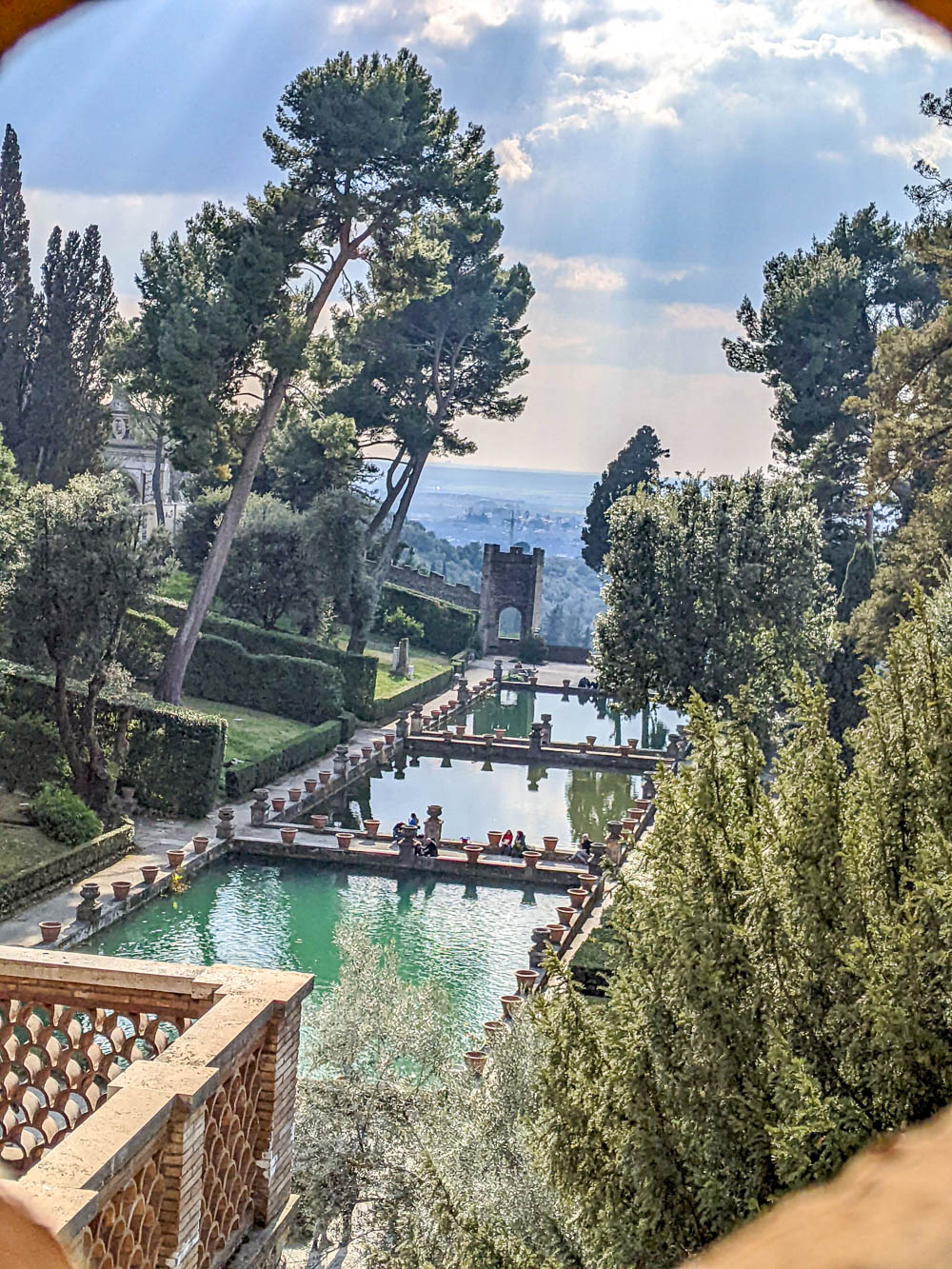
Villa d’Este – the Gardens of Tivoli
When people talk about “the Gardens of Tivoli,” what you’re hearing about is Villa d’Este – another massive, decadent complex you must see during your 2 days in Tivoli.
Villa d’Este was constructed in the mid-1500s and is one of the best examples of Renaissance garden splendor. It takes up about 11 acres that appear somehow hidden in the center of Tivoli. The Villa d’Este complex includes a residential palace (Palazzo d’Este), a series of gardens, and hundreds of fountains.
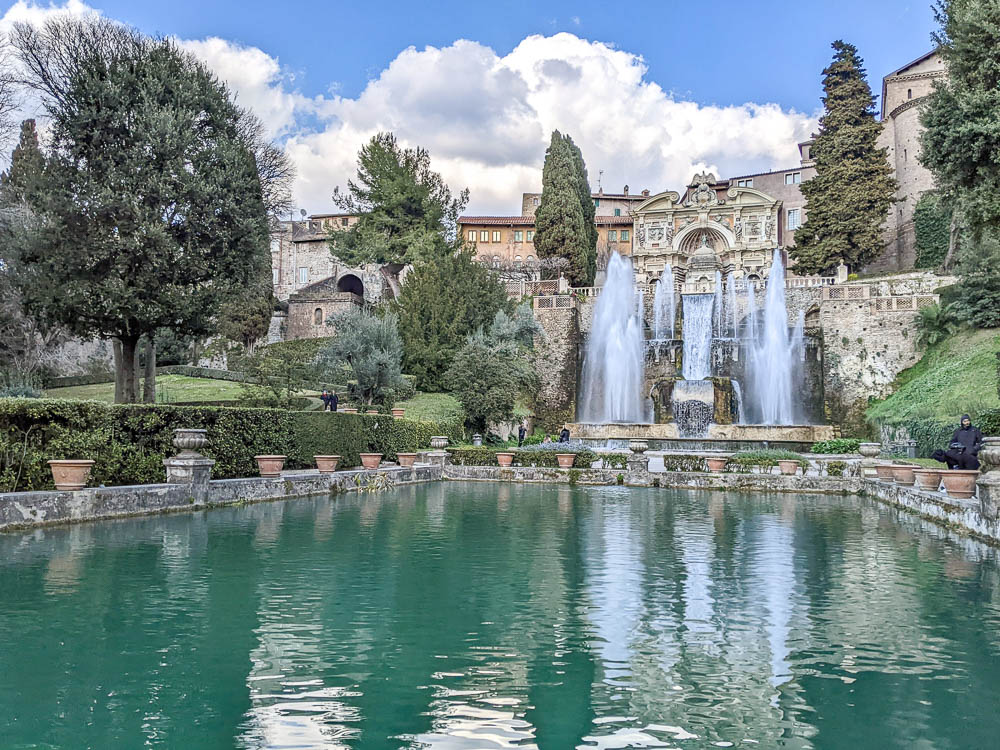
The many fountains of all shapes, sizes, and designs are the centerpiece here, and the nearby Aniene River was actually diverted to accommodate these goals.
Besides the gardens and fountains, you can tour the palace as well and get some of the absolute best views in Tivoli from all over the site. Plan to spend about 2 hours here checking it all out.
Check out Villa d’Este’s historical UNESCO information here, and get visiting information here.
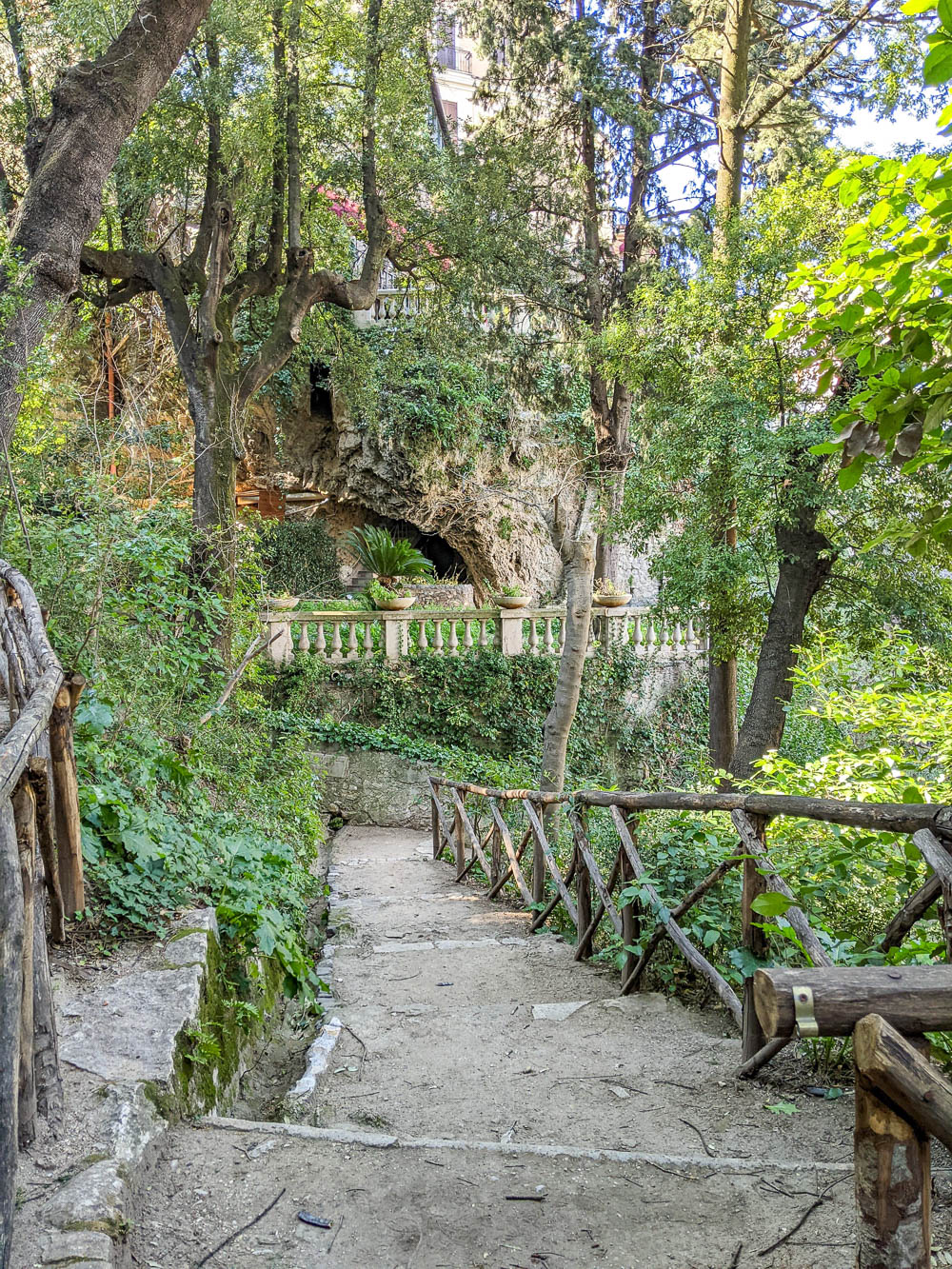
Parco Villa Gregoriana
The third of the three major sites you need to see on your 2 days in Tivoli is Villa Gregoriana—the most offbeat of them all. It’s also conveniently located in the center of Tivoli and is a super unique outdoor Italian adventure.
Villa Gregoriana is a complex made up of wooded walking paths, mysterious grottoes and caves, waterfalls, hidden passageways, and so much more stuff that is just out-there . Basically, you’ll feel like you took a left after the pizzeria and somehow wandered into a storybook fairy tale dreamland. But let me back up.
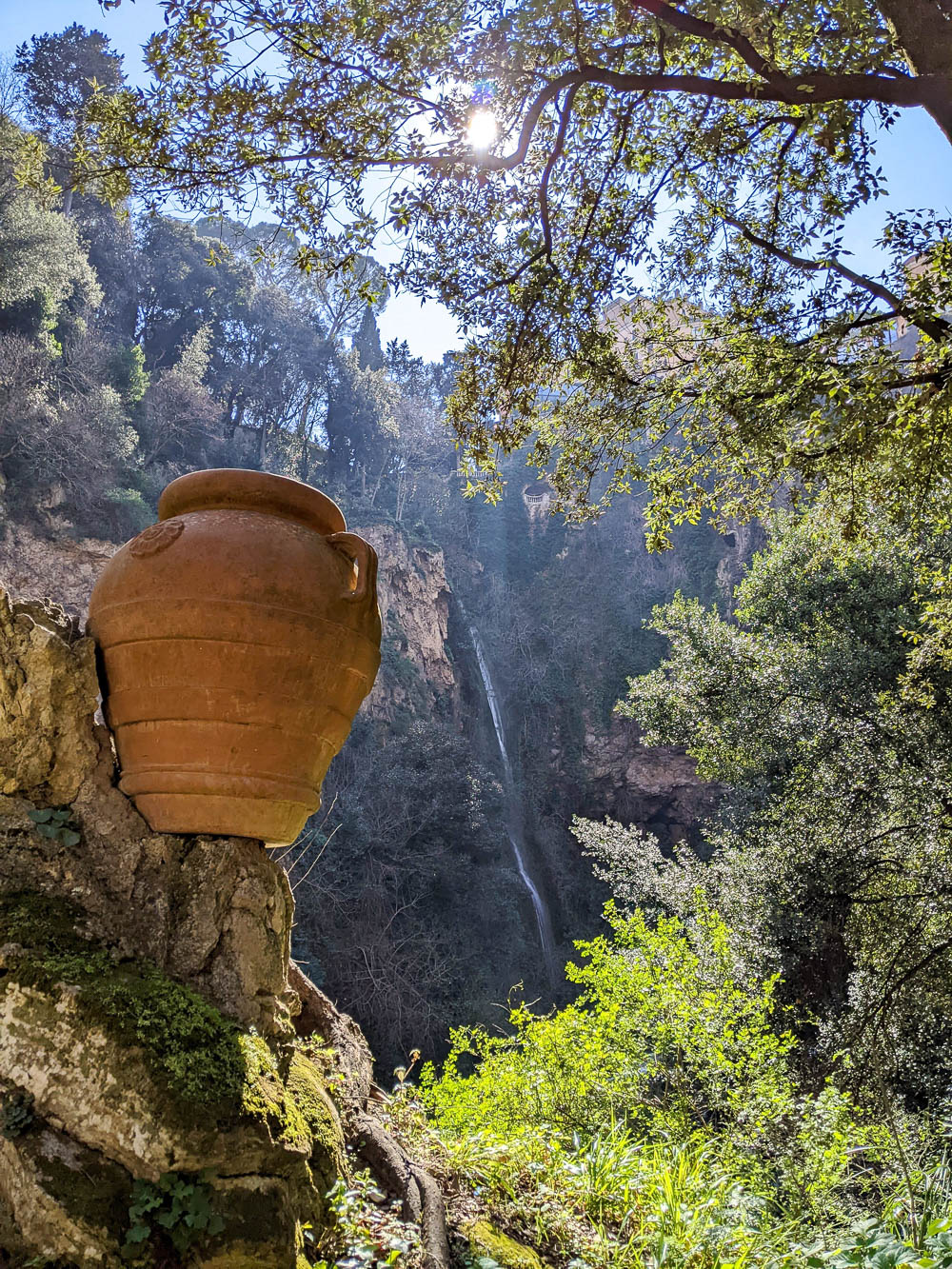
The aforementioned Aniene River used to be a real pain in the Pope and caused wild devastation many times due to its persistent flooding. Finally, in 1826 they had had it and finally resolved to come up with a permanent solution.
The cure was then to totally divert the river (again) and the now-empty river bed was turned into a giant urban park. They named it Villa Gregoriana after Pope Gregory XVI who commission the project, though it’s also called the Valley of Hell sometimes. Go figure.
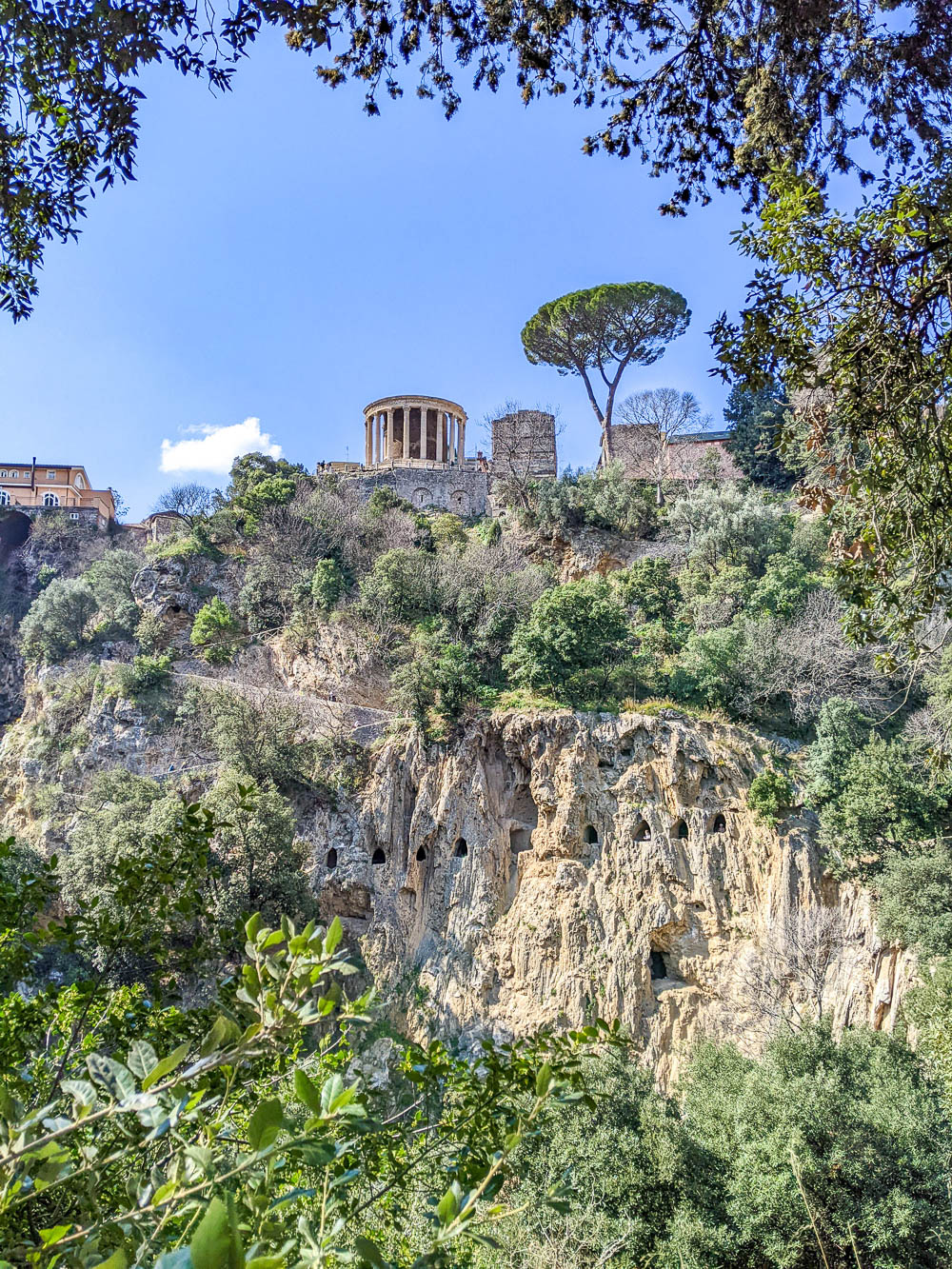
Its reconstruction took place over time but the site was eventually abandoned for the last half of the 20 th century. It has since been revamped but the years of neglect equated to uncontrolled growth of the vegetation which actually gives it a more enchanted feel today.
Visiting Villa Gregoriana
Villa Gregoriana is basically a 400-foot deep gorge in the middle of Tivoli. To explore it, you start at the top, hike all the way down to the bottom, then hike back up on the other side.
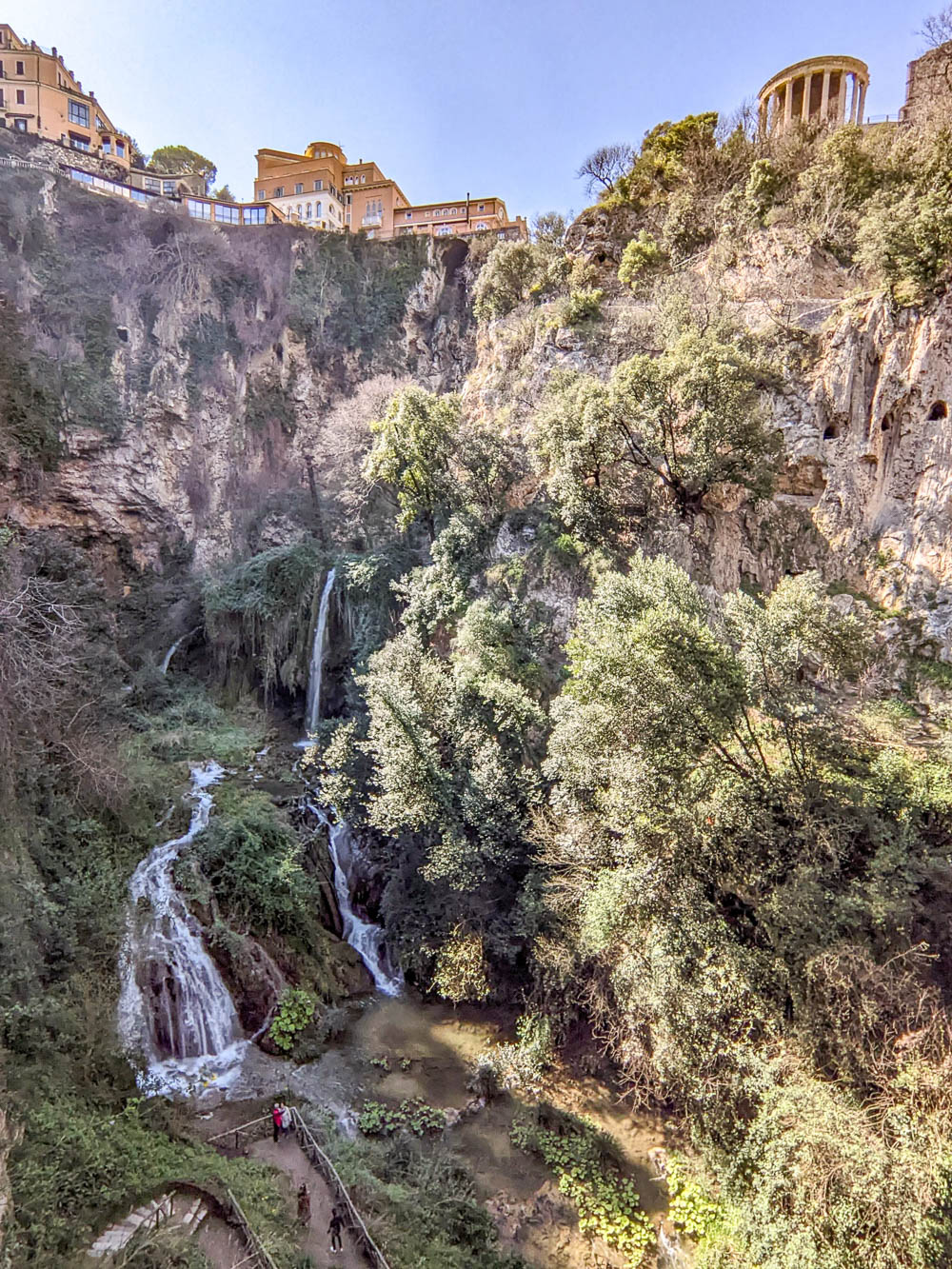
The paths are a mixture of natural dirt paths and some constructed walkways and staircases. It winds through the forest, past waterfalls, through caves, and more. On the opposite side of Villa Gregoriana are two temples that date back to the 2 nd century B.C. Depending on how often you stop to take photos (it’ll be a lot) and how many of the hidden grottoes you check out, plan for around 2 hours here.
Get Villa Gregoriana visiting information here.
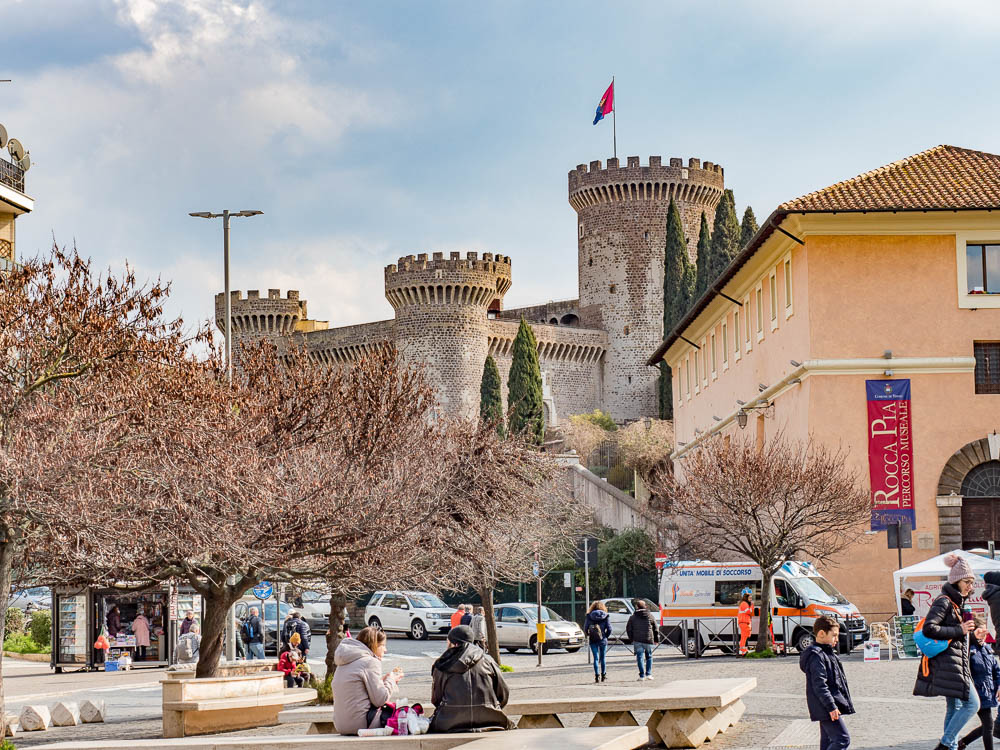
Rocca Pia is a medieval castle smack in the center of town, just next to the popular Plaza Garibaldi and around the corner from Villa d’Este. It dates back to the mid-1400s and was commissioned by Pope Pius II.
You can visit and tour the castle today, but note that it’s only open on Saturdays and Sundays! To get a better idea of what you can see, check out these Tripadvisor reviews .
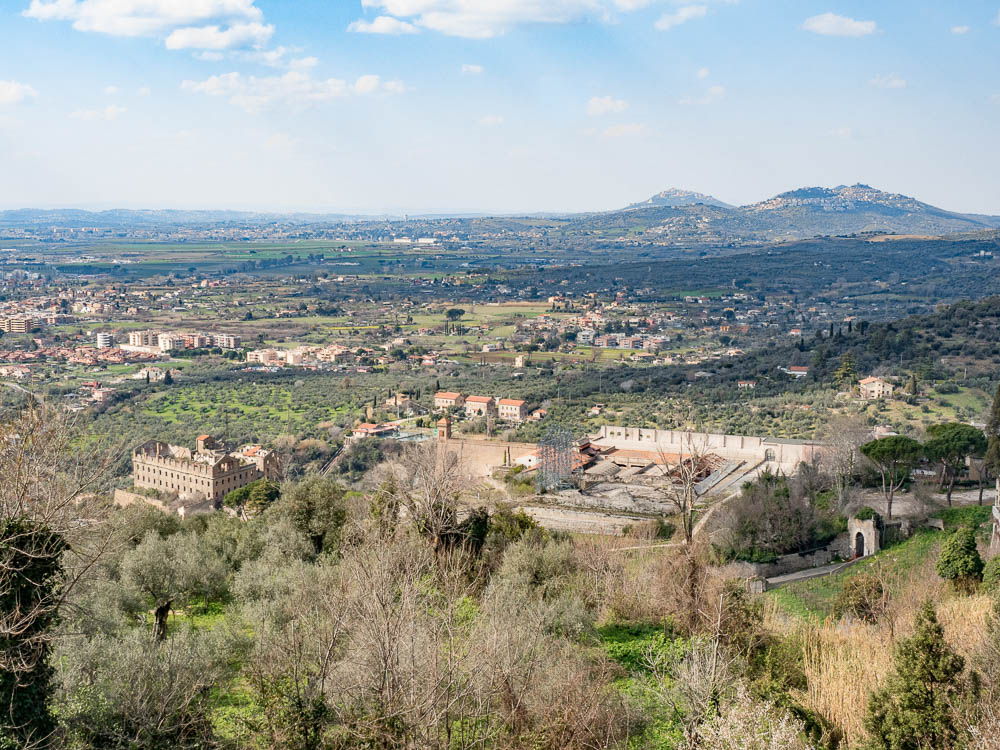
Sanctuary of Hercules Victor
The Sanctuary of Hercules Victor is another complex of Roman architecture and dates back to the 2 nd century B.C. This hillside complex consists of a giant amphitheater, a temple, and other cool ancient areas to explore. Get more historical and visiting information here.
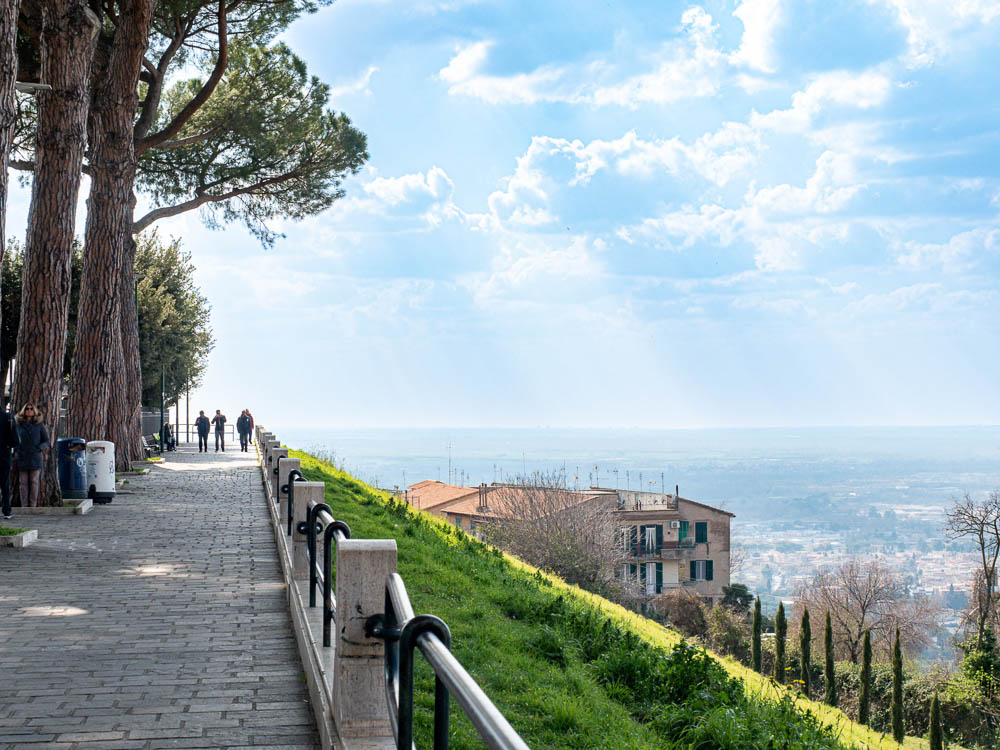
Is it worth visiting Tivoli, Italy?
Tivoli is absolutely worth a visit if you’re looking for something different and enchanting. Beyond these sites, Tivoli is simply an awesome city to just explore. While it does have a handful of world renowned UNESCO Heritage and other sites, it still has an off-the-beaten-path kinda vibe. Its tourism industry exists, but it’s small.
When you’re in Tivoli, you’ll very much feel like you’re among locals. Even the tourists you’ll encounter in the lines to the villas are Italian. Even though it’s so close and accessible from Rome, you really do feel a world away. Emperor Hadrian, I feel you.
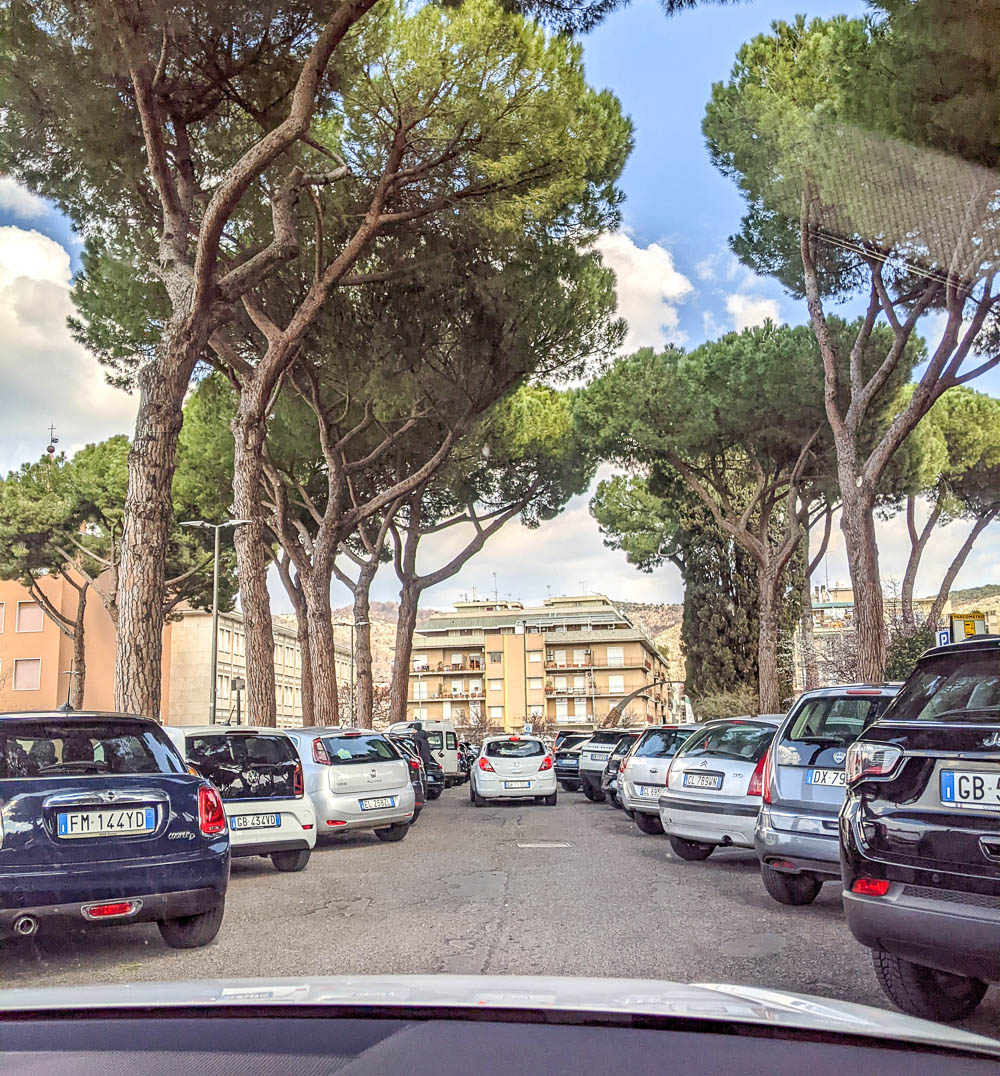
How to get to Tivoli, Italy
Unless you’re taking one of the organized tours that include transportation , here’s how you can easily get to Tivoli from a few different destinations:
How to get to Tivoli by car
From the center of Rome, Tivoli is just a 45-minute drive. (But it’s easily accessible from all over Italy.) Once there, we parked in the lot next to Piazza Giuseppe Garibaldi, right in the center, as a parking pass there was included with our hotel stay. I’ll spare you detailed directions as we all know how to use GPS at this point.
On a side note, traveling Italy by car is so much fun! It’s definitely my preferred way to move up and down the boot. If you think you’d like to do it this way too, check out the deals at rentalcars.com and see if this would work for you!
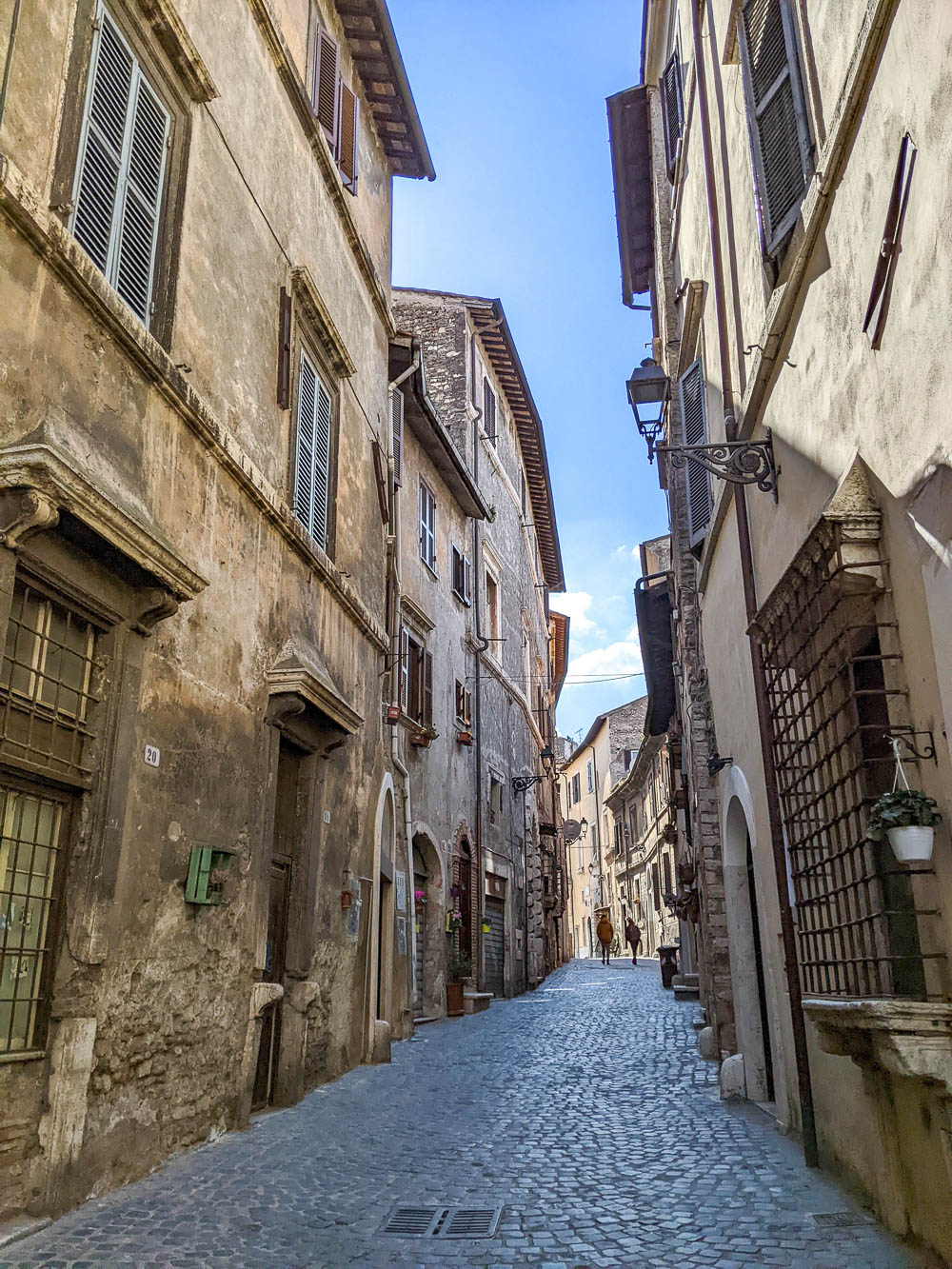

How to get to Tivoli by train
If you’re taking the train to Tivoli from Rome, the trip can take anywhere from 35 minutes to an hour and a half, depending on which train you take. The fastest (35 minutes) is direct, while some others have changes. I don’t know why on earth you would ever choose one of those, but there they are.
Check out TrenItalia for schedules and tickets. Put in Roma Termini as your “From” and Tivoli as your “To.” These train tickets are also around €3. Bellissimo!
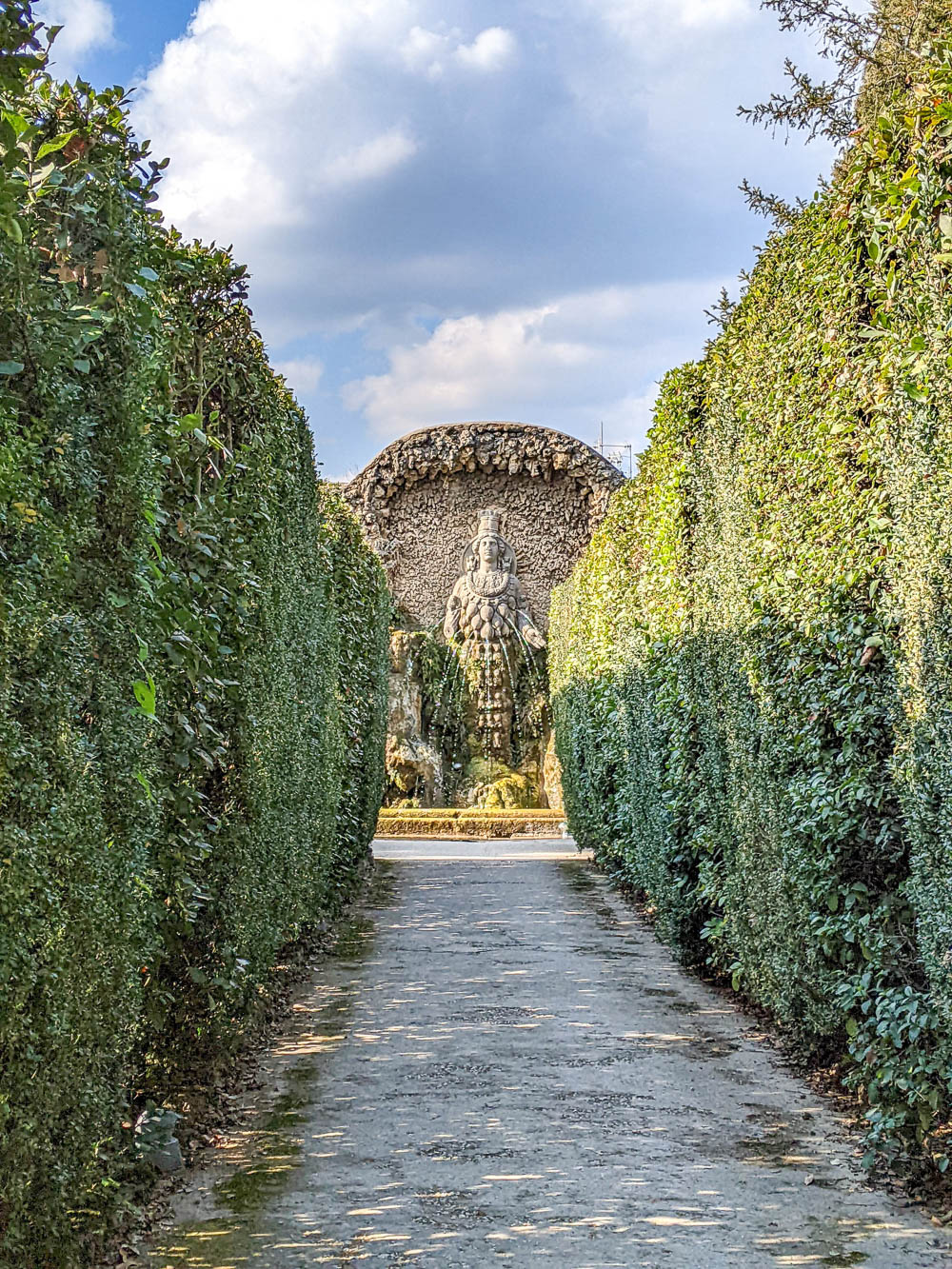
That being said, you can also train it to Tivoli from other locations in Italy. If you’re coming from Florence ( Firenze SM Novella ), you will have to change trains in Rome, but that will be your only change. The trip will take anywhere from 2 hours 45 minutes to 6 hours. (Please choose the short one, I mean really.)
If you’re coming up from Naples ( Napoli Centrale ) or the Amalfi Coast ( Salerno ) , the trip will take between 2.5 and 4 hours. And, again, you’ll have to change trains in Rome.
Those trains get you into Tivoli’s main train station. BUT, if you check out the TrenItalia website, you’ll see that you can actually put Villa Adriana or Villa d’Este in as your destination.
In that case, your ticket will take you to the nearest train station, and will also include a ticket for the bus that will take you to the Villas themselves. Depending on your plans, this could save you a great deal of time!
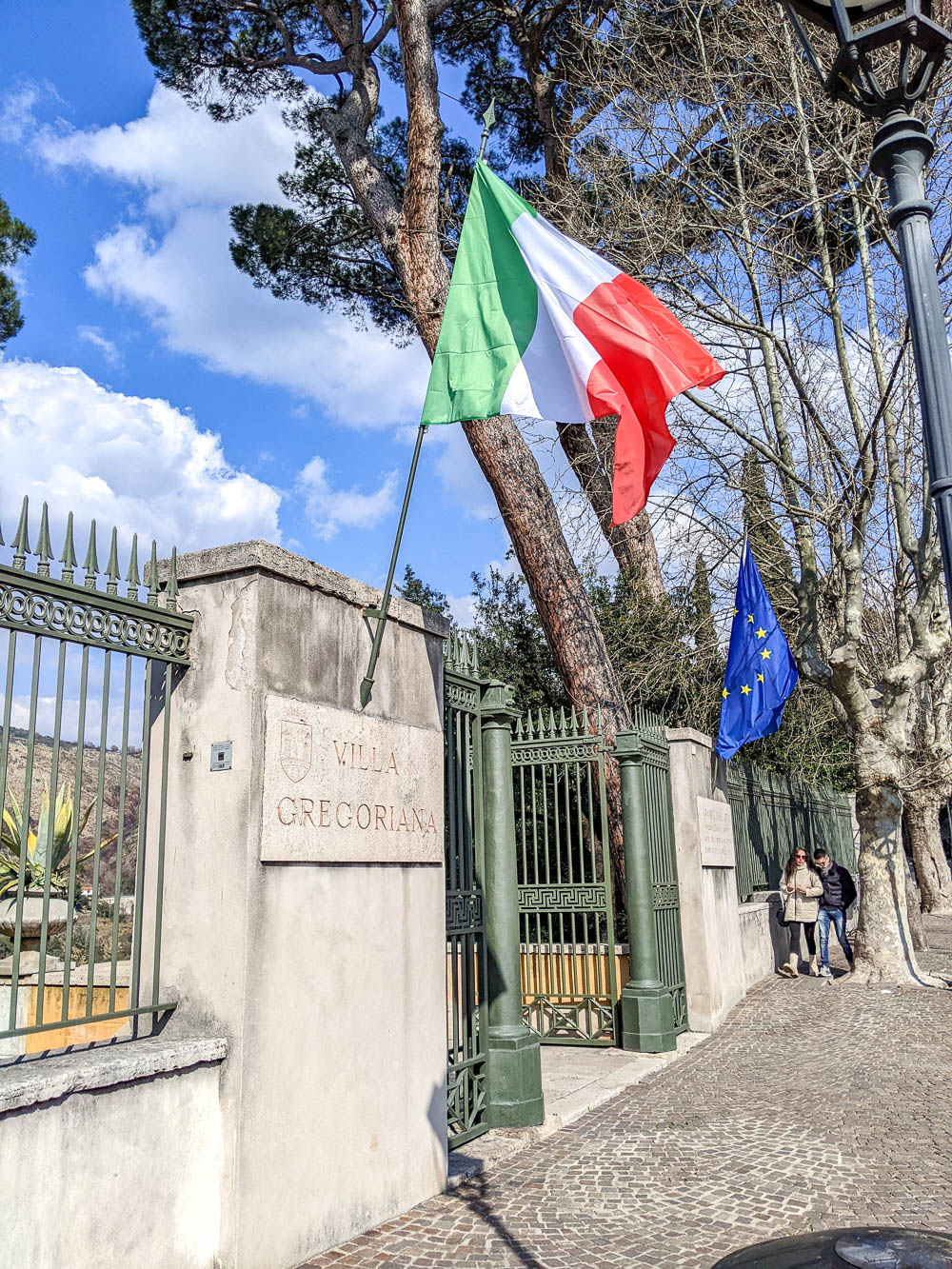
Getting around in Tivoli
If you have your own rental car, getting around Tivoli is going to be a cinch. Park wherever your accommodation tells you to, and you can walk to a great deal of places from within Tivoli’s center. (If you stay at the places I suggest below, Villa d’Este is right outside your front door, and Parco Villa Gregoriana is just a 9-minute walk.)
The one site you’ll actually need to drive to is Villa Adriana, a 10-minute drive away from Villa d’Este. But, Hadrian’s Villa has a big private parking lot, so that’s one less thing to worry about.
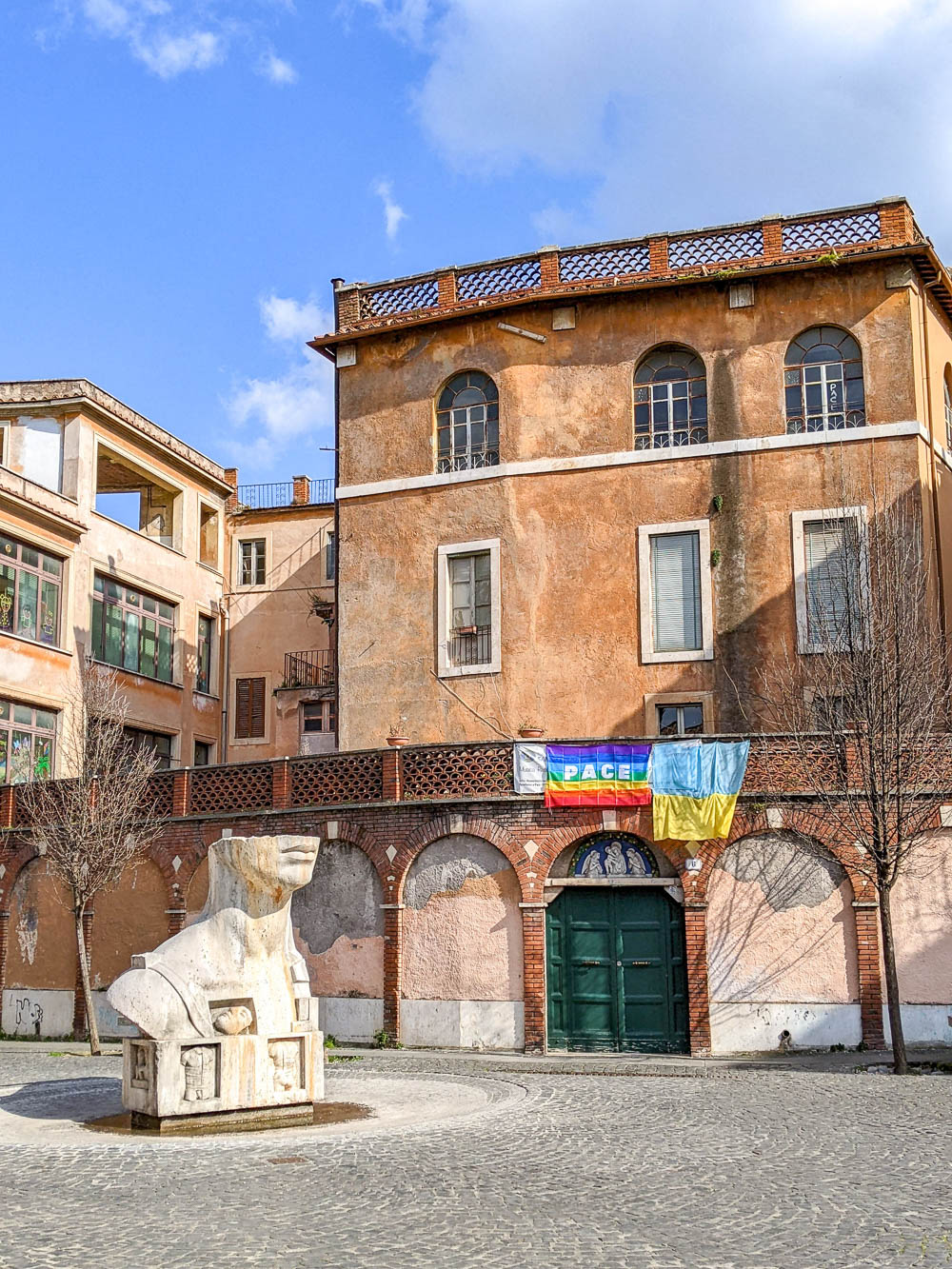
Tivoli’s Cat Bus
Otherwise, Tivoli has the Cat Bus. Yes, the Cat Bus. (Specifically, the Cooperativa Autoservizi Tiburtini, but whatever.) This is the public bus system that runs through Tivoli and will take you where you want to go. Get all the information and routes here: https://www.catbustivoli.com/ . It even shows you which buses to take to get to the main attractions.
Where to stay in Tivoli, Italy
For your 2 days in Tivoli, I cannot recommend the B&B Villa d’Este enough . This place is so perfect and I would not hesitate to stay here again. The welcome was so warm and the location could not be more perfect. The rates are great, parking is included, and the rooms (and showers) are big. Read reviews here .
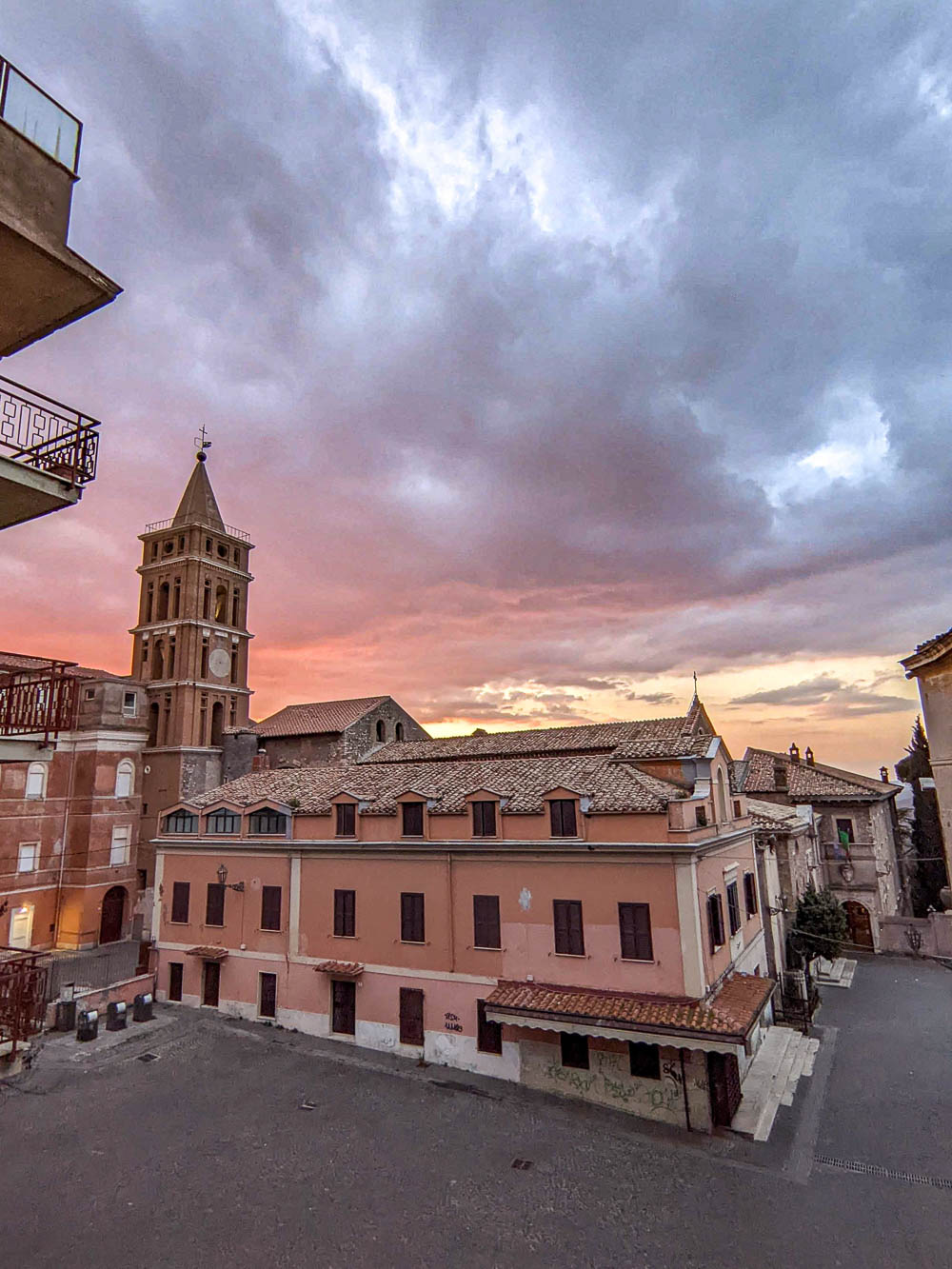
B&B Villa d’Este is located, I kid you not, right outside the front door of the Villa d’Este. I thought the reviews were joking when they said the location was ideal, but they were not. It’s right across from Piazza Garibaldi where you can park for free. It’s within walking distance of just about everything. And our room views were just *chef’s kiss*.
The room was bigger than (Italian) normal and the shower was more high-tech than I thought existed in Italy. The owners are so delightful and didn’t hesitate to accommodate me when I texted them for utensils so I could eat my beans out of the can. (I have a thing for Italian canned tuna + beans. I’m happy to talk more about that if you’d like more information.)
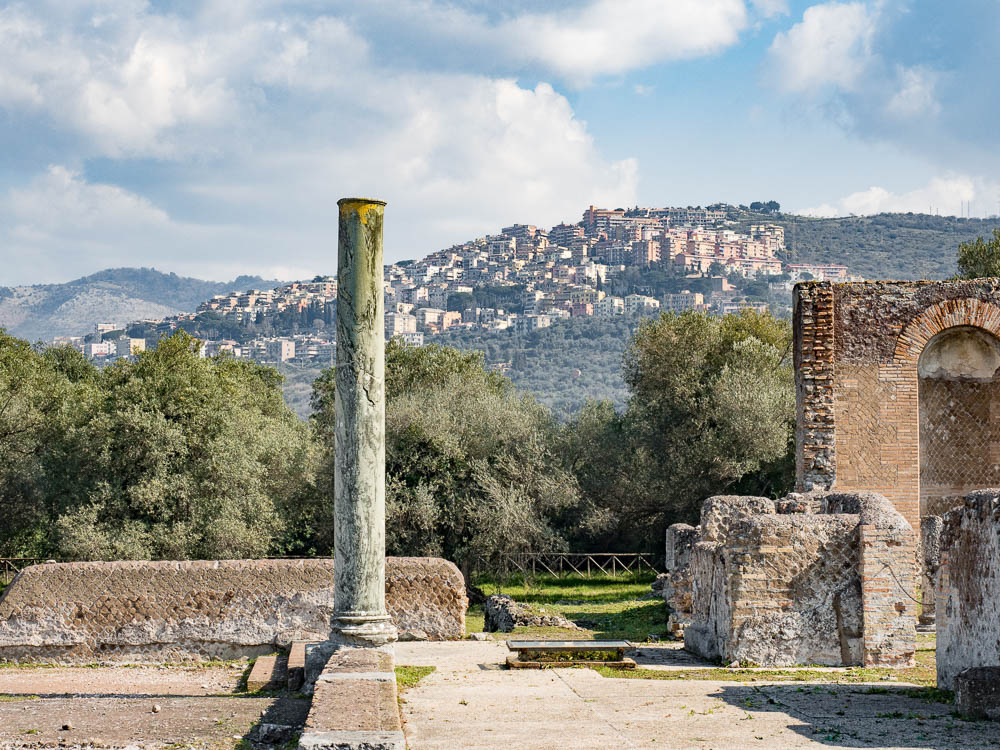
Besides B&B Villa d’Este, check out these other nearby options in case they work better for you:
- B&B Il Castello – Also right near the Villa d’Este and the Rocca Pia. It has great reviews (9.2 on Booking.com!) and excellent rates.
- Dimora D’Este – At Dimora D’Este you get the whole 2-bedroom apartment with full kitchen and, yes, it’s also in the perfect location. Also exceptional reviews (9.7/10!) and a really cute space.
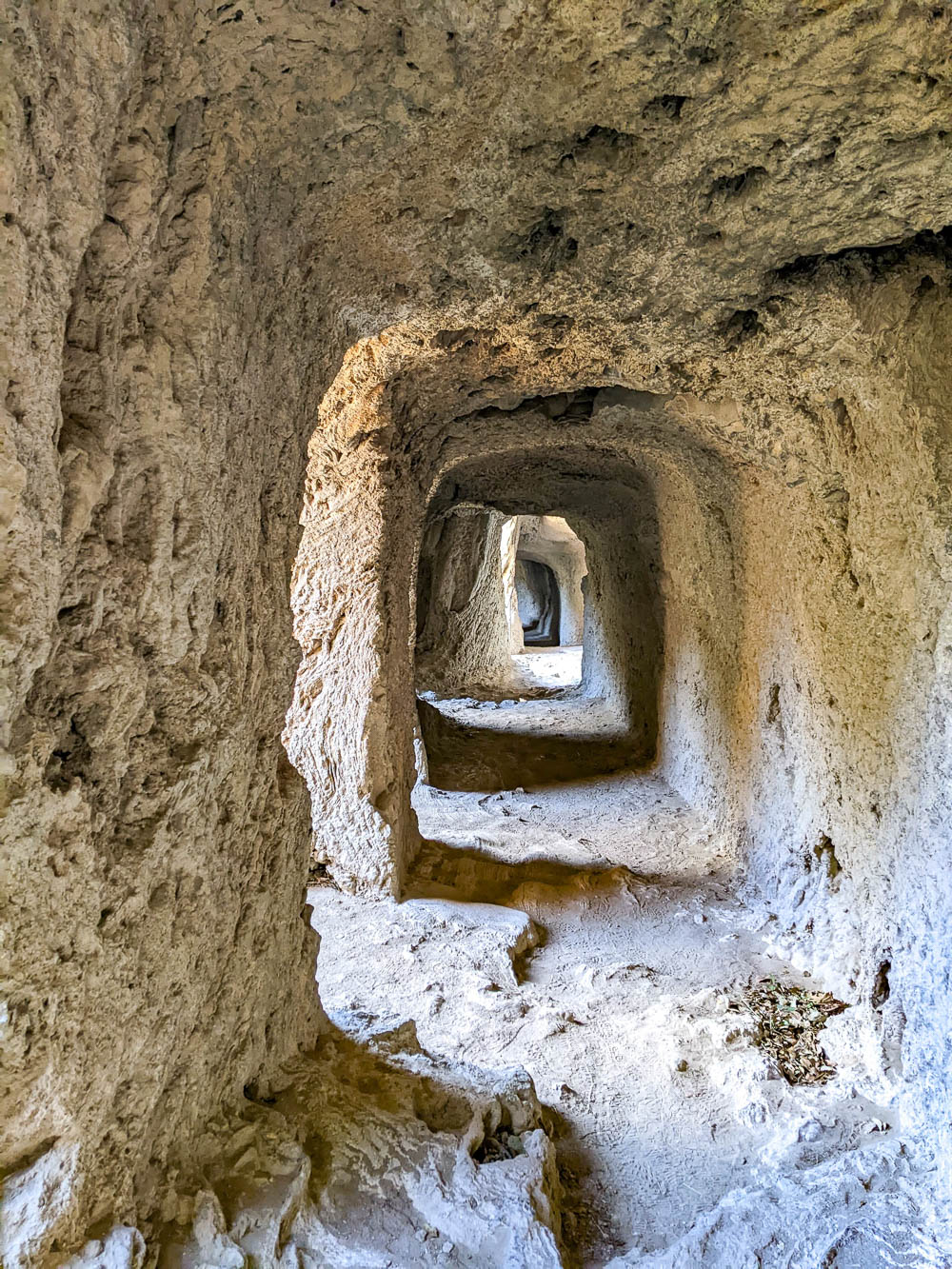
What to pack for your 2 days in Tivoli
While most of what you need in Tivoli is the standard stuff you’d pack for any trip to Italy, there are a few things I want to emphasize. Here’s what you’ll need during your 2-day trip to Tivoli:
Sturdy shoes for the villas
All three of Tivoli’s famous villas are going to require some heavy duty shoes. At Villa d’Este you can get by with probably anything you’re wearing as it’s mostly paved paths. But for Villa Adriana and Villa Gregoriana you’ll want something that can pull more weight.
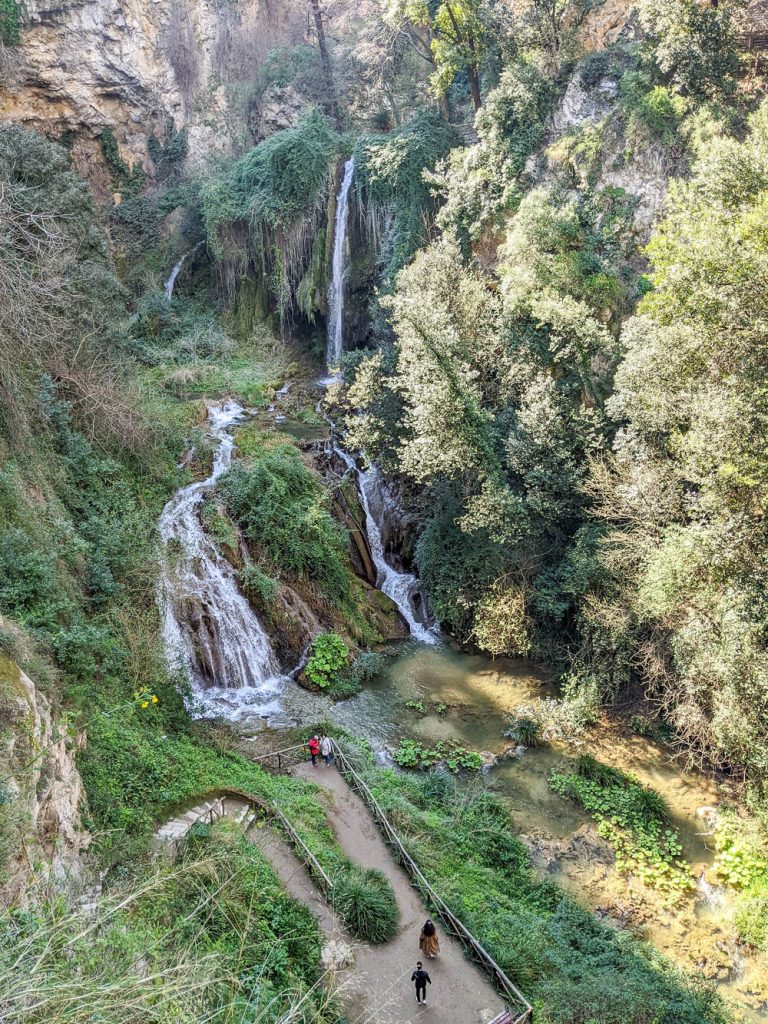
Both Hadrian’s Villa and Parco Villa Gregoriana are mostly dirt, gravel, rock, uneven, grassy, wet paths that go uphill, downhill, over bridges, into wet caves, and more. For your visit to Tivoli, make sure you have something sturdier than fancy sandals or casual sneakers.
My personal recommendations are:
- Sorel duck boots for chillier seasons – check them out here on Zappos and Amazon
- Chacos hiking sandals for summer – check them out here on Zappos and Amazon
I am obsessed with both of these and wear them anytime I’m doing something that’s a little on the Italian outdoor adventure side of things. Both have excellent traction for wet and uneven surfaces, both are waterproof, and both are comfortable as heck even for wearing all day while touring ancient Italian cities.
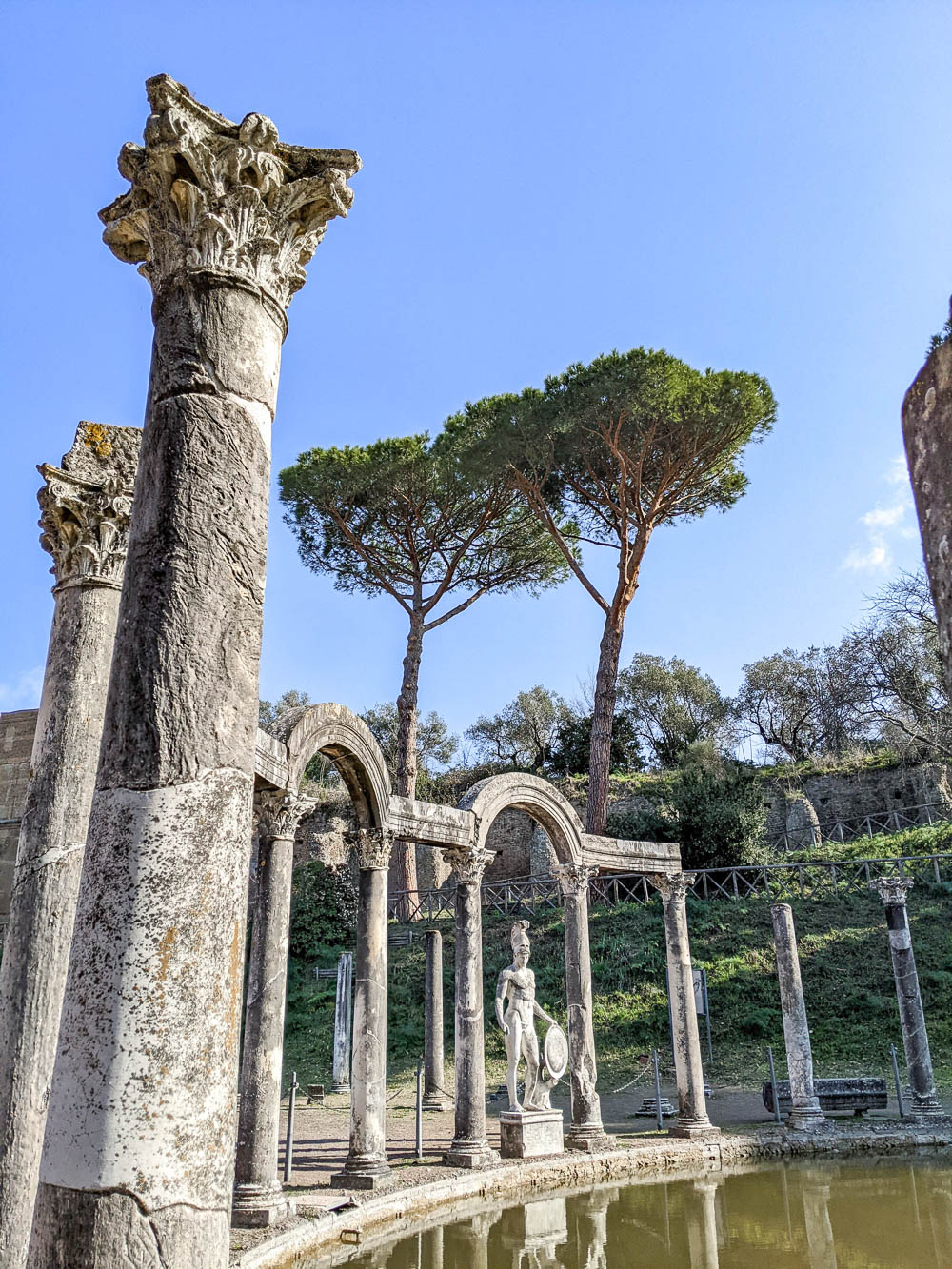
Other items to consider
- Culture Smart! Italy – I preach these pocket-sized guidebooks for just about every international destination. They focus on the customs and culture of each country and clue you in to the things traditional guidebooks skip. Highly recommend. (I have a whole review post on these books if you’d like to learn more!)
- European outlet adapters – This is such an easy thing to forget about but 1000% essential to your trip. Go ahead and pick up a 6-pack of them so you won’t have any trouble charging all your devices.
- Anti-Theft purse – Not that Tivoli is unsafe or anything, this is just a smart thing to have for any European/Italian trip. I don’t go anywhere without my theftproof purse/backpack/camera bag/etc. They come in all different sizes and styles. I have some from both PacSafe and Travelon and I love them all! Currently, I never leave home without this Anti-theft Slim Backpack .
- Refillable water bottle – Tivoli (and all over Italy) is full of nasoni, the free, fresh water sources. Be sure to always have a refillable water bottle with you so you never have to pay for bottles of water.
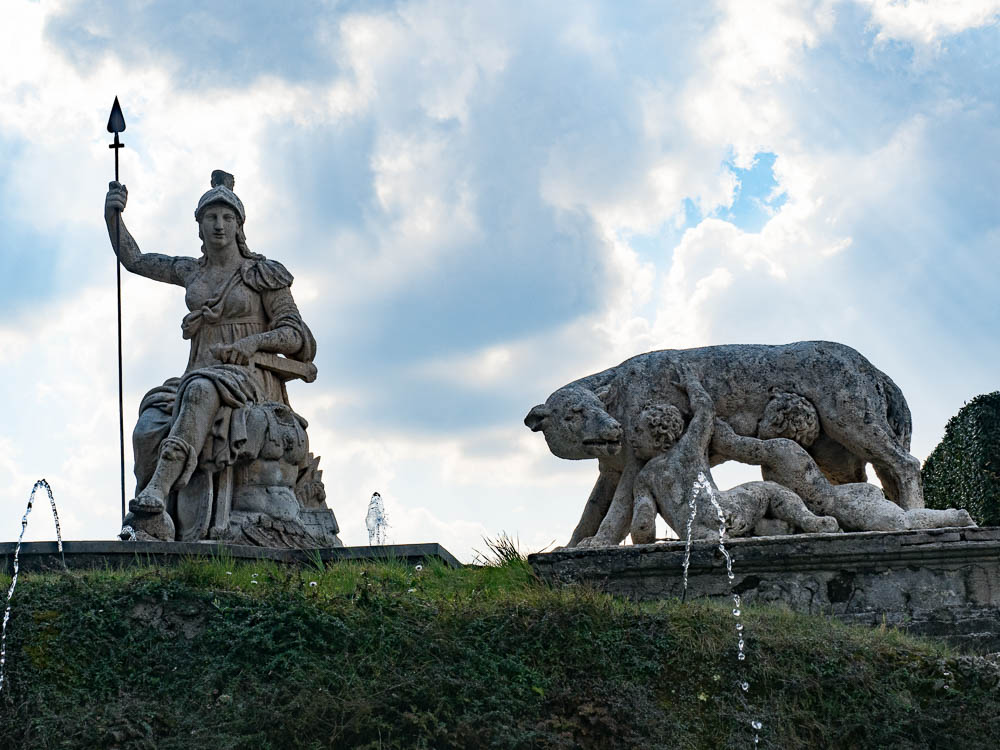
Have a great time on your 2 days in Tivoli!
Save this info, pin this image:
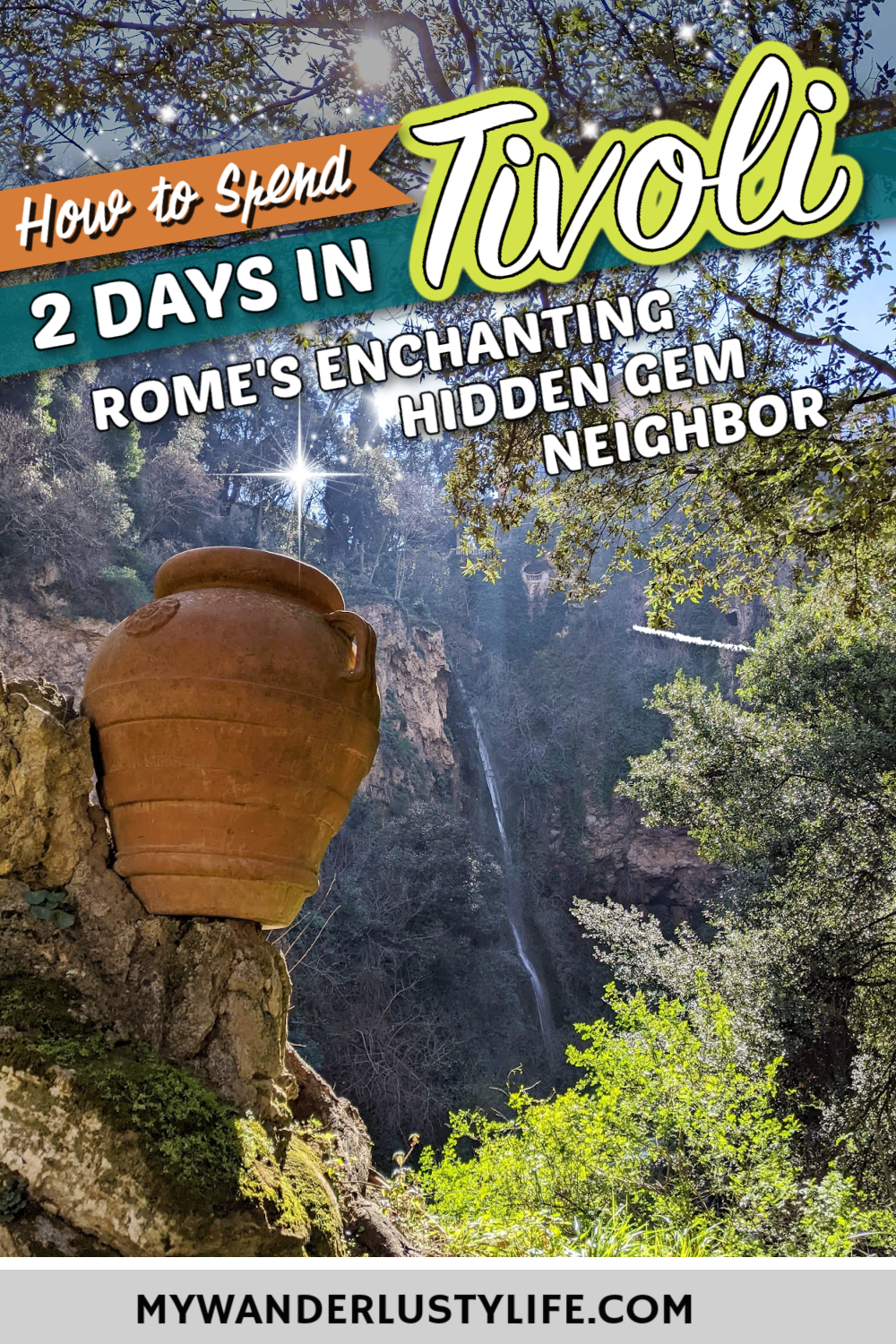
Subscribe to MWL
About Ashley Smith
Ashley is a historian and Oktoberfest expert & tour guide. She has traveled to 39 countries and specializes in quick trips throughout Europe and the Americas that prioritize hiking adventures, museums of all kinds, cultural experiences, and jam-packed itineraries. She hails from Memphis, TN and currently lives in Boston with her husband and two feline sidekicks.

Get my 2024 Oktoberfest Party Planning Checklist here!

Free 2024 Oktoberfest Packing Checklist

Get my 2023 Oktoberfest Packing List here!

Want more Oktoberfest ?

Belize Packing List
Iceland packing list, get my 2024 hotel booking checklist here.

TMB Packing List 2024
Morocco packing list 2024, 2024 oahu bucket list.

Home » Travel Guides » Italy » 15 Best Things to Do in Tivoli (Italy)
15 Best Things to Do in Tivoli (Italy)
Tivoli is a commune of the greater metropolitan area of Rome in the region of Lazio. Despite its small size and close proximity to the eternal city, Tivoli actually has a great range of fantastic attractions and sites and is a great place to visit. This commune was founded in Roman times and was an important settlement during the reign of Emperor Hadrian due to its strategic location on the River Aniene. During the Middle Ages, Tivoli came under the control of the Papal States and was fortified with a defensive network and city walls. At the time of the Renaissance, the magnificent Villa d’Este was constructed and the commune continued to prosper. Today, Tivoli has an economy based on its travertine quarries and tourism.
In terms of attractions, Tivoli has a superb selection of historical architecture such as the Rocca Pia, Villa d’Este and the San Lorenzo Cathedral. Furthermore, the commune benefits from a series of magnificent waterfalls, an ancient Roman Amphitheatre and a series of high-quality restaurants and bars. Due to its close proximity to Rome, Tivoli is a great location to take a day trip, or to be used as a base for exploring Lazio.
Let’s have a look at the best things to do in Tivoli :
1. Villa Adriana

Many people do not know, but to the immediate west of Tivoli you can find an immense complex that was created for the Roman Emperor Hadrian.
Covering an area of 120 hectares, this magnificent complex contains a myriad of well-preserved structures and offers superb insight into ancient Rome.
The Emperor used this villa as a retreat from Rome during the 2nd century AD and Tivoli was chosen due to its picturesque landscape.
Today you can find many beautiful buildings still standing such as the Grandi Terme, the Quadriportico, the Teatro Marittimo and the Piazza d’Oro.
Furthermore there is also a plethora of artefacts from the site such as mosaics, pottery and ceramics.
When visiting Tivoli, visiting the Villa Adriana is an absolute must!
2. Villa d’Este Gardens

These gardens are possibly the best known in Italy and represent the pinnacle of Italian landscape garden design.
Located in the western part of the town centre near the Duomo, the gardens are expansive and you could easily spend hours exploring the various different segmented areas.
Within the gardens you can find several beautiful fountains including the monumental Fontana di Nettuno, the Fontana di Tivoli and Le Centro Fontane – each fountain is adorned with sculptures and ornate decoration.
Additionally there is a series of landscaped gardens full of plants, trees and greenery.
This is a truly magical place to walk through and combined with the Villa d’Este Palace, is one of the top sites in Tivoli.
3. Villa d’Este Palace

The Villa d’Este was created during the 16th century under the instruction of Cardinal Ippolito d’Este.
Due to its location, the villa offers sublime views of the surrounding landscape and the gorgeous Villa d’Este Gardens.
Within the villa itself you can find a number of different rooms that have been restored and maintained in their original condition.
The detail and decoration found within these rooms is spectacular.
Notable rooms include The Hall of the Hunt, the Hall of Glory, the Hall of Noah and the First Tribune Hall.
Each room is practically covered with beautiful artworks and as you pass through each hall, you are presented with a myriad of different stories and legends and depicted in great detail and colour.
4. Via delle Cascatelle

This walkway passes through some gorgeous parkland and allows visitors to see the magnificent waterfalls that cascade in the northern part of Tivoli.
If you walk from the Villa Gregoriana and towards the Via Quintilio Varo you can see the waterfalls and the town of Tivoli.
The path winds through some beautiful woods and is a pleasant place to hike during fine weather.
If you want to view the waterfalls from the top, there is a small path from Via Quintilio Varo – this path heads to the edge of the falls and from here you can see the cascades of water and hear the thunderous noise of the water.
5. Rocca Pia

The Rocca Pia is an ancient medieval fortress that was built during the 15th century.
This beautiful structure was constructed during the conflicts of the Guelph’s and Ghibellines and was built to strengthen the defense of Tivoli.
What makes this structure so intriguing is its fantastic symmetrical design and the fact that it stands in such good condition despite being over 500 years old.
Four crenulated guard towers surround the keep and the towers and ramparts both feature an arched under design.
Although entry is not permitted inside the Rocca Pia, this is still an important building in the heart of Tivoli.
6. Tivoli Cathedral

The Cathedral of Tivoli is the main religious building in the town and is also known as the Duomo of San Lorenzo Martire.
The structure that currently stands in Tivoli was constructed in the 12th century in a Romanesque style.
Although the exterior is quite plain, there is a large bell tower and the white washed walls have various inscriptions.
Inside the cathedral however is a different story – the main aisle contains some absolutely stunning decoration on the ceilings, arches and main altar.
Throughout the interior you can see a myriad of different paintings and frescos, and practically every part of the building contains some ornate decoration.
7. Villa Gregoriana

This romantic complex is nestled within the valley of the Aniene River and is a great place to walk through in the eastern part of Tivoli.
Commissioned by Pope Gregory XVI in the 19th century, the villa has a series of beautiful gardens, grottos and paths that wind through the landscape.
Notable features include the Siren’s Grotto, the Grotto of Neptune and of course the Grande Cascata – you can see this waterfall from the villa in all its glory, and the man-made passageways that directed its flow.
When visiting Tivoli, consider spending time exploring this villa and the surrounding natural area.
8. Chiesa di Sant’Andrea

This understated church is often overlooked in favour of Tivoli cathedral however it has some amazing decoration in its own right and is a true hidden gem.
If you head down from the Via Ponte Gregoriano towards the Via dei Sosii, you will eventually find the church on the Via Sant Andrea.
The exterior is quite underwhelming and features several marble statues and Latin inscriptions but the real treat is inside.
When entering the church you would not expect such opulent decoration – the ceiling is particularly interesting as it has a checkerboard design with many golden reliefs.
Furthermore, the marble columns of the main aisle have a beautiful swirl pattern, and the main altar is embellished with colourful frescos – don’t miss out on this little known treasure!
9. Tempio di Vesta

The Temple of Vesta commands a domineering position on the western arm of the Aniene valley and provides superb views across to the Villa Gregoriano and the Tivoli waterfalls.
Two temples actually sit in close proximity to each other – the Tempio di Vesta and the Temple of Sibilla; both are remnants of the cities Roman past.
The Temple of Vesta features a beautiful circular design with many grand columns, whilst the Temple of Sibilla now stands as a simple square structure.
At night the columns are lit up and the effect is highly impressive.
There is even a restaurant next to the Tempio di Vesta which provides outdoor seating next to this magnificent structure.
10. Bleso Amphitheatre

As mentioned previously, Tivoli has an ancient history that spans back to the Roman era – Emperor Hadrian once lived here.
Many structures remain from this time period and one such relic is the Roman Amphitheatre.
This fantastic building has only recently been re-opened to the public but it is now possible to walk through the remains and see what stands of this once glorious theatre.
Located conveniently next to the Rocca Pia and the Piazza Giuseppe Garibaldi, the Amphitheatre is easily accessible and a great place to visit whilst walking through the centre of Tivoli – you can still see the original oval shape of the building together with some of the columns and walls.
11. Piazza Giuseppe Garibaldi

In the southern part of the town centre of Tivoli you can find the immense Piazza Giuseppe Garibaldi.
This square is a central point in the town and features some beautiful architecture including the Church of Santa Maria Maggiore and a large modernist sculptured arch that spans two pools in the centre of the Piazza.
Furthermore, to the southern end of the square you can find a beautiful garden and the Panoramica Di Tivoli – this viewing point looks out onto the surrounding countryside and sunsets here are absolutely breath-taking.
12. Enjoy a meal at the Ristorante Osteria la Briciola

Tivoli has a variety of first class restaurants and the Ristorante Osteria la Briciola is one of the top rated in the area.
This fine establishment is actually located just outside of the city in the small village of Bivio San Polo on the slopes of Monte Catillo.
Here you can enjoy a myriad of beautifully created and presented dishes including seafood and traditional Italian pasta.
Furthermore their dessert section is to die for and each selection tastes divine and looks stunning.
Many people comment on the restaurants attention to detail, the friendly nature of the staff and the beautiful setting.
13. Take a day trip to Rome

When stopping in Tivoli, you simply cannot pass up the chance to visit Rome.
Tivoli is literally 20km to the east of central Rome and has great transport links to the Eternal City.
Rome is renowned worldwide for its fantastic array of ancient architecture and gorgeous historical buildings.
Notable sites include the Colosseum, St. Peter’s Square, St. Peter’s Basilica, The Vatican, The Sistine Chapel, the Trevi Fountain and the Pantheon.
This is just the beginning and Rome has so much more to offer than these well-known attractions.
Tivoli is a great base from which to explore Rome and travel into the centre.
14. Enjoy a drink at Flo’s cafe and bistro

Flo’s cafe and bistro is located on the Via Ponte Gregoriano; only a short walk from the magnificent waterfalls of Tivoli.
This establishment is a fantastic place to enjoy a quiet drink, but you can also tuck in to a hearty meal or a coffee.
The décor is upmarket and the ambience of the bistro bar is pleasant and inviting – if you can get an outside table you are granted with views of the Temple of Sibylla.
For those who enjoy a drink or two, you can choose from a range of craft beers, wines and spirits including many from the local area.
15. Riserva Naturale Monte Catillo

To the immediate north east of Tivoli you can find the Monte Catillo natural reserve.
This reserve is centred on Monte Catillo and has been designated a protected area since 1997. The reserve is mainly covered with luscious forest and it is possible to hike through this beautiful region and even climb to the summit of the mountain.
At the top of Monte Catillo there is a large steel cross that can be seen for miles around.
When hiking through the park you are presented with fantastic views of the surrounding landscape and it is even possible to see the waterfalls at Tivoli.
15 Best Things to Do in Tivoli (Italy):
- Villa Adriana
- Villa d’Este Gardens
- Villa d’Este Palace
- Via delle Cascatelle
- Tivoli Cathedral
- Villa Gregoriana
- Chiesa di Sant’Andrea
- Tempio di Vesta
- Bleso Amphitheatre
- Piazza Giuseppe Garibaldi
- Enjoy a meal at the Ristorante Osteria la Briciola
- Take a day trip to Rome
- Enjoy a drink at Flo’s cafe and bistro
- Riserva Naturale Monte Catillo

Day Trip from Rome: Tivoli
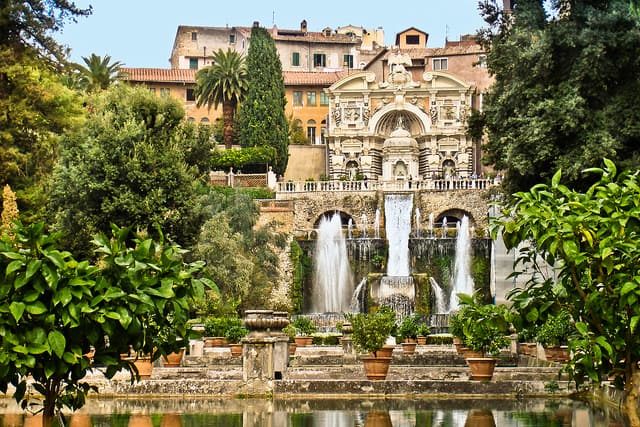
Discover the Thermae, the Villas, the monuments in Tivoli
When visiting Rome a day trip to the surrounding towns and regions is a must. One such place that is well worth a slice of your travel time is Tivoli . Tivoli is a pristine mountain town shrouded in native bush, cascading waterfalls, exquisite gardens and historical sites.
Sitting in the Monti Tiburtini hills on the Aniene River, Tivoli enjoys a cooler climate and has been a resort town for Rome’s elite for centuries. With its fair share of historical sites to visit, breathtaking views over the valley and Roman Campagna , world class cuisine and luxury hotels, a day trip from Rome to Tivoli will make anyone a very happy traveller.
The main attractions in Tivoli are its historical villas and parks. Each one is a UNESCO World Heritage Site and offers its own unique glimpse of history. Nestled atop a terraced hillside in Tivoli , Villa D’Este is most famous for its magnificent fountains, waterfalls and beautifully maintained gardens.
Villa Adriana is a small trip out of Tivoli, but easily reached by public transport. Described as more of a small town rather than a villa, a visit to Villa Adriana walks you through ancient Roman ruins of marble pillars and building footprints, including the main palace ruins. Note that it can be quite physically exerting visiting this villa site, especially in the hot summer months. Click here to get Villa D’Este and Villa Adriana private tour from Rome .
Finally one cannot see Tivoli without walking through Parco Villa Gregoriana , a park commissioned by the Pope in 1835 in an effort to rebuild the Aniene River bed after a devastating flood. The result is an expansive park abounding with greenery, manicured gardens, caves and cascading waterfalls.

How to Get There
It’s best to travel to Tivoli by train from Rome, which takes a short 1 hour trip for under £3. Tickets can be booked directly at the train station.
CLICK HERE TO BUY YOUR TRAIN TICKET
CLICK HERE TO RENT A CAR
Where to Eat
But the historical villas are only part of the experience. If you’re looking to dine on arguably some of the best Italian cuisine you’ve ever tasted, then the restaurants of Tivoli are set to please. Established in 1720, Ristorante Sibilla Di La Mura Luigia is over 300 years old. Having been around for this long this restaurant knows good food and service and it does both impeccably well.The cuisine is authentic and flawless. Produce is both local and seasonal (our favorite is their ravioli). What’s more, the view here looks up at the two historical Roman villas and reaches out to surrounding waterfalls. Another great food option is Osteria la Briciola , a spot where you will find many locals dining. A small excursion out of Tivoli, 7 minutes by car, the restaurant happily arranges transportation if needed. The staff here are so good they’re worth congratulating and the traditional Italian cuisine is divine. Try the set menu option or the seafood and meat tastings.
Address: Via della Sibilla, 50, Tivoli RM, Italy
Phone: 0774 335281
Website: ristorantesibilla.com
Where to Stay
If you decide to stay overnight, booking accommodation in Tivoli is easy. We recommend using booking.com for the best deals. Victoria Terme Hotel is a top option. Located within Le Terme Di Roma spa park you’ll get to enjoy spa life on your stay. Or also try Hotel Torre Sant’Angelo where you’ll literally be staying in a medieval castle on the Tivoli hillside.
Victoria Terme Hotel
Address: Via Tiburtina Valeria
km 22,700 • 00011 Tivoli Terme
Phone: +39 0774 4088
Le Terme Di Roma
Address: Via Tiburtina Valeria, km 22,700, 00011 Tivoli Terme RM, Italy
Phone: +39 0774 408509
Hotel Torre Sant’Angelo
Address: Via Quintilio Varo, Tivoli RM, Italy
Phone: +39 0774 332533
Sign up to our newsletter for the latest news, events, and insights from Rome
By subscribing you agree with our privacy policy .
Check your inbox or spam folder to confirm your subscription.
Related Post:
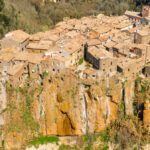
Your email address will not be published. Required fields are marked *
Yes, add me to your mailing list
- In the Press
- Work with us
- Rome & Vatican Rome Vatican Colosseum Rome Food
- Italy Florence & Tuscany Venice & Northern Italy Pompeii & Herculaneum Amalfi Coast & Capri Naples & Southern Italy
A Day From Rome: A Guide to the 3 Magnificent Villas of Tivoli
Fri 03 May 2019
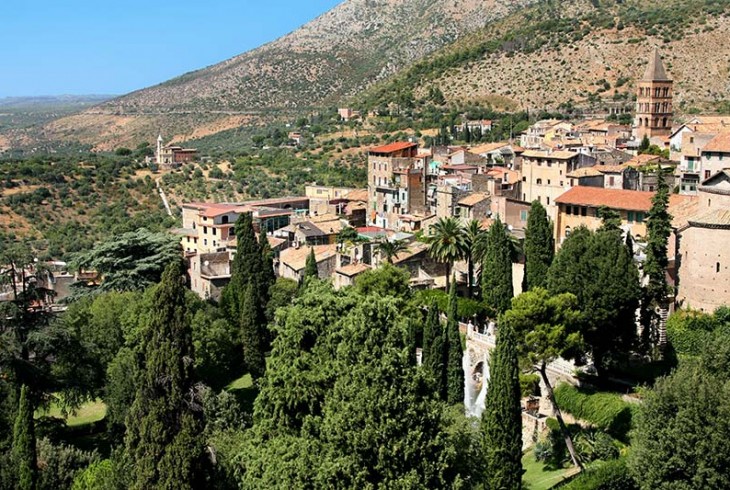
If you’re looking to escape the bustling chaos of Rome for the day, then do as the ancient Romans did and head to the small town of Tivoli, spectacularly perched on the falls of the Aniene river high in the Sabine hills 20 miles to the east of the Eternal City. Boasting spectacular views over the Roman countryside, the real draw of Tivoli is its wonderful historical villas – the ancient Hadrian’s Villa , luxurious rural retreat of the eponymous Emperor, and the no less spectacular 16 th -century Villa d’Este , whose expansive Renaissance gardens are amongst the world’s finest. Both are UNESCO world heritage sites for good reason, and at less than an hour from the capital visiting them together makes the perfect day trip from Rome. As if that wasn’t enough, Tivoli is also home to the Villa Gregoriana , a 19 th -century masterpiece of picturesque design.
Read on to get the low-down on what you need to see at the 3 Tivoli villas :
- Hadrian’s Villa: The Wandering Emperor’s Countryside Retreat
- The Villa d’Este: A Renaissance Palace to Rival the Ancients
- Villa Gregoriana: A Mysterious Marriage of Art and Nature
1. Hadrian’s Villa: The Wandering Emperor’s Countryside Retreat
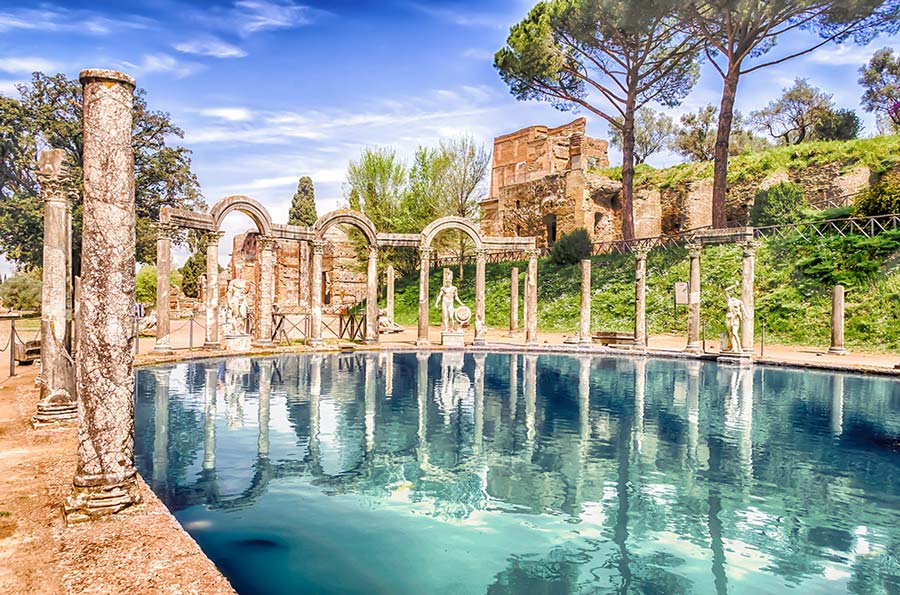
Nestled idyllically in the rolling Lazio countryside, Hadrian’s Villa is the largest and most spectacular villa of the entire ancient Roman world. Begun on the emperor’s command shortly after he ascended to power in 117 A.D. and continuously expanded over his 21 year reign, this immense archaeological site is more like a miniature city than a mere summer residence, covering an area larger than the footprint of Pompeii .
But just who was Hadrian? Born in modern day Spain, Hadrian was a cousin of the reigning emperor Trajan and rose to the top job after his death thanks to his marriage to Trajan’s great-niece. Traditionally known to history as one of the five good emperors (a fair claim, at least in comparison to acknowledged psychopaths like Nero and Caligula ), Hadrian lacked his predecessors’ appetite for conquest - instead preferring to glorify the empire with immense architectural projects.
It’s to Hadrian’s building mania that we owe Rome’s incredible Pantheon, which still boasts the largest unsupported concrete dome ever built, and Castel Sant’Angelo – originally the emperor’s mausoleum. He was also responsible for the 73 mile long Hadrian’s Wall that kept Roman Britain safe from the marauding barbarians of the northern reaches, the largest Roman structure ever built. This was an emperor that didn’t do things by halves, and so it’s no surprise that his countryside retreat was built on a scale more fitting to god than man.
Like many of us Hadrian was afflicted with incurable wanderlust , and spent much of his reign on the road exploring the furthest-flung corners of his empire. The contemplative emperor never particularly liked the chaotic bustle of Rome, and wholly dissatisfied with his digs on the Palatine Hill he soon began constructing a rambling estate deep in the Roman campagna. In his later years the Tivoli villa became the official Imperial residence – from then on Rome would have to come to him, and it was from this pastoral idyll that he managed the affairs of the massive empire.
What To See at Hadrian’s Villa
As the empire’s de-facto centre of power , Hadrian’s Villa had a permanent population of thousands, including the Emperor’s private Praetorian guard – their barracks still survive, complete with communal latrines. An underground network of tunnels connected the villa’s various buildings, allowing a legion of slaves to ensure the smooth running of the estate without ever being seen by the elites above.
Above ground, the villa boasted everything the emperor needed in his quest to escape the intrigues of the Senate without sacrificing the trappings of power and privilege. You can visit the remains of libraries and theatres , bathhouses and banqueting halls , endless pavilions, pools and temples – including a mysterious tower known as the Roccabruna from where Hadrian observed the passage of the stars and which is spectacularly illuminated on the summer solstice.
The magnificent baths complex meanwhile boasted under-floor heating and a sauna to impress the Emperor’s guests. Its beautiful stucco decorations were shot off the walls by souvenir hunting English gentlemen on their Grand tours in the 18 th century, but its coffered dome survives. No less impressive are the Latin and Greek libraries where you can admire beautifully preserved polychrome marble (opus sectile) floors.
But the absolute masterpiece of the Villa is the misleadingly named Maritime Theatre – in reality not a theatre at all but an extravagant artificial island surrounded by a canal ringed with a splendid colonnade. The island housed a miniature villa-within-a-villa, an inner sanctum accessible only by a retractable drawbridge reputedly designed by Hadrian himself , a keen amateur architect. Maybe a little too keen – Hadrian reputedly had the architect responsible for the Pantheon, Apollodorus of Damascus, executed for mocking one of his designs! When in less bloodthirsty mood the emperor retreated here to meditate and study in splendid isolation, surrounded only by his collections of exotic birds and fish.
Hadrian and Antinous: the Young Lover Made God
Hadrian’s decision to hole up in his vast countryside retreat wasn’t all about a quest for solitude – part of the villa’s appeal lay in the fact that it allowed him to spend quality time with his beautiful young paramour Antinous , who he had picked up on his travels through Turkey, far from the prying eyes of hostile senators and the stuffy rituals of downtown Rome.
Antinous drowned in mysterious circumstances in the river Nile at the age of 20 – a day later, the despairing emperor had him unofficially deified and temples sprang up in honour of the new god all over the empire. Hadrian built his tomb at the Tivoli villa, known as the Antinoeion , and studded it with enormous statues of the young Antinous dressed as the Egyptian god Osiris, one of which you can see in the Vatican Museums – Osiris rose from the dead in Egyptian mythology, and it seems that Hadrian hoped Antinous too would conquer death itself. The sepulchre’s centrepiece was a pink granite obelisk that you can now see in Rome’s Villa Borghese.
Greece and Egypt at Tivoli: Ancient Rome’s Greatest Theme-Park
Hadrian’s Villa doubled as an open-air museum where the emperor could show off the vast collections of art and antiquities that he had collected on his tireless travels. Obsessed with the cultures of ancient Greece and Egypt, the 4 th century Historia Augusta recounts that Hadrian wanted various parts of the villa to recall or even materially reconstruct famous landmarks from the great ancient civilisations. You might even think of Hadrian’s Villa as an exotic ancient version of a theme-park, the emperor’s very own private Disneyland. Only instead of Fantasyland and Main Street, Hadrian designed fantasy versions of places like Athens’ Stoa Poikile - a spectacular painted porch where Greek philosophers debated the mysteries of the universe. In Hadrian’s re-imagining this became the pecile , a 429 metre long porch wrapping around a fish pond where the emperor and his guests took after-dinner strolls.
The most spectacular of these architectural flights of fancy is the Canopus – a fabulous 100-meter long canal flanked by curved colonnades, inspired by an ancient Egyptian waterway near Alexandria. Hadrian’s miniature reconstruction is lined with sculptures based on famous Greek works – caryatids copied from the Erechtheion on Athens’ Acropolis , and even a crocodile . At the far end of the canal rises the beautiful shell-shaped grotto that imitates a sanctuary dedicated to the Egyptian god Serapis. In these spectacular surroundings Hadrian and his guests sat down to lavish summertime banquets , the reflections of the illuminated statues dancing in the water. Even today this idyllic spot offers a breathtaking glimpse into the lavishness of antique taste - and the limitless luxury that absolute power could buy in the ancient empire.
2. The Villa d’Este: A Renaissance Palace to Rival the Ancients
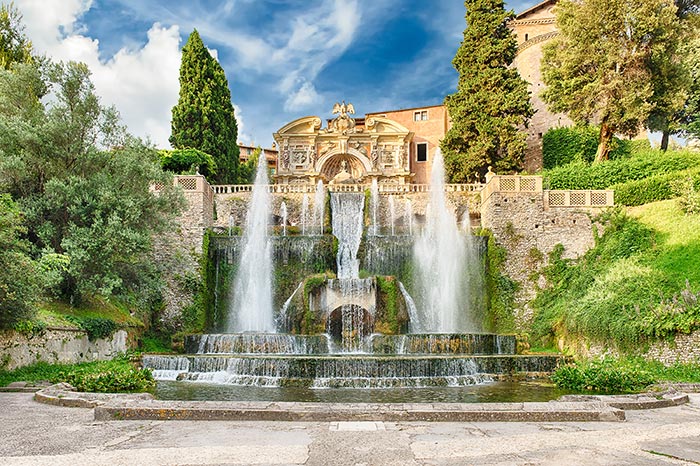
After the fall of the Roman Empire, Hadrian’s villa was abandoned and fell into oblivion. Its remains were finally identified in 1461, and Renaissance artists rushed in to draw and study the incredible find - Bramante and Raphael amongst them. When the multi-talented painter and architect Pirro Ligorio fully excavated the site a century later, the powerful d’Este family were watching on from their residence in the town above with mounting interest.
The clan’s pater familias, Cardinal Ippolito d’Este II , had nursed ambitions of becoming pope for his entire career. But after his hopes were dashed on account of his excessively lavish lifestyle (it seems he took after his mother, the notorious Lucrezia Borgia ), he decided to channel his energies into building a villa in Tivoli that would be the envy of Rome’s high society. Taking the nearby Hadrian’s Villa as his inspiration , d’Este hired Ligorio himself to design a modern equivalent of the emperor’s palatial country pile. The stately villa d’Este was completed in the 1570s, and today stands as one of the most impressive and refined aristocratic Renaissance residences in all of Italy.
What to See at Tivoli’s Villa d’Este
The palace itself is impressive enough as it unfolds around courtyards and echoing halls decorated with colourful frescoes by the hands of the era’s most famous artists, including Livio Agresti and Federico Zuccari . But it’s Ligorio’s awe-inspiring terraced gardens built into the side of a cliff that will really take your breath away, and that ensured the Villa’s lasting fame. This was the spectacular stage for lavish outdoor parties thrown by Ippolito for the elites of Europe, bacchanals that matched anything Hadrian and his luxury-loving guests ever managed in the distant past of the valley below.
Boasting panoramic views of the Roman campagna from its 200-metre long terrace, the grounds of the Villa d’Este were one of Italy’s first giardini delle meraviglia - a garden of marvels. And a marvel it certainly is: you could easily spend an afternoon here getting lost amongst its winding paths shaded by the branches of soaring Roman cypresses. In rocky niches and sculpted caves, statues of ancient deities gaze outwards covered in moss and weathered by the passage of time. Given that it was built by a cardinal hoping to become pope, you might be surprised by the sensuous pagan gods lurking around every corner – a naked Venus caught emerging from her bath is located in a niche that was known in the 16 th century as the ‘ grotto of voluptuous pleasure’ !
Water, Water Everywhere: The Fountains of Villa d’Este
But it’s water that makes the Villa, and it’s everywhere: over 50 fully-fledged sculpted fountains and nymphaeums, as well as 450 more spouts and jets and 64 cascading waterfalls are all fed by nearly a kilometre of canals flowing across the terraces – the sound of water follows you everywhere you go. Ligorio was also a highly skilled engineer, and incredibly the entirety of the waterworks are powered by gravity alone. To keep the cardinal’s demanding guests occupied, Ligorio also designed many of the fountains to perform tricks and illusions.
The most famous is the Fountain of the Organ , whose intricate hydraulic design meant that it was capable of playing pieces of music through the power of the water flowing through its hidden pipes. When Pope Gregory XIII arrived in 1582 (a visit that nearly bankrupted d’Este), he demanded to examine the mechanism in detail as he was convinced it was a trick and someone was hidden behind the fountain playing the music. After a meticulous restoration, the organ once again serenades visitors with its watery tunes, and at the time of writing, you can hear it playing every two hours starting from 10.30 a.m. daily.
Another spectacular highlight of the gardens is the so-called Hundred Fountains , a two-level walkway where a row of jets in the shapes of lilies, grotesque masks, eagles and boats all spew water into a long trough in perfect unison. Look out too for the Fountain of Rometta, a symbolic representation of the city of Rome in miniature, complete with little buildings and a boat carrying an obelisk in the centre, signifying the Tiber Island.
The gardens of the Villa d’Este have lost none of their allure over the centuries, and have fascinated everyone from the Hungarian composer Franz Liszt , who wrote Les Jeux d’Eau in the shadows of the fountains, to the avant-garde filmmaker Kenneth Anger whose Eaux d’Artifice is set amongst the relentless cascades.
3. Villa Gregoriana: A Mysterious Marriage of Art and Nature
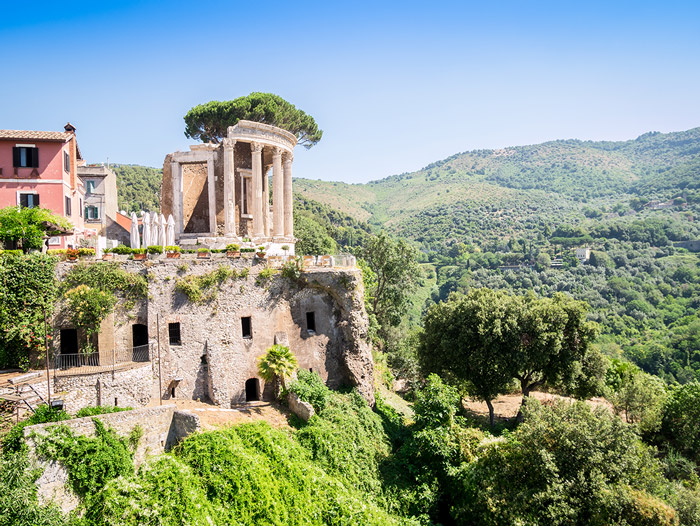
Tivoli boasts a third villa in its environs, less well-known than Hadrian’s Villa or the Villa d’Este, but well worth a visit in its own right. The Villa Gregoriana was the brainchild of Pope Gregory XVI in the 1830s, part of a project to contain the unruly river Aniene, and unlike the carefully designed spaces of its illustrious neighbours is a rustic haven for wildlife where untamed nature and Roman architectural remains vie for supremacy. Located in a valley known in antiquity as the Valle dell’Inferno, or the Valley of Hell , the villa is linked to the town by the picturesque Ponte Gregoriano. Pack your walking shoes, because this one’s quite a hike!
What to See at the Villa Gregoriana
Descending into the valley you’ll pass the spectacular 120 metre high Great Waterfall , where the rushing waters of the river Aniene spew out from the rock-face and tumble over a gorge – the same water that made the gardens of Hadrian and Ippolito d’Este possible, but that also threatened to engulf the town. At the base of the waterfall are dark and mysterious caves known as the Grotto of Neptune and the Grotto of the Sirens . Wreathed in the tangled trees and vines of the villa’s grounds you’ll also come across the remains of the ancient villa of the consul Manlius Vopiscus, immortalised by the poet Horace. Most impressive of all, though, is the incredible first-century B.C. Temple of Vesta, a circular temple ringed with beautifully carved Corinthian capitals perched on the edge of the abyss.
How to Get to Tivoli from Rome
There are three main ways to get to Tivoli from Rome. The easiest, and in our opinion best, option is to book a guided tour of Hadrian’s Villa and the Villa d’Este that includes private transportation from Rome - such as Through Eternity's Tivoli Day Trip from Rome .
If you want to go it alone and are just going to Hadrian’s Villa, then hop on the B line of Rome’s metro system heading north towards the terminus Rebibbia. Get off at the penultimate stop, Ponte Mammolo . The metro stop is linked to a bus station operated by the Cotral company – just follow the signs. Buy your tickets in the downstairs cafe at the station, asking for tickets to Tivoli. Get off at the Villa Adriana stop, 300 metres from the site. Just ask the driver to let you know the stop nearest the Villa and he or she will be happy to oblige. To plan your journey in advance, use Cotral’s online journey planner – enter Roma Ponte Mammolo in the “FROM” field and Villa Adriana in the “TO” field.
If you want to visit the Villa d’Este first, then you might find it easier to take the train from Rome’s Tiburtina station to the town of Tivoli. From here you can easily reach the Villa d’Este on foot. You can also catch a local shuttle bus that will take you to Hadrian’s Villa from here.
We hope you enjoyed our guide to the 3 Tivoli villas. If you’d like to learn more or want to arrange a trip to any of the sites featured in our guide, get in touch with Through Eternity today!
Post Categories
Suggested Tours
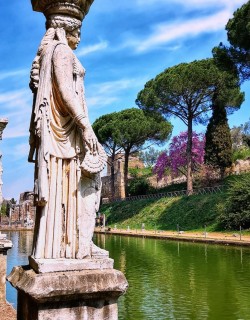
Tivoli Day Trip from Rome: Outstanding Villas
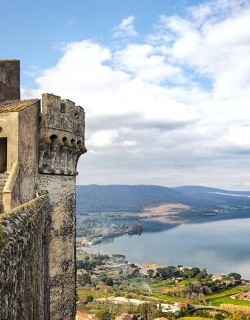
On the Trail of Medieval Lazio: A Day Trip to Bracciano, Caprarola and Viterbo
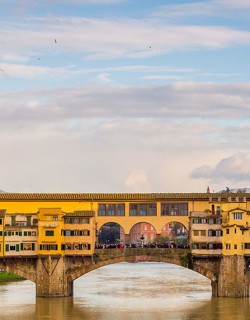
Day Trip from Rome to Florence by Fast Train
Subscribe to our newsletter and receive 5% off your first booking!
You'll also receive fascinating travel tips and insights from our expert team
Subscribe to our free newsletter
Thank you for subscribing!
You should shortly receive a confirmation message with your discount code. If you do not receive this within 5 minutes, please email [email protected].
Visiting Villa d’Este in Tivoli
Built more than 400 years ago, this villa in the Italian town of Tivoli is one of the finest examples of renaissance architecture and gardens in the world.
Written by Michael Turtle
Michael Turtle is the founder of Time Travel Turtle. A journalist for more than 20 years, he's been travelling the world since 2011.
Michael Turtle is the founder of Time Travel Turtle and has been travelling full time for a decade.
Updated: May 14, 2024
Visiting Villa d'Este and Tivoli Gardens
The interior design of Villa d'Este in Tivoli is beautiful, considered one of the finest examples of Italian Renaissance, and one of the reasons this is a World Heritage Site.
But the highlight is the landscaping around the villa, known as Tivoli Gardens, decorated with fountains and stunning artworks. And a visit to Villa d'Este and Tivoli Gardens is an easy day trip from Rome.
- What you'll find inside Villa d'Este
- Everything you want to know about Tivoli Gardens and its fountains
- Some tips for the best tours to Villa d'Este
- Details about visiting Tivoli Gardens and Villa d'Este from Rome
It’s not too hard to imagine what kind of man Ippolito II d’Este would have been. Born into a wealthy and influential Italian family in 1509, he was a lover of the finest things.
Although he was made Archbishop of Milan when he was nine years old (the title was hereditary then), he saw the church as an instrument to be used to gain even more power.
Vows of celibacy weren’t his thing. He would bring in musicians, prostitutes, feasts and wine to impress the people who needed impressing.
When he was made the governor of Tivoli, he arrived in the town about 20 kilometres from Rome and did not like the look of the home that had been assigned to him.
And so, in the style appropriate for someone who kept peacocks as pets, he decided to build Villa d’Este – a new and much grander residence, not far from where the Roman emperor Hadrian had built his pleasure palace (taking many marbles and statues from the ancient site to decorate his new one!).
Nobody argued at the time when Ippolito II d’Este decided to dramatically modify the monastery he had been given in Tivoli – he was, after all, the grandson of a pope.
And you’d be hard-pressed to find someone who would argue today, because his creation of the Villa d’Este and its Tivoli Gardens is one of the most magnificent examples of renaissance architecture and landscaping in the world.
While Villa d’Este is smaller than the nearby Hadrian’s Villa , and it was constructed about 1400 years later, the two palatial homes do have something in common – they are both World Heritage Sites.
Before I tell you more about Villa d’Este and its gardens, it’s just worth mentioning that visiting Tivoli and seeing both World Heritage Sites is a wonderful day trip from Rome.
There’s a very good and affordable tour covering both places that I would recommend, or a few more options here if you’re looking for something else:
Although you’ll learn more about the site when you’re here, let’s have a look at what you’ll find when you visit Villa d’Este in Tivoli.
Inside Villa d’Este
The large villa is spread over two levels with grand rooms with unique designs.
The paintings on the walls and ceilings of the rooms make them feel more like cubes of art than practical spaces, but they were used back in the 16th century for both living and entertaining.
Most of the artworks have been described as ‘secular allegories’, which is probably quite suitable for a man who seemed to give his own interpretation to the role of the church.
Although Ippolito II d’Este became a cardinal (and almost pope), it was much more to do with lavish gifts he sent to European dignitaries than for selfless service to religion.
The Apartments of the Cardinal
You enter Villa d’Este from a piazza and onto the top floor of the building. It’s now known as the Apartments of the Cardinal, because it was the personal living area of Ippolito II d’Este.
The large salon is the first room and could used for receptions. From there, you’ll go through to an antechamber, decorated with personifications of virtue, before you reach the cardinal’s bedroom… where it’s likely things were not so virtuous.
The bedroom’s walls were once covered with leather painted with gold and silver but, like much of this upper level, those decorations have now gone. The ceiling, though, is wooden and gilded with painted imagery including the Este crest.
Connected to the bedroom are a small library and chapel.
They are decorated with frescoes that mix Ancient roman motifs with traditional Christian symbols – perhaps a nod to his background and the pieces of Hadrian’s Villa that were used to decorated the new estate.
Looking out the windows from the Apartments of the Cardinal, you get a stunning view down to the gardens and across the green countryside around Tivoli.
The Noble Floor
Going down a set of circular stone stairs, you’ll reach the Noble Floor, a series of about ten ornately decorated rooms coming off a long corridor.
Each room has walls and ceilings painted with frescoes, with other adornments like mosaics and stucco. There’s a different theme for each room, most related to nature, water, and mythology or religion.
For example, one of the first rooms you’ll come into is the Hall of Glory, which has the illusion of windows, tapestries, and sculptures painted onto the walls. There are allegorical depictions of the seasons and virtues.
The largest room you’ll see here is the Hall of the Fountain, named because it has a small fountain in the wall at one end.
It was used as a reception hall to greeet people who had just arrived through the garden (the main entry back then), but it could also be used for concerts and other events.
The frescoes on the wall show the gardens of Villa d’Este and an image of Ippolito’s villa in Rome.
At the far end of the Noble Floor are a series of rooms, each decorated with a different story.
For instance, there’s the Hall of Noah, which you can see in this photo, with a central image of Noah making an agreement with God shortly after the ark landed on Mount Ararat.
Even for visitors to Villa d’Este who have come mainly for the gardens, the rooms of the villa are worth a bit of time and each one has so many different layers to uncover.
Tivoli Gardens
There’s no denying that it’s the gardens of Villa d’Este, also known as Tivoli Gardens, which are the most lavish part of the compound.
From the villa, stairs and paths lead down to the garden along five main corridors. At one side, the garden is elevated by a cliff-like fountain. The effect is that the whole space feels a bit like an amphitheatre.
Throughout the garden area are immaculately manicured hedges and trees, colourful flower gardens, stone statues and fountains.
It’s designed so different parts have different atmospheres, with areas to relax in the sun or the shade, with a view or without one.
There are small private areas where you could sit in peace and read a book, for instance, but much of Tivoli Gardens was intended to be used for large functions, and there are space for games, performances, and even fireworks.
The fountains themselves are works of genius and were all designed to use gravity and hydraulics to move the water through them. Even today, all but two large jets are still operated without electronics or motors.
Although there are quite a few fountains in Tivoli Gardens, I’m going to mention a few to look out for:
The Fountain of the Organ
One of the most famous parts of Tivoli Gardens is the Fountain of the Organ, which has a complicated mechanism inside that uses water to operate instruments like pipes and trumpets. The music it creates is coordinated with the jets of water that are produced.
When it was built in 1571, most people had never seen anything like it before and it was a highlight of many guests’ visit to the villa.
The organ inside the fountain has been replaced since its original installation and it now has 144 pipes. It is still used these days and there are performances every two hours from 10:30 in the morning.
The Fountain of Neptune
Below the Fountain of the Organ is the Fountain of Neptune, which uses the water that flows down from the upper construction.
It was actually built in the 1930s to replace a 17th-century rocky cascade that had been neglected and needed to be replaced. It gets its name from the torso of a statue of Neptune that is in a grotto behind the main waterfall.
With its water jets of different heights, it creates a lively centrepiece at the end of the promenade of fish tanks that cut through the garden.
The Oval Fountain
The Oval Fountain was one of the first fountains built in Tivoli Gardens and was used for people to hang out on hot days, because the sprays of water cooled the air.
The focus is the large stone basin in the centre that creates a veil of falling water, but there are also smaller jets coming out of vases being held by statues of sea nymphs.
The artificial mountain behind the fountain is supposed to represent the landscape of the region, and it has three grottoes with water pouring out.
The Hundred Fountains
It’s hard to miss the Hundred Fountains because they stretch across the length of a pathway close to the side of the main villa building. There are actually about 300 spouts with water coming from thee canals at different heights.
The original fountains had more decorations, including small boats in one of the canals. What you can see now are spouts in the shapes of lilies, eagles, and obelisks.
As you explore the gardens, you’ll see at least six more fountains of different sizes. Each one of them has a story and you’ll be able to learn even more about what they represent if you go on a guided tour of Tivoli Gardens.
Ippolito II d’Este may have been an extravagant man who presumably made as many enemies as he did friends – but he has left us with a stunning legacy of which he should be proud.
Tours to Villa d’Este and Tivoli Gardens
As I walk down from the fountains at the top, with the villa above me on the left and an emptiness ahead that looks out over the suburbs of Tivoli, I can only imagine how it was to be here more than 400 years ago when the villa first came into existence.
The parties which must have been held here, the important people who must have come to visit, the amazement of everyone when they beheld this masterpiece for the first time.
It is possible to visit Villa d’Este independently, and I’ve got some information in a moment about how to get to Tivoli from Rome by public transport, for instance.
But there’s so much to see here, and so many interesting stories about the parties and other exuberances that took place, you’ll get a lot more from a guide.
Most tours leave from Rome and most of the combine Villa d’Este and Hadrian’s Villa , which makes sense because they’re two of the most significant sites near Rome (and are different enough that it doesn’t get boring to do them both on the same day.
The logistics of getting between the two sites (which are about 5 kilometres apart) can also be a bit of a hassle, so doing a tour that covers them both in much easier.
To do a day trip from Rome to see both Hadrian’s Villa and Villa d’Este, there’s a very good and affordable tour here that I would recommend.
Or, there are some other good options that you may suit your circumstances better:
Whichever you choose, I would recommend a trip that includes both Hadrian’s Villa and Villa d’Este.
Visiting Villa d’Este and Tivoli Gardens
Over the years the villa did fall into a state of disrepair but it was eventually taken over by the Italian Government in 1920. Since then they’ve worked to restore and maintain it and make it available to everyone.
It’s certainly worth doing a day trip from Rome to Tivoli to see Villa d’Este. The villa and the attached Tivoli Gardens are in the centre of town and easy to reach by direct train from Rome.
However, be warned that Hadrian’s Villa is about five kilometres away – if you want to see it too, it might make sense to use the Metro between there and Rome.
I would recommend about two hours to see Villa d’Este and Tivoli Gardens. You can rush through if you need to, because the site doesn’t take up that much space, but there are so many little details to see – and they are what make it so special.
Where is Villa d’Este in Tivoli?
Villa d’Este is in the centre of Tivoli at Piazza Trento, 5. The entranceway looks quite simple but don’t be fooled – it opens out to the impressive villa and garden once you’re inside.
How do you get to Villa d’Este in Tivoli?
The quickest way to Villa d’Este from Rome is to catch a direct train to Tivoli station from Termini or Tiburtina. The site is just a short stroll from there. Alternatively, you can catch the Metro Line B to Ponte Mammolo and then get the bus marked to Tivoli.
When is Villa d’Este open?
The main Villa d’Este building is open from 08:30 – 19:45 every day except Monday, when it opens at 14:00 instead. You can access Tivoli Gardens from 08:30 but the gardens close at different times during the year: January, November and December: 16:45 February: 17:15 March: 18:00 (with the summer time 19:00) April: 19:15 May – August: 19:30 September: 19:00 October: 18:15 (with the winter time 17:15)
How much does it cost to visit Villa d’Este?
Entrance fees are €15 for an adult, €2 for a reduced ticket. Children under 18 are free. You can buy tickets in advance here to skip the line, but I’m not sure it’s worth the extra expense. You can also get a combined ticket for Villa d’Este, Hadrian’s Villa, the Sanctuary of Hercules Victor, and Mensa Ponderaria for €28.
More information
You can find out more information at Villa d’Este’s official website .
Visiting Ville d’Este is an easy day trip from Rome or a good stopping point for journeys to the east of the capital. It is definitely worth the trip.
You can also combine it with a visit to Hadrian’s Villa in Tivoli and, remember, this tour will take the hassle out of all the logistics .
If you’re travelling independently, you may also like to stay the night in Tivoli which, although relatively small, is a lovely town with some great restaurants that are not too crowded in the evening.
THE BEST ACCOMMODATION IN TIVOLI
Although you can visit as a day trip from Rome, there’s enough to see to make a lovely overnight stay in Tivoli.
There aren’t really any hostels in town, but you’ll find good rates at La Giada .
I think Cristallo Relais is a wonderful little hotel with excellent value for money.
For a rustic villa atmosphere, have a look at the charming Casale Colleoni .
And for an incredible historic hotel, Residenze Gregoriane is a very special experience.
This site is on the UNESCO World Heritage List ! I'm on a mission to visit as many World Heritage Sites as I can. Only about 800 more to go... eek!
10 thoughts on “Visiting Villa d’Este in Tivoli”
Wow. I’ve never seems gardens like that before! Absolutely insane. Another villa to add to my list… 🙂
Thanks for sharing!
Oh, you’ve got to go! The gardens are insane. They’re even more spectacular when you realise all the fountains and water features are being powered by gravity!
Gorgeous! Without question, the property is beautiful and the engineering certainly inspires awe, as does the extraordinary and abundant art. I too find it difficult to imagine living in spaces so thoroughly detailed in artwork, though with that said, your images of the interior are extraordinary and I loved having the opportunity to do a virtual visual walk-through.
The interiors were stunning and when I was standing there looking at them, I was so glad I’d decided to visit. But then I went outside to see the gardens and was blown away – they were even more spectacular to see in person!
Villa d’Este, Tivoli – now this is a dreamy place! Why can’t I own such a place! LOL What unrealistic dreams I have this morning! Great post with great photos.
It’s so big you could share it with about 50 other people and you wouldn’t even know they were there… that makes it a bit more realistic, right? 🙂
I want painted walls & ceilings like that in my place, haha!
Just imagine how that would look! It’s pretty spectacular, isn’t it?
Beautiful! I’ve always wanted to visit the villa and gardens but never seem to make it there. It’s always the places closest to home we think we’ll get to but pass over for more faraway lands.
If you could do it as a weekend trip, you definitely should. It’s absolutely beautiful and is a little different to the usual Roman ruins and churches that seem to be the main sights around the country.
Leave a comment Cancel reply
In italy, i recommend:.
🏨 Hotels: Booking.com 👩🏫 Tours: GetYourGuide 🚗 Car hire: Discover Cars ⛴️ Ferries: Ferryhopper
Find me on the socials:
Subscribe for news and deals:.
top stories:

Tivoli is the Best Day Trip From Rome, Italy

I absolutely fell in love with the little town of Tivoli in Italy. It’s just about 30 minutes outside of Rome making it a great day trip. You will see beautiful homes, cute streets, and gorgeous gardens. It’s definitely a trip worth taking and I can’t wait to go back!
This post contains affiliate links. If you happen to make a purchase through these links I will earn a commission at no extra cost to you. Thank you!
Last year my mom and I decided to take a mother/daughter trip for my birthday. It’s definitely something I always recommend doing. Both my mom and I have been to Rome before but we were also looking for a new place we could explore (I’m always trying to see more places in this world). Which is why I was so pleased when I discovered Tivoli. It really is the best day trip from Rome!

But first a little history:
Tivoli received Roman citizenship in 90 B.C. and became a summer resort during the late republic and early empire. Emperor Augustus and poets such as Horace, Catullus and Sextus Propertius were just some of the people who would vacation here. Many wealthy Romans built villas here and created small temples.
However the town suffered during the barbarian invasions. And it wasn’t until the 10th century that the town would recover.
Today, Tivoli welcomes guests with beautiful architecture, gardens, and a rich history that still lives on.

How To Get There:
Okay, let’s discover why Tivoli is such a great day trip from Rome. Not only is it very close, but there are also quite a few options when it comes to traveling to Tivoli from Rome. You can take the bus, drive, or do what my mom and I did, and take the train. The train was so easy and was a really nice ride. Just be sure you stamp your train ticket before getting on the train. My mom and I were rushing to catch the next train and didn’t do that. So when the train conductor came on board we acted like tourists and managed to get out of a hefty fine for not validating our ticket beforehand.
The great thing about the train is that it drops you off within walking distance to the main town and two highly recommended sites. To get to the train in Rome, take the metro B line to Rome’s Tiburtina station. Then take the train to Tivoli. The trains run very frequently.
You could also take a tour to Tivoli. I’m glad we didn’t as I felt we had more time in the two sites we saw on our own but it’s definitely a great option. It’s also a nice option if you’re a solo travel like I normally am.
Here’s a great option for a day tour from Get Your Guide .

What To See:
Now you’re probably asking what can I see here to make this a worthwhile day trip from Rome? Well sit back because I’m about to amaze you with beautiful gardens, fountains, homes and even waterfalls!

#1. Villa D’Este:
Definitely check out this absolutely breathtaking UNESCO World Heritage site. The palace and beautiful gardens were laid out by Pirro Ligorio on behalf of Cardinal Ippolito II d’Este of Ferrara who after being named governor of Tivoli in 1550 wanted a palace that resembled his new status. And I think it’s fair to say he got it.
A really neat fact about this palace is the aqueduct and tunnel under the city that feeds all the fountains and is similar to the engineering of the Ancient Romans. I loved this place. And definitely check out all the fountains. The Oval Fountain and the Hundred Fountains were definitely my favorites. But they’re all beautiful. For more info including hours and ticket prices, please check out their official website.

#2. Villa Gregoriana:
This ended up being both mine and my mom’s favorite place we saw here. And the great thing is that it’s within walking distance of the town. And not too far from Villa D’Este. It’s quite a walk down and up but so incredibly worth it. It’s absolutely breathtaking and I loved the calmness I felt here.
Villa Gregoriana was created by Pope Gregory XVI in the 1830s. It’s located in the Valley of Hell – named that because of the two very steep drops. You’ll pass a giant waterfall on your way down into this grand valley. At the base of the waterfall is the Grotto of Neptune and the Grotto of the Sirens. There’s also a 1st century B.C. circular temple perched out over the cliff called the Temple of Vesta.
I loved this place so much and would go back and do this hike in a heartbeat. I do recommend comfortable shoes.

#3. Hadrian’s Villa:
We unfortunately ran out of time to visit this UNESCO World Heritage site that dates back to the 2nd century AD. It’s a little further out of town. And if you’d like to visit I recommend driving or taking a day tour from Rome. But you can also take the CAT bus n. 4 from Tivoli Station to Hadrian’s Villa stop (Villa Adriana). This was going to be the way we were going to get there but we just ran out of time. Not enough hours in the day, am I right?
The villa is enormous. And Hadrian basically ran his entire empire from here since he disliked Palatine Hill in Rome so much. Unfortunately the villa fell into despair with the fall of the Roman Empire, but it was later rediscovered in the 15th Century.
If you’d like a little back story on Hadrian, he was responsible for the famed Pantheon and Castle Sant’Angelo in Rome. He was a man possessed with wanderlust (something I can relate to all too well) and spent much of his time visiting the far lands of his empire.

Where to Eat:
The food here was also impeccable! Just another reason Tivoli is the best day trip from Rome.

I highly recommend wandering around the cute streets and then finding a place that interests you. We ate at a great cafe near the Villa D’Este and had some amazing pasta. We also grabbed gelato as you can never go a day in Italy without gelato (at least that’s my motto) ;).
Ristorante Sibilla comes highly recommended and has a beautiful view near the Villa Gregoriana. The restaurant dates back to 1720. We didn’t eat here as we were trying to keep our trip within a budget but it looks lovely! I’ll be checking it out next visit.
We headed back to Rome on the second to last train. We almost missed it as we didn’t buy our return ticket ahead of time, so I might recommend doing that just in case.

Tivoli far exceeded my expectations. Tivoli was truly a magical town and I can see why it was favored by the Ancient Romans. It’s definitely a day trip worth taking. Anywhere in Italy is usually magic. I’ve been very fortunate in being able to see many (and even living briefly) places in Italy. I hope this guide has inspired you to make Tivoli a day trip of your own from Rome. Keep being amazing lovelies!
And happy traveling! 🙂

« The Best Weekend in Palm Springs, California
My ultimate guide to staying in the getaway cabins », you may also like.

The Best Guide to Joshua Tree National Park

How to Spend 24 Hours In Madrid, Spain

Day Trip to Ayutthaya, Thailand
22 comments.
Those fountains look so tempting right now – and so cute! And the views! Wow! We are definitely going to visit Tivoli when we visit Rome next!
kitcatfilms
You will love Tivoli so much!! 🙂 xx
WOW, now I really have travel fever! Italy has been on my bucket list for so long now, but I have not made it yet. I would absolutely love to go to Italy as soon as it is safe again, and now I know I need to plan to visit Tivoli. Your pictures add such amazing detail and feeling of wanderlust to the post. Thanks for sharing!
Aw I’m so happy I’ve inspired you to go! It’s so magical! I have major travel fever too so I feel you. But writing helps. Hopefully we can all travel again soon! 🙂 xx
Looks like a fantastic place to go. I want to go to Rome in about a few years. Your pictures are stunning.
You will LOVE Rome! It’s such a great city. I never tire of going. Hopefully we all get to go soon! 🙂 xx
Looks absolutely stunning! Would love to go! We threw our coins in the Trevi a few years back so one day hopefully…😊
Aw that means you will go!!! Yay! Hoping it’s soon 🙂 xx
Ariel Allen
Great post, truly stunning photography.
Aw thank you so much! 🙂 xx
Tivoli looks such a great place to visit 🙂 I didn’t know about it until I read your blog! Also, I absolutely love all your pictures.
It’s definitely a bit hidden, I just found out about it a year ago! But it’s awesome for that reason, not a lot of tourists. There are some of course, but it definitely feels more like you’ve discovered something great out here. It’s truly lovely. You’ll adore it 🙂 xx
Great information. Thanks for sharing. We did not visit Tivoli on our last trip to Italy. But after reading your post definitely will add this to my list on our next trip:)
You will love it so much!! I can’t wait to go back 🙂
I absolutely loved Italy, but never got to Tivoli! Now it is absolutely on my list for my next trip! Great photos!
You will absolutely love it! 🙂 xx
Absolutely stunning! This seems a fantastic place. I love it so much. The photos that you took are really amazing! xxx
I ALMOST went here when I was in Rome 2 years ago!! After seeing this post I definitely regret not going. But, I just moved to Northern Italy so looks like I’ve got a stop to make next time I’m on my way to Rome!
Aw I’m so happily jealous you’re living in Northern Italy! How magical! And you will absolutely love Tivoli! 🙂 xx
Chelsea Boccardo Smith
Well, I definitely wish I had read this blog before I went to Italy last year! My husband and I just happily walked around Rome for days, not knowing anything about Tivoli! Of course, Rome was still amazing, but this place is also gorgeous. Thank you for these amazing photos. I so badly want to return!
Rome is so lovely!! I hope you get to go back soon! Italy is always a great adventure! 🙂 xx
© 2024 The Traveling Filmmaker

- FREE GUIDES
day trips , History
15 comments
Visiting Tivoli from Rome
August 19, 2013
Last week, while contemplating other themes that would readily lend themselves to my snarky commentary, a friend of mine asked me to write an article for a website that she manages called Italian Talks. She explained that they’ve recently repurposed their content and have invited a few heavyweights in the travel blogging niche to become regular contributors.
They’ve attracted such well-known travel writers as Jeff Titelius from Euro Travelogue and Keith Jenkins, founder and publisher of Velvet Escape (Yes, I’m thinking the same thing as you: How did Rick Zullo manage to finagle his way onto that roster? It’s a good question, but one that I’m reluctant to ask too directly. If they initiate any serious inquiry, it won’t take long for them to realize their colossal mistake. Shhh…)
It was easy to pick a topic, since writing about Tivoli has been on my mind anyway. Being the pigrone (translation: big, lazy slob) that I am, I saw this as a perfect opportunity to maximize my exposure while minimizing my effort by pairing it with the post that you’re presently skimming through. But also because the town of Tivoli holds a bitter-sweet place in my heart. Sweet because it’s where my wife and I went on our first date. Bitter because, for some reason, this is the Questura I was assigned to when applying for my first Permesso di Soggiorno , requiring me to make about six futile visits there in the course of seven months. Anyone who has read my previous blog posts on the subject has a pretty good idea how I feel. “Bitter” only scratches the surface. Grrrr…
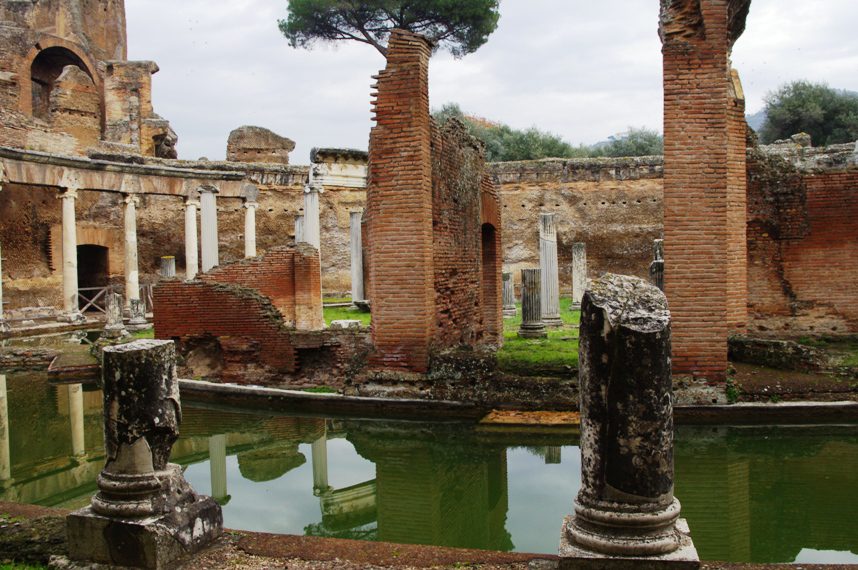
So yes, I know Tivoli much better than any other of the little villages around Rome, and there are several spots in the immediate area worth a close look. There’s the Villa of Emperor Hadrian, who built a sprawling compound near Tivoli in the 2 nd century A.D., complete with palaces, pools, libraries, temples, and a theater. Hadrian was an enthusiastic traveler and he drew inspiration from the many civilizations he encountered along his voyages, particularly Egypt and Greece. These influences can be seen throughout the architecture of the remaining ruins. Take a deep breath and you’ll smell the sulfurous odor of the natural hot springs ( terme ) nearby, which Hadrian and his fellow Romans believed had therapeutic qualities. Nineteen centuries later, they’re still there and open for business.
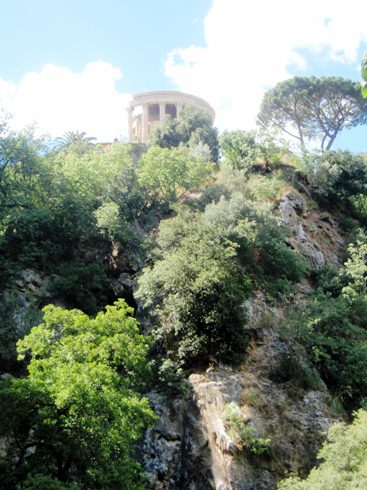
On the outskirts of Tivoli is the park of Villa Gregoriana, which features two temples from the 2 nd and 3 rd centuries B.C. Follow the path down into a plummeting gorge and enjoy the refreshing waterfalls at the bottom of the ravine. When you arrive, you’ll discover the secret caves of Neptune and the Sirens—a cool refuge during the heat of August.
The crown jewel, however, is Villa D’Este where the sophisticated style of the late Renaissance transitions into the awkwardness of the mannerism era, and finally giving way to baroque exaggerations. This place has something for everyone, whether you’re a lover of art, architecture, history, landscape design, or just natural beauty. Please check on my article this week on the Italian Talks website to read more about this incredible Villa and its even more incredible gardens. Visiting Tivoli from Rome is easy–just a one hour train ride from the center of Rome to Tivoli station and then a short walk to both Villa D’Este and Villa Gregoriana.
Thanks again to Italian Talks for inviting me on board. Their website is a fantastic source of information. More than that, as their tagline says, it’s really a collection of “Italian stories by true lovers of Italy.” I’m truly honored to be part of their team.
How to reach Villa D’Este Tivoli is easily reached by train from the center of Rome in about an hour. Take the Roma-Pescara Line to Stazione Tivoli, and walk across the bridge to the center of town. There are many street signs pointing the way to the villa. Address: Piazza Trento, 5, 00019 Tivoli, Province of Rome, Italy
Visiting the Villa and Gardens Visiting Hours are from 8:30 a.m. until one hour before sunset. The villa is closed on Mondays as well as January 1st, May 1st, and December 25th. The Hydraulic Organ Fountain is active daily, from 10:30 a.m., every two hours.
Recent Posts:
The Language of Wine
Gay travel in italy – fci 049, tuscany food and wine tours with judy witts francini – fci 048, iconic italian style, about the author.
Living in the Caput Mundi and trying to decipher Italian culture for the English speaking world.
Fantastic introduction to Tivoli! I haven’t been there yet but would love to venture someday! Thanks for all the helpful tips as well! Most of all, thank you so much for your kind words in your opening paragraph! I am truly honored!
You’re most welcome, Jeff…happy travels!
Ciao Rick- I have never heard of the other blokes (note to self- must read more blogs)- but I am very glad I have heard of you. As ever love your style. Look forward to remembering to read your soggiorno story Dx
Thanks Debbie! And congrats on your acceptance into the journalism program. Tanti auguri!!
Really enjoy this quick tour. I watched A Roman Vacation with Audrey Hepburn and Gregory Peck last night, and I thought how lovely it would be to visit Rome, now I will add Tivoli. Grazie
This is the best time of year in Rome, in my opinion. The weather is hot during the day, yes, but the nights are wonderful and there’s even a lull in the crowds. And when you want some air and open spaces, head up into the hills in Tivoli and enjoy a completely different atmosphere. Che bella, questa vita romana!
Thanks for your posts, Rick. We enjoy them and use them in our stays in Rome. This year it will be in Sept. though we even hate to leave the city when we are there every few years! For us it is a long trip from coastal CA.
I know what you mean! Tivoli is an easy trip, though, and well worth it if you have time. Then again, the city itself has plenty to you busy! Thanks for your comments, as always, Sabine. Ciao!
Great post, Rick. On my itinerary this September while in Rome. Do you know if the train will also take you further around the old imperial estates? Also, off the subject, but have you been to the Marino Grape Festival held the first Sunday in October? If so, would you recommend it?
Thanks for all you do…..a great job of keeping us all informed!!
Hi Susan! The easiest way to get to Tivoli is the Roma-Pescara line which goes east through Abruzzo all the way to the coast of Le Marche. As far as I know, there aren’t really any other stops along that line that would be on a typical tourist itinerary. As far as the Grape festival in Marino, I tried once, but got to the Termini station too late and the trains were all full. It gets crowded and my advice would be to leave in the morning, have a little walk or something, enjoy one of the great osterie in Marino (I HIGHLY suggest “Osteria de mi Nonno””). Then after a long lunch you can enjoy the festival before the peak crowds arrive. If you go, let me know about it!
I sure will….thanks for your ideas. The recommendations for Marino works perfectly. I heard that the main fountain in Marino pours red wine! Best I have a pitcher with me… Susan
A pitcher is a great idea…alla tua salute!
Thank you, Rick. This is very helpful and I hope to make Marino to witness the wine flow freely from the fountains. Let’s hope it doesn’t flow through the faucets of the homes this time!!
Hi Rick, Enjoyed your post and have now found another Italian lovers site to check out now and then. Italian Talks is now in my toolbar. I have been to Tivoli during several trips to Italy and love it. Even years ago did the night tour when I still had to travel in summer–which I don’t now. I have never made it into Villa Gregoriana, but that will have to stay an unfulfilled wish. No way I could get down there and up at my age. I enjoyed a private guided tour of Hadrian’s Villa and Villa d’ Este last January. Very expensive but so worth it to me. Thanks again for your interesting posts. A presto, Joan
Joan, as always, thanks for your comments. As many times as I’ve been to Tivoli/Villa D’Este, unfortunately I’ve never seen it at night, which I think would be beautiful. Yes, Villa Gregoriana is a hike at any age! But you can still see the temples at the top of the gorge. If I’m not wrong, one of them even serves as a (high-priced) wedding venue these days.
Channel Your Inner Italian!
Whether you're preparing for an upcoming vacation, trying to reconnect with your family's roots, or if you just want to emulate the joyful and healthy lifestyle of Mediterranean Italy, then get started by downloading one (or all) of my FREE guides to Italian living at its best!
Session expired
Please log in again. The login page will open in a new tab. After logging in you can close it and return to this page.

7 Underrated Tourist Towns Near Rome Worth A Visit
Fancy a break away from the city and thousands of tourists? Don't miss these scenic towns outside Rome that make the perfect day trip!
- Experience Rome's overlooked towns with rich history and charm just a short drive or train ride away.
- Tivoli, Bracciano, and Trevignano Romano offer tranquil escapes with stunning architecture and landscapes.
- Don't miss unique celebrations like the Infiorata Festival in Genzano di Roma or the Strawberry Festival in Nemi.
Rome, Italy's Eternal City , is without a doubt the most visited city in all of Italy, and it's not hard to see why. Home to the most iconic landmarks in the world, like the Colosseum , the Pantheon , and the romantic Trevi Fountain, which is worth a visit , Rome's unforgettable history and preserved architecture make it a tourist hotspot in Europe over 1,500 years since its founding.
While Rome is certainly worth a visit, the city can become overwhelmingly packed with crowds, especially during the summer. Fancy a day trip away from the city and thousands of tourists? Several small towns outside of Rome often get overlooked but are full of the same charm, scenery, and cultural experiences as Rome, but far less crowded and more authentic. Next time you're in Italy, don't miss these underrated tourist towns near Rome.
7 Cheap Italy Vacations For Under $1,000 Per Week
About 26 miles and a 50-minute drive away from rome.
Tivoli, a little less than an hour away from Rome, is a charming town that offers a delightful escape. Like Rome, Tivoli boasts a rich history, which you can find at attractions like the stunning Temple of the Sybil and the ancient Hadrian's Villa . A key difference is that Tivoli offers a more tranquil and less crowded atmosphere compared to the bustling streets of Rome. The two most popular things to do in Tivoli are Villa d'Este and Villa Gregoriana. The lush parks, gardens, and cascading waterfalls turn Tivoli into a true Italian paradise.
6 Bracciano
About 31 miles and 1 hour away from rome.
Perched above Lake Bracciano is one of the most picturesque medieval towns in Italy that everyone should visit this summer . Bracciano is just an hour north of Rome and is one of the many scenic towns that rest along the shores of Lago di Bracciano. Bracciano is well known for its winding streets, sweeping panoramic views, and intriguing castle on the town's hilltop. Besides its medieval charm, Bracciano also has a wide selection of incredible restaurants, scenic picnic areas, and a few hiking trails to enjoy the countryside surroundings.
7 Affordable Alternatives To Italy's Amalfi Coast
5 trevignano romano.
Directly across Lake Bracciano is another lakeside village that boasts rooftop viewpoints, a quintessentially Italian Old Town, and outdoor activities that appeal to all types of travelers. If you're looking for a more slow-paced, relaxing holiday in Italy away from the bustling streets of Rome, Trevignano Romano is a great option.
Trevignano Romano is an ideal village where you can enjoy promenades through the Old Town, lounging on Blue Banner Beach, hiking along the shoreline, and dining at authentic Italian restaurants. If you're craving some fun outdoor activities, there are plenty of watersports available, such as paddleboarding, sailing, and even an inflatable waterpark on Blue Banner Beach.
About 42 miles and a 1 hour and 20-minute drive away from Rome
Located in the coastal region of Lanzio over an hour away from Rome, Anzio is a popular spot for a beach day trip or weekend getaway. Plus, as far as Italian coastal towns go, Anzio is a much cheaper alternative to the famous Amalfi Coast . The mix of this small town's unique coastline, spectacular caves, and lively downtown area make Anzio a beautiful place to relax and rejuvenate. With a total of 15 beaches, delicious seaside restaurants, and dozens of historic attractions to explore, there's something for everyone.
3 Genzano di Roma
About 18 miles and 1 hour away from rome.
Perched on the slopes above a volcanic lake just outside of Rome is another medieval town that's often missed. Genzano di Roma is lovingly referred to as the town of bread and the flower festival .
In June, Genzano di Roma celebrates the Infiorata Festival in honor of Corpus Domini, the night of flowers. The streets are filled with carpets of flowers and petals shaped into religious pictures. And in September, the town throws a homemade bread festival and celebrates by creating the longest bruschetta in the world. If you haven't guessed by now, Genzano di Roma is no stranger to throwing unique celebrations.
8 Best Beaches In Italy's Underrated Puglia Region
2 castel gandolfo, about 15 miles and a 30-minute drive away from rome.
About 12 minutes north of Genzano di Roma is another lakeside town that boasts panoramic views, pristine medieval structures, and tranquil gardens. Walking down the cobblestone streets and the garden hedges of Castel Gandolfo will trick you into thinking you're on the Amalfi Coast.
What makes Castel Gandolfo particularly special as a tourist town near Rome is the fact that it's the summer residence of the pope . You can take a tour of the ornate Palazzo Pontificio where the pope stays and stroll through the Barberini Gardens, which is filled with ancient sculptures and other archaeological preserves.
About 20 miles and an hour away from Rome
Nemi is a stunning and underrated town near Rome perched above Lago di Nemi and is endearingly referred to as the village of strawberries . In addition to its gorgeous location and strawberry delights around every corner, Nemi offers an incredibly affordable getaway in Italy .
If you happen to be in Nemi in May or June, you'll get to witness the famous strawberry harvest and "Sagra delle Fragola" (Strawberry Festival) that occurs on the first Sunday in June. You'll find vendors selling sweet strawberry treats, strawberry-themed products, wines, folk dances, and parades. It's a cute and authentic tradition that makes this region of Italy a perfect summer vacation destination.

Rome was called the “ Eternal City ” by the ancient Romans because they believed that no matter what happened in the rest of the world, the city of Rome would always remain standing . Exploring the city center by foot surrounded by glorious monuments and colossal remains takes you back in time to the “glory that was Rome”.
Rome Travel Guide
- General Information
- Things to do
- Getting to Rome
- Public Transport
- Money-saving tips
- Where to Eat
- Where to Stay
- 3-Day Itinerary
Why visit Rome?
With its unparalleled history, Rome is the third most visited city in Europe and the fourteenth worldwide. It attracts visitors from all over the world who are impatient to discover the city’s impressive monuments and archaeological sites ; not to mention its renowned cuisine and its lively atmosphere.
When exploring the Colosseum , visitors will easily imagine how the gladiators fought for their lives in the arena, cheered by the crowd. In the Circus Maximus , travelers will picture the chariots crashing into each other in order to be first in the race, and in the Roman Forum visualize what the Roman public life was like.
Looking for accommodation?
If you haven’t booked your accommodation yet, we suggest visiting our search engine , where you’ll find all types of hotels, hostels, and apartments with the best rates guaranteed . You can get up to a 75% discount and pay once you get to your destination.
- Accommodation in Rome - find the best deals
top activities
Vatican Museums & Sistine Chapel Guided Tour Skip the endless queues for the Vatican Museums and the Sistine Chapel—explore the most iconic landmarks in the Vatican City accompanied by an expert guide .
Sistine Chapel, Vatican Museums + St Peter's Basilica On this tour, you'll get access to the Sistine Chapel first thing in the morning, avoiding all the crowds . We'll also visit St Peter's Basilica .
Colosseum, Roman Forum & Palatine Hill Tour Travel back in time to Ancient Rome and discover the Colosseum, the Roman Forum, and Palatine Hill on this guided tour with priority access !
Colosseum Tour + Gladiator's Entrance When in Rome, don’t miss the eternal Colosseum! Access the arena through the Gladiator’s Gate, the entrance used by the ancient Roman fighters.
Borghese Gallery Guided Tour Discover the extraordinary collection of paintings and sculptures housed in the Borghese Gallery , one of Rome's must-see art museums .
Florence & Pisa Day Trip Discover two incredible jewels in Tuscany on our Florence & Pisa Day Trip from Rome. You'll see the Duomo , the Ponte Vecchio and the Leaning Tower .
Pompeii & Naples Day Trip Set off on a full day trip and discover the ruins of Pompeii , followed by a panoramic tour of Naples , one of the world's oldest constantly populated cities.
Rome Night Tour On this night tour of Rome , we'll visit the most iconic piazzas , streets and monuments of the Italian capital when the city comes to life at dusk.
Italian Pasta & Tiramisu Workshop If you love Italian cuisine, then don't miss out on this Italian Pasta and Tiramisu Workshop . You'll learn how to make some staple Italian dishes!
Rome Fiumicino Airport Shuttle Bus Are you travelling to Rome? Book this shuttle bus between Fiumicino Airport and Rome so you can get into the city centre comfortably and quickly.
Audience With Pope Francis An audience with Pope Francis is a unique spiritual experience . Your guide will take care of everything, so you can go relaxed.
This tourist bus is the perfect way to discover Rome . You can choose different routes with numerous stops and hop on and off as many times as you want!
Rome Electric Tuk Tuk Tour Explore the Eternal City through an eco-conscious lens with our electric tuk tuk tour of Rome and roam the Italian capital's streets in a zero-emission vehicle!
Set off on a day trip from Rome across the Italian countryside to discover the birthplace of St Francis in the charming town of Assisi .
Rome Ciampino Airport Shuttle Bus With this shuttle service between Ciampino Airport and Rome, you'll be in the centre of the Italian capital in less than an hour. The eternal city awaits you!
Basilicas Tour and Secret Underground Catacombs Discover some of the most symbolic sites in Christian history: the Catacombs and two of the world's most important Basilicas on this tour of the Eternal City.
Trastevere Food Tour Feast your eyes and stomach during a 3-hour food tour in Trastevere, one of Rome’s most bohemian neighborhoods and sample the delicious Italian gastronomy.
Castel Sant'Angelo Tour + Terrace Access A refuge for popes and an ancient Roman mausoleum , Castel Sant'Angelo harbours great secrets. On this guided tour we'll unveil its most hidden mysteries.
Day Trip to Venice by High Speed Train Experience a day trip from Rome to Venice on a high-speed train and explore its beautiful canals and historic centre at your own pace.
St Peter's Basilica Guided Tour + Dome Climb Enjoy the best views of Rome by climbing the 320 steps leading up to the dome of St. Peter's . We'll also visit the interior of the Basilica!
Roam the underbelly of Rome on this tour of its underground system . Walk the Appian Way and Caffarella and dive into the lesser-known side of the Eternal City !
Private Walking Tour of Rome Explore the Eternal City's most iconic sights accompanied by an expert guide just for you and your partner, family or friends. Discover the best of Rome !
Rome Sightseeing Cruise on the Tiber River Take a sightseeing cruise along the Tiber River and enjoy spectacular 360º views of Rome from the water. You can hop on and off as many times as you want!
Trevi Fountain and its Underground World On this tour of the Trevi Fountain and its underground world , we'll reveal the hidden treasures and history of the most fountain in Rome .
Ponza Island Day Trip Enjoy a day trip from Rome to Ponza Island . Cruise along the waters, feel the breeze in your hair and cool off with a dip in the Tyrrhenian Sea!
Hadrian's Villa and Villa d'Este Day Trip Visit the two treasures of Tivoli on this day trip: Hadrian's Villa, Roman Emperor's retreat, and Villa d'Este, a Renaissance mansion with magnificent gardens.
Papal Audience & Vatican Museums Tour Enjoy this unique experience of the Holy See with this combination tour which includes an audience with Pope Francis and a visit to the Vatican Museums .
Tuk Tuk Tour around Rome Tour Rome in the most comfortable way on this tuk tuk tour. We'll explore its seven hills and learn tons of historical fun facts about the eternal city.
OMNIA Rome & Vatican Card The OMNIA Card is a sightseeing pass that includes priority access to Rome’s main attractions like the Colosseum, Roman Forum, and Vatican City .
Palazzo Santa Chiara Opera Concert Treat yourself to a unique experience during your stay in Rome when you attend a fantastic opera concert at the Palazzo Santa Chiara .
Rome Mysteries & Legends Free Tour Wandering ghosts and enigmas in Caravaggio's works ... Discover the hidden side of the city with this free tour of Rome's mysteries and legends.
La Traviata with Ballet Entrance Ticket Enjoy one of the most famous operas of all time in the magical setting of the St Paul's Within the Walls Church with this La Traviata Ballet Entrance Ticket.
Castel Sant'Angelo Ticket + Audio Guide Explore the intriguing history of Castel Sant'Angelo with this admission ticket + audio guide. Uncover the mysteries of one of Rome's most cryptic monuments !
St. Peter's Basilica Tickets: Dome Access + Audioguide Secure your ticket to St. Peter's Basilica for an experience that includes access to its magnificent dome and a self-guided tour with an English audio guide .
Free Walking Tour of Rome The city of the Caesars, of Baroque and, of course, The Eternal City. Discover Rome with this free walking tour of the Italian capital .
The impressive dome of the Pantheon of Agrippa has fascinated the whole world for centuries. Discover it with this guided tour of Ancient Rome .
Baths of Caracalla & Circus Maximus Guided Tour Go back in time on this walking tour of the Bath of Caracalla, the most luxurious thermae of the Roman Empire . Then marvel at the remains of the Circus Maximus.
Rome Pub Crawl Are you ready to discover the vibrant nightlife of the Italian capital ? Join us on this pub crawl through Rome and experience it for yourself!
Italian Pizza Workshop Visit Rome and enjoy a delicious pizza made with your own hands . Try this Italian Pizza Workshop and learn how to make one of the country's most famous dishes.
Rome Catacombs Tour & Appian Way Visit the catacombs of Rome with an expert English-speaking guide during a 3-hour half day-trip, also discovering the fascinating Villa di Massenzio.
Rome Photo Tour Discover the most Instagrammable locations in the Italian capital and show off your trip with this Rome Photo Tour. Benvenuti a Roma !
Rome Hard Rock Cafe Come to the Rome Hard Rock Cafe and enjoy an exquisite menu of American food in an emblematic place where the rhythm of rock is felt in every corner.
Go City: Rome Explorer Pass The Go City: Roma Explorer Pass tourist card gives you access to the main attractions in the Italian capital, such as the Sistine Chapel and the Colosseum.
Mostra di Leonardo Ticket Discover some of the most amazing inventions by the Italian genius Leonardo da Vinci with this ticket to the Mostra di Leonardo museum.
Welcome to Rome Tickets Immerse yourself in Rome's thrilling history when you buy a ticket for the fascinating Welcome to Rome multimedia experience .
Ostia Antica Half-Day Tour from Rome Discover the legacy of the Imperial City on a guided tour of Ostia Antica, an ancient harbor town only 30 km from Rome. Travel back in time with this tour!
Capitoline Museum Guided Tour Marvel at one of Rome’s most important museums , the Capitoline Museums, followed by a visit to Piazza del Campidoglio on top of the Capitoline Hill.
Rome Bike Tour Tour the Italian capital on two wheels whilst you enjoy an electric bike tour of the Colosseum, the Pantheon, the Roman Forum and much more .
Visit the largest Roman amphitheater in the world on this guided tour of the Colosseum. An absolute must if you're in the Italian capital!
Capri Day Trip Like the writers and artists before you, you'll fall in love with Capri on this unmissable tour. Discover the island's myths, legends and Blue Grotto .
The Three Tenors Concert The church of St. Paul's Within the Walls in Rome opens its doors to you to offer you the show The Three Tenors. Enjoy an unforgettable opera concerto.
Tiber River Cruise with Appetizer Discover Rome from a privileged perspective as you relax with this Tiber River Cruise with Appetizer. You'll see symbolic places such as the Umberto I Bridge.
Rome Private Tour with Driver Fall in love with Rome with this private tour with driver. Choose your route, and enjoy a comfortable tour solely for you and your travel companions.
Trastevere and Jewish Ghetto Tour Enjoy a walking guided tour of Trastevere and the Jewish Ghetto and soak up the neighborhood’s bohemian atmosphere with numerous landmarks to visit.
Rome Squares and Fountains Guided Tour Set off on a walking guided tour of Rome and discover some of its iconic landmarks, such as the Fontana di Trevi, Piazza di Spagna, and Piazza Navona .
Wine Tasting in Rome Italy is world-renowned for its tradition of wine-making. Indulge your senses on this wine tasting tour of Rome with an expert sommelier!
Rome Fascist History Tour discover the architecture designed in Rome at the time of Benito Mussolini's fascist dictatorship with this Rome Fascist History Tour.
Rome: Angels and Demons, the Illuminati Adventure Quest Impersonate Robert Langdon himself for a day in this puzzle hunt in Rome: Angels and Demons , the Illuminati Hunt. The best way to explore the city!
Janiculum, Trastevere and Jewish Quarter Guided Tour On this fascinating tour of the Gianicolo , Trastevere and the Jewish Quarter in Rome, we'll gain a truly unique perspective of the Italian capital.
Bioparco di Roma Ticket With your ticket to the Bioparco of Rome you will discover this zoo located in the heart of the city, inside Villa Borghese, an ideal plan for families!
Rome Street Art Tour Discover secrets and the most interesting glimpses throughout the most colourful district with this Rome Street Art Tour. Explore the captivating capital city!
Entrance to IKONO Rome Looking for a unique plan in the Italian capital? With a ticket to IKONO Rome , you'll get to explore this creative space and become a part of the art!
Lake Albano Kayak Tour If you're in Rome and want to escape from the hustle and bustle of the big city , join us on this kayak tour on Lake Albano .
Roma World Entrance Ticket Don't miss out on your ticket to Roma World , a theme park in which you'll travel back in time to the ancient and powerful Roman Empire .
Rome Private Day Trips Explore the beautiful Italian cities of Naples, Pompeii, Ostia or Assisi with these Rome Private Day Trips. You'll have an exclusive guide just for your group.
Private Photoshoot outside of the Colosseum Remember your trip to Rome forever with this private photoshoot outside the Colosseum - we'll make sure you look your best beside the iconic monument!
Cinecittà World Ticket With this entrance ticket to Cinecittà World you can visit real film sets and travel to the imaginary worlds of movies and TV series .
Rome Layover Tour Take advantage of your time at Rome airport to explore the Italian capital with this Rome Layover Tour. You'll discover the charm of the beautiful Eternal City.
Roma World Ticket + Roma on Fire Show With this ticket to Roma World, you'll be able to enjoy a visit to this amazing theme park about the Roman Empire on the outskirts of the Italian capital.
Private Tuk-Tuk Tour of Rome Would you like to see the Eternal City in the most comfortable way ? On this private tuk-tuk tour of Rome , we'll tour the capital of Italy in an exclusive group.
Capri + Pompeii Day Trip Pompeii and Capri are two must-see stops in Campania. Discover their history and beauty on this day trip from Rome . Don't miss out!
Ischia 5-Day Tour Are you in Rome? Join us to visit the most beautiful islands in the Napolitan archipelago on this 5-day tour of Ischia . You'll love it!
Aqua World Ticket Do you want to combat the heat in Rome ? With this ticket to Aqua World, you'll have a blast at the swimming pools and slides at Cinecittà World
Naples to Capri Tour: 2/3 Days Relax in southern Italy with this Naples to Capri Tour lasting 2/3 days. Discover Pompeii's incredible history, Sorrento's cuisine and Capri's beauty .
Florence Excursion by High Speed Train Known as the "City of Art", Florence is one of the most beautiful cities in the world. On this day trip, we'll tour its historic centre and the Uffizi Gallery.
5 Day Tour: The Best of Italy The best of Italy in just 5 days! Asisi, Siena, Florence, Bologna, Padua, Venice and Montepulciano are the cities we take in on the tour.
Colosseum Guided Night Visit Visit one of Rome's most iconic monuments all lit up at the most magical time of day on our Colosseum Guided Night Visit at dusk .
Pontifical Villas of Castel Gandolfo Day Trip From Pope Alexander VII to Benedict XVI , numerous popes have spent the holidays at the Pontifical Villas of Castel Gandolfo . Explore its links with the Vatican!
Day Trip to Siena, San Gimignano and Chianti On this tour to Siena, San Gimignano and Chianti , we'll discover the beautiful region of Tuscany - including medieval towns, and a visit to a wine cellar!
The Four Seasons by Antonio Vivaldi With this classical music concert, you'll experience all Four Seasons of the famous Antonio Vivaldi . An unforgettable concert in an incomparable setting!
Vatican Museums Private Tour Step into the legacy of the Italian city-state on this Vatican Private Tour. Visit the Vatican Museums and the Sistine Chapel with just your family or friends!
Colosseum Private Tour Discover the World Heritage Site and one of the Seven Wonders of the World with this Colosseum Private Tour . Explore the Roman site with an exclusive guide.
Pompeii & Minori Tour: 3 Days Discover the impressive ruins of Pompeii , explore the Almafi Coast & enjoy 2 nights in Minori on this incredible 3-day tour.
Capri Tour: 2/3 Days Be captivated by the glamour of the Italian island with this Capri Tour lasting 2 or 3 days. Explore the fascinating Mediterranean cave, the Blue Grotto.
Vatican Gardens + Vatican Museums & Sistine Chapel Ticket Discover the green lung of Vatican City on this tour of its gardens. You'll also visit the Sistine Chapel and take a self-guided tour of the Vatican Museums.
The most complete guide of Rome
This guide has been written by travelers like yourself and it's designed to help you plan your stay in Rome, so that you get the most out of the city as possible, whether you're staying for 2 days or a month. Find out what the top attractions and the best places to eat are, which museums are worthwhile, and where to stay in Rome. If you’re traveling on a budget, we have also an article on how to save money while visiting this fascinating city, and the daily costs , so that you're prepared before getting to Italy.
The information provided in this guide was updated in January 2023 . If you find a mistake or would like to make a suggestion, please do not hesitate to contact us .

Our travel guides
- top attractions
- where to stay
- and much more
10 top things to do in Rome in 2024

Feb 29, 2024 • 13 min read
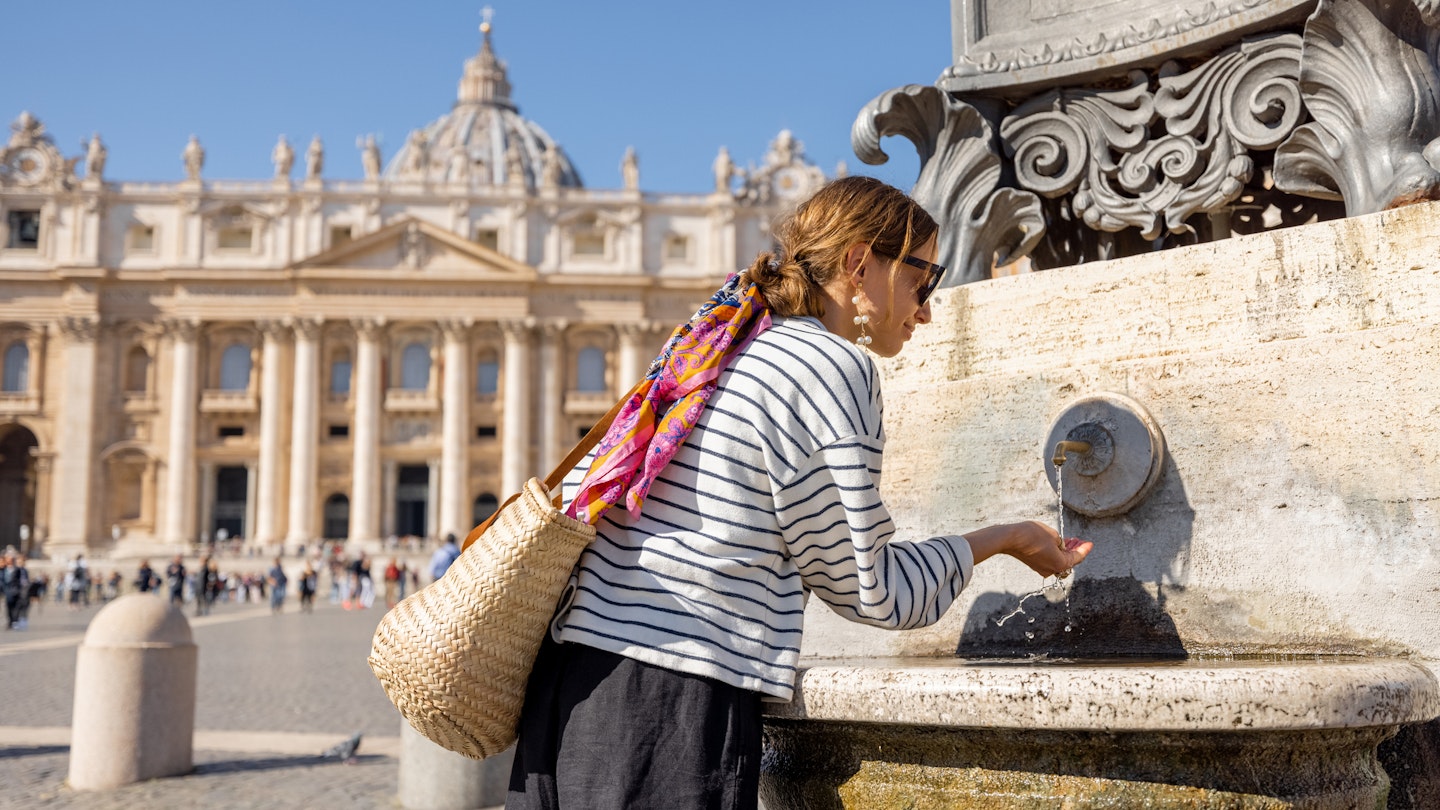
Here are the best things to see and do on visit to Rome © RossHelen / Getty Images
One thing every Roman and visitor can agree on is that there is no shortage of things to do in Italy's charismatic capital.
The biggest challenge on a trip to Rome will be discerning your must-see sights, while also accepting it's impossible to fit everything into one vacation. There may be historical monuments, museums and ancient sites around every corner but there's more to this city than standing in the long lines often required to view them up close.
The Eternal City is massive, endlessly entertaining and some of your best times will involve wandering down random streets and watching the world go by with an espresso in hand. Get planning now with our ten favorite experiences in Rome.
1. Lose yourself in Ancient Rome (but not all in one day)
Any Italian will tell you how downright anarchic Rome is and immediately after, every one of them will say, “but Rome is Rome.” There is simply no place like it in the world, and the only thing to do is abandon yourself to all of its chaotic charms. Even though you are extremely likely to meet hordes of people at any moment, how could you possibly skip the very sites that make the city extraordinary?
It would be bananas to visit Rome and not stand in front of the Colosseum , even though you’ll be one in a sea of gladiators-in-training. You must stand underneath the dome of the Pantheon even though you’ll wait in a considerable line ( one you’ll now pay for , fyi). And though you’ll be surrounded by cameras, souvenir sellers and tour groups, it would be almost unthinkable not to witness the singular beauty of the Trevi Fountain .
So don’t. Take it all in and let the experience find you. Touch the walls of ancient buildings and think about how they’ve been standing for millennia, or fix your eyes on the impossibly intricate carvings of marble and statues. Wander around the major sights, stumble across the minor ones and remember that you only have to move one or two streets over to find yourself in a calm corner of the capital.
Planning tip: When you make your plans in Rome, space out the heavy hitters and give yourself time to soak everything in at a pace that suits you. If you’re only in Rome for three days, think about dedicating a half day to the Colosseum, Palatine Hill and Forum , and then leave yourself the rest of the afternoon or evening to stroll through other parts of town that are a little less trafficked. Plus, that leaves you plenty of time to…
2. Learn the subtle art of the aperitivo
Don’t call it happy hour, because the aperitivo is so much more than a discount drink after a day at the office. And trust me, there is a science to doing it right: the aperitivo is a pre-dinner drinks ritual meant to whet the appetite, not satiate or drown it in cheap booze. Though one can probably find evidence of such imbibing throughout human history, the modern aperitivo dates back only a couple of centuries to the popularization of vermouth and other herbal drinks in the late 1700s.
Since then, Italians have been unwinding with friends and beverages before settling in for dinner and doing so in ever more creative ways. These days, the aperitivo is increasingly varied and always accompanied by snacks, which have also become more elaborately prepared for pairing. Just don’t fill up on any of it – after all, it is but a prelude of what is to come at dinner.
Local tip: Rome is one of the best cities in Italy to sample a wide range of aperitivi , as every bar does things slightly differently and there are far worse ways to spend one’s time than sampling them all. If you’re in the market for luxury, try snagging a spot on the coveted rooftop of Terrazzo Borromini overlooking Piazza Navona . If your tastes run trendier, check out the mixology at Freni i Frizioni in Trastevere . For a classic Roman moment, head over to Ai Tre Scalini in Monti, where the vine-covered streets provide a beautiful backdrop for the most poetic of aperitivi .

3. Spend a day in the Vatican City
Whether you go as a tourist or a pilgrim, the impact of seeing the Vatican for the first time is hard to overstate. From the outside, this half-kilometer-square city-state is dwarfed by the imposing dome of St Peter’s Basilica and framed by the long embrace of Bernini’s square: this alone is enough to make it worth the trip, but once you step inside the Vatican buildings you cannot help but be taken aback.
Start at the Vatican Museums , a complex of 26 structures that spans 7km (4.3 miles) of halls and galleries. While you could spend an eternity craning your neck to see it all, a few hours is enough to get a sense of the unparalleled catalog that the Museums contain. Finish by heading through the claustrophobic staircase (you’ve been warned, but it’s worth it) to the Sistine Chapel , still breathtaking no matter how many people are there sharing the view.
After you’ve hopefully stopped for lunch and a refresh, the Dome awaits. St Peter’s Basilica is a marvel of engineering, architecture, and sheer will: after all, it took more than a century to bring into being and it passed through the hands of many of Italy's most iconic figures along the way. Everything about the Basilica is imposing, so don’t be surprised if the sheer scale of it is overwhelming on the first visit. That’s just another reason to come back.
Planning tip: A dress code is still enforced pretty strenuously. To be safe, wear pants or skirts that cover your knees and tops that cover your shoulders. When in doubt, bring a light scarf with you (it's always worth having a scarf in Rome !).

4. Work your way through Rome’s museums
Although the Vatican Museums are amongst the largest in the world, they are far from the only ones to visit in Rome. What’s more, many of the city’s most interesting museums are slightly off-piste for most visitors, so you may find yourself enjoying an unexpectedly peaceful afternoon in even the busiest periods of the year. In a city overflowing with history and culture, there’s a museum for everyone.
If you can’t get enough of Ancient Rome, the Capitoline Museums on the Campidoglio offer that and more, with works dating from the 3rd century BCE to the 17th century. For an even deeper dive into historical artifacts, the National Roman Museum houses a priceless collection in four separate buildings around the city, each a work of art in its own right.
Classical art lovers are spoilt for choice as well: from the Galleria Borghese to Palazzo Colonna , there are majestic collections around just about every corner. But there’s always space for more, and modern art has a well-established place in Rome. The National Gallery and MAXXI have incredible collections from contemporary artists, all of which are worth seeing.
Local tip: If you like to hunt around, go on the lookout for Rome’s eight “ small museums ”, each of which is located around the city and some in the strangest places. Oh and bonus, they’re all free to enter !
5. Head underground to discover hidden history
Hiding in (almost) plain sight next to the Colosseum, the Domus Aurea is one of the most enigmatic and least explored remnants of Ancient Rome. The sprawling complex was built sometime after the fire of 64CE that destroyed much of the city, under the order of Emperor Nero.
Over time it was buried and remained undiscovered until the Renaissance when intrepid artists like Ghirlandaio and Raphael did their version of urban spelunking to witness the painted “underground grottoes”. You don’t have to be nearly as athletic to get there today: the Domus Aurea underground tour offers an incredible chance to tour some of the ancient palace. It maintains a cool and constant underground temperature, making it the perfect place to escape the Roman sun.
Local tip: The Domus Aurea is also home to a cat sanctuary – if you’re a cat lover, try to spot the friendly felines hanging out among the complex.

6. Take in the views from the city's hills
It’s easy to forget the sheer scope of the city when you’re shuffling through jampacked cobblestone alleys, and it makes all the difference to remind yourself of it now and then. Greater Rome covers nearly 500 sq miles, though the vast majority of its most well-known sites are located within a much smaller area of about five sq miles. Luckily, there are a few key points around the city center where you can get a sense of where you are and admire the beauty of this ever-expanding metropolis.
Climb up the Janiculum Hill for one of the most impressive panoramas you’re likely to see and if you time it right, you may be there for the cannon shot that fires every day at noon (don’t worry, they’re blanks). If you’re wandering during the golden hour (right before sunset), make your way to the Giardini degli Aranci on the Aventine Hill for a perfectly framed picture that no camera could ever capture. Enjoy the walk back down through the frequently overlooked Rose Garden , which offers its own unique perspective on the neighboring Palatine Hill.
Detour: If you’ve got the time and a bus map, head to Parco Mellini in Monte Mario outside of the city center for a dramatic view that stretches far beyond the Aurelian walls.
7. Shop sustainably in Rome's secondhand stores
Though you’ll find every designer in the world has a shop somewhere in the city, Rome has a fabulous thrift shop and market culture where you can find clothing, antiques and just about anything else you could imagine. The Mercatino dell’Usato chain has stores all over the city, and many are an adventure in themselves for people who love scouting out finds. If you’re near the Aventino, check out tiny Affare Fatto , a thrift store that often has eclectic furnishings left behind by diplomats leaving for their next mission.
But the open-air markets are an entity unto themselves, and if you are soothed by the chaos of commerce, this could be the itinerary for you. The market at Via Sannio near San Giovanni has a bustling vibe and is open almost all week with antiques, jewelry, clothing and small independent producers alongside vintage sellers. Time it right to find the ecosolidale market open on Via del Porto Fluviale in Ostiense and you may just get the couture purchase of a lifetime.
If you’re in town on Sunday you cannot miss the mind-boggling Porta Portese market, which takes over the district just south of Trastevere with kilometers of curios. Don’t be surprised if you find a famous designer rummaging along next to you. If you need to keep up on secondhand Rome, black-belt-level thrift shopper Desirée at the Pewter Thimble has you covered.

8. Experience the best of Rome’s many parks
Rome has a lot of parks. In fact, Rome has the most hectares of greenery in Europe and each of its parks serves an important historical, cultural and natural purpose for citizens and travelers alike. Though it may not be the first thing that you think of when you start filling out your wishlist of things to do in the city, you don’t want to miss the chance to wander through some of the most beautiful urban oases in the world.
The most famous park in Rome is undoubtedly Villa Borghese , and with good reason. Covering 80 hectares (197 acres) of the Pinciano district in the city center, the park has boating, tons of trails, theaters, and of course the Galleria Borghese Museum. But other green spaces abound in the city, and each one provides a refuge from the heat of the summer or the occasional winter gray. Check out the intimate Villa Celimontana near the Colosseum or the Parco del Colle Oppio for a different view of the iconic stadium (that also includes a skate park).
Detour: For those looking for less manicured nature, sign up for a bike tour of the Parco della Caffarella , one of the most untouched areas in the city. And while you’re there, take a walk back in time along the Appia Antica , a site so inspiring that it will put to rest any rumors of Rome’s impending demise.
9. Taste local produce at Rome's incredible markets
It wouldn’t be a Roman holiday without copious amounts of food, the quality of which will leave you pining for its equal once you’ve returned home. And while you could spend a lot of time (and money) sampling restaurants around the city, make better use of both by getting to know the food markets all over Rome.
If you’re coming and going from Termini station, you’ll be spoilt for choice at the Mercato Centrale , which brings together chefs and producers from all over Italy under one postwar roof. Steps away, the Nuovo Mercato Esquilino is a feast for cooks looking for more niche fruits, vegetables, and proteins; you’ll find halal butchers selling alongside pig farmers from the Roman countryside, and fresh fish from the Adriatic.
If you start to get peckish as you head towards the Tiber, make a detour to the Mercato Testaccio for local cheeses, cured meats, veggies, and wines that would make any picnic rival a fine dining experience. Should you be further north near the Vatican, the Mercato Trionfale is the largest in Rome and guaranteed to have something for everyone. For weekend warriors braving the crowds at the Circo Massimo , the nearby Campagna Amica market is a fantastic place to test out your Italian, since you won’t go wrong with whatever you wind up buying.
Local tip: Aperitivo starts at lunchtime on Saturdays and Sundays, meaning you should too.
10. Eat out at Rome's best restaurants
For every majestic monument or glittering tribute reaching up to the heavens, everyone knows that the real reason we come to Rome is to eat. But Roman food, once religiously tethered to the traditional “quinto quarto” philosophy of using every part of an animal, has undergone something of a renaissance in recent years.
Young chefs are reinterpreting the classics, resulting in the explosive flavors of Santo Palato in San Giovanni and the home-style goodness of Romanè in Prati. Vegetarians and vegans are also well served in the capital: from the picturesque Mater Terrae in Piazza Navona and the stealthily innovative Rifugio Romano near Termini Station to the irrepressibly lovable Romeow Cat Bistrot in Ostiense, there is no shortage of meatless options in the Eternal City.
Of course, if you’re in search of the classics, they’re right there too. Reserve early and often at Armando al Pantheon , and hope that someone cancels at Felice a Testaccio so that you can get your cacio e pepe (pasta dish with cheese and pepper) done just the way you dreamt of it. Nothing will ever taste quite like the bread from Antico Forno Roscioli , and no one will ever be able to convince you that the slabs of pizza from Gabriele Bonci’s Pizzarium aren’t crumbs sent to lead you straight to heaven.
Local tip: Ever wondered why Italians gasp when you order a cappuccino after a meal? They normally drink coffee after eating as a tool for digestion, as the acidity and caffeine help to speed up the process. By now they’re pretty used to non-Italians asking for milky beverages after a meal but if you want to do like the Romans, skip the dairy (or try a macchiato).
This article was first published Sep 11, 2015 and updated Feb 29, 2024.
Explore related stories
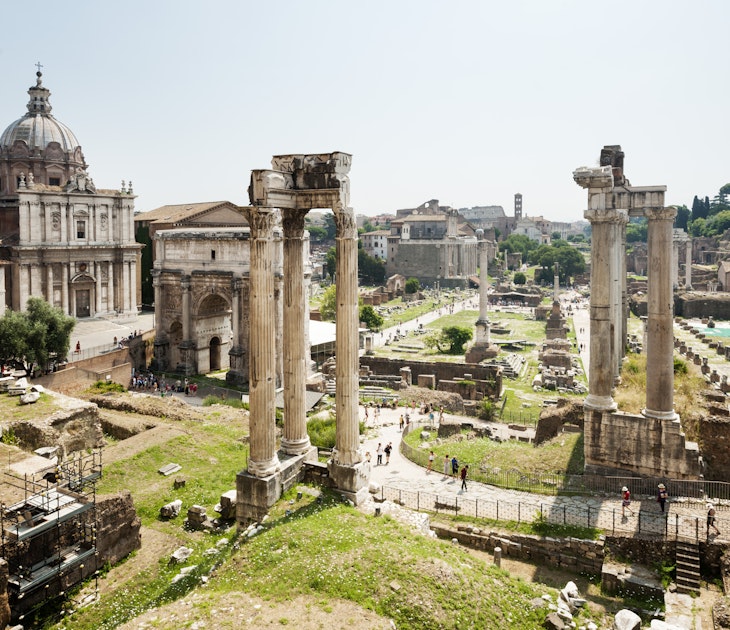
Apr 19, 2024 • 4 min read
A new walkway will make it easier to navigate Rome's ancient sites. But what does it mean for the locals?

Feb 27, 2024 • 6 min read

Feb 19, 2024 • 7 min read

Jan 11, 2024 • 8 min read

Jan 3, 2024 • 4 min read

Oct 17, 2023 • 10 min read

Jan 2, 2023 • 12 min read
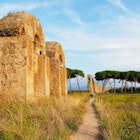
Feb 28, 2022 • 5 min read

Sep 18, 2020 • 6 min read

Aug 9, 2020 • 4 min read

IMAGES
VIDEO
COMMENTS
4. From Rome to Tivoli by Car View of Tivoli, Italy. The short drive from Rome to Tivoli takes only about 35 minutes under the best of conditions but can take twice that when the traffic is heavy. The fastest route is on the A24, which you can reach from the Tangenziale Est/Circonvallazione Tiburtina in Rome.Follow A24 to Via Maremmana Inferiore/SP51a in Tivoli, taking the exit toward Tivoli.
The FL2 Trenitalia regional trains to Tivoli depart approximately every hour from Roma Tiburtina and Roma Termini. You can also take any train headed to Avezzano. The average price per ticket is 2.60-3 euros one-way. This is the cheapest and most convenient way to reach Tivoli in 47-70 minutes (depending on the train).
Tivoli is located 27km (as the crow flies) from the center of Rome. Villa d'Este is in the center of the modern town, whereas Villa Adriana is located on the outskirts. For complete information about visiting these incredible sites, keep reading!
How to get from Rome to Tivoli on your own. Tivoli is a small town 24 km northeast of Rome, with a population of about 60,000. The road connecting it to Rome is still called Via Tiburtina. It is also the name of the second most important train station in Rome: it is from Roma Tiburtina that most trains to Tivoli depart. From Rome to Tivoli by train
Tivoli is one of the most popular day trips from Rome thanks to its proximity to the capital and its two UNESCO World Heritage sites: Villa d'Este and Villa Adriana. Nestled in the Sabine Hills and famed for its healing springs, the town became a popular residential and resort area when wealthy ancient Romans like Hadrian, Maecenas, and Augustus began building villas in the countryside.
Barely 40 minutes by train from Rome's Termini station and just a few minutes longer by bus, Tivoli — home to 55,000 year-round residents — has long attracted day trippers who come to see its ...
Visit the historic vacation homes of the Roman elite on a Rome to Tivoli day trip. The full-day guided excursion includes tours of Tivoli's two UNESCO-listed sites: Hadrian's Villa and Villa d'Este. Hear Renaissance and Ancient Roman history and scandal, admire archaeological ruins and explore some of Italy's most extravagant private gardens.
How to get from Rome to Tivoli. Tivoli is located only 30 kilometers (19 miles) from Rome, making it the perfect day trip. Unless you have your own vehicle, the best way to get from Rome to Tivoli is either by train or bus. A train departs from Rome's Tiburtina rail station almost hourly for about an hour-long journey.
To avoid traffic jams you can choose to travel by train. The journey takes 1 hour and the ticket costs about 3 euro. Trains to Tivoli leave from Roma Tiburtina station, but there are frequent delays on this line. What to see in Tivoli? Tivoli is a nice town located on the Tiburtini mountains, just 30 Km away from Rome.
What companies run services between Rome, Italy and Tivoli, Italy? Cotral operates a bus from Roma, Autostazione Tiburtina to Tivoli Piazza Garibaldi every 2 hours. Tickets cost $2-3 and the journey takes 47 min. Alternatively, Trenitalia operates a train from Roma Tiburtina to Tivoli hourly. Tickets cost $4-8 and the journey takes 1h 2m.
By train, catch a direct train on the Roma-Pescara Line from Rome's Tiburtina station to Tivoli. It takes about a half hour. ... If you'd like to visit Villa d'Este in Tivoli, pin it for later. Categories Italy, Rome, UNESCO Tags ITALY, rome, UNESCO. One Day In Paris: Seven Sample 1 Day Itineraries.
Visiting Villa Gregoriana. Villa Gregoriana is basically a 400-foot deep gorge in the middle of Tivoli. To explore it, you start at the top, hike all the way down to the bottom, then hike back up on the other side. The paths are a mixture of natural dirt paths and some constructed walkways and staircases.
There are several ways of getting to Villa d'Este: Guided tour : This is the easiest option. It includes a hotel pick-up, transport there and back, guided tour in English and admissions tickets. The price per person is € 119 ( US$ 129.50) and can be booked here: Villa Adriana and Villa d'Este Excursion. Bus: The buses that travel from Rome ...
This is just the beginning and Rome has so much more to offer than these well-known attractions. Tivoli is a great base from which to explore Rome and travel into the centre. 14. Enjoy a drink at Flo's cafe and bistro Source: Hakan Tanak / shutterstock Cocktail. Flo's cafe and bistro is located on the Via Ponte Gregoriano; only a short walk ...
Discover the Thermae, the Villas, the monuments in Tivoli. When visiting Rome a day trip to the surrounding towns and regions is a must. One such place that is well worth a slice of your travel time is Tivoli.Tivoli is a pristine mountain town shrouded in native bush, cascading waterfalls, exquisite gardens and historical sites.
Day Trips from Rome. Although Rome is a city with enough things to see and do to keep you busy for months, even years, many travellers make time to visit some of the country's main attractions, such as Pompeii, Herculaneum or Tivoli. Rome is also relatively close to Florence, the centre of Italian Renaissance.
The visit starts from the rooms on the main floor featuring family crests and mythological scenes, linked to the origins and history of the city of Tivoli. On the lower floor there is the most sumptuous setting, the Salone della Fontana , used for parties and banquets, frescoed by Girolamo Muziano and decorated with a real rustic-style fountain.
Read on to get the low-down on what you need to see at the 3 Tivoli villas: 1. Hadrian's Villa: The Wandering Emperor's Countryside Retreat. Nestled idyllically in the rolling Lazio countryside, Hadrian's Villa is the largest and most spectacular villa of the entire ancient Roman world.
The main Villa d'Este building is open from 08:30 - 19:45 every day except Monday, when it opens at 14:00 instead. You can access Tivoli Gardens from 08:30 but the gardens close at different times during the year: January, November and December: 16:45. February: 17:15.
Tivoli is the Best Day Trip From Rome, Italy. by kitcatfilms on August 13, 2020. I absolutely fell in love with the little town of Tivoli in Italy. It's just about 30 minutes outside of Rome making it a great day trip. You will see beautiful homes, cute streets, and gorgeous gardens. It's definitely a trip worth taking and I can't wait to ...
Take the Roma-Pescara Line to Stazione Tivoli, and walk across the bridge to the center of town. There are many street signs pointing the way to the villa. Address: Piazza Trento, 5, 00019 Tivoli, Province of Rome, Italy. Visiting the Villa and Gardens. Visiting Hours are from 8:30 a.m. until one hour before sunset.
Here are the very best places near Rome to visit on a day trip - and how to get there. 1. Explore the ancient ruins at Ostia Antica. Travel time: 30 mins. One of the easiest outings from Rome is a day trip to the Scavi Archeologici di Ostia Antica, the remarkably well-preserved ruins of ancient Rome's seaport.
Tivoli, a little less than an hour away from Rome, is a charming town that offers a delightful escape. Like Rome, Tivoli boasts a rich history, which you can find at attractions like the stunning Temple of the Sybil and the ancient Hadrian's Villa.A key difference is that Tivoli offers a more tranquil and less crowded atmosphere compared to the bustling streets of Rome.
Travel guide of Rome with up to date tourist and general information on the city: accommodation, transport, maps, activities and top attractions. Civitatis Rome. Travel Guide ... Visit the two treasures of Tivoli on this day trip: Hadrian's Villa, Roman Emperor's retreat, and Villa d'Este, a Renaissance mansion with magnificent gardens. ...
From Villa Borghese to the Appia Antica, Rome has many green open spaces to enjoy ©spooh/Getty Images 8. Experience the best of Rome's many parks Rome has a lot of parks. In fact, Rome has the most hectares of greenery in Europe and each of its parks serves an important historical, cultural and natural purpose for citizens and travelers ...